

The Elegant and Sophisticated Woman
Who is the elegant sophisticated woman?
People often mistake sophistication for
elegance. While it is possible to be both, you can be sophisticated without being elegant and elegant without being sophisticated.
Elegance as we know is graciousness in action, and possessing a certain confident simplicity.
Sophistication comes from a great deal of worldly experience and knowledge of art and culture.
It comes from an in-depth learning about the world, its people and having an
refined understanding of different cultures. It is also about being comfortable with differences, luxury and anywhere you go, and in whatever situation.
However, sometimes sophistication can be vulgar. (It’s true.)
We’ve all seen it before.
This happens when there is an over-emphasis on materials and luxury goods. It is too much value placed on the high life. There is too much aspiration, and a sort of greed to want it so badly. This creates all kind of “trying-too-hard” behavior – making certain associations because of their stature, namedropping, keeping up with appearances that do not truly reflect the real circumstances
Read More https://elegantwoman.org/elegant-sophisticated/
October 17th 2022
Cops: Alabama Woman Stabbed Her Vagina to Claim Self-Defense
OUCHTracy ConnorPublished Nov. 26, 2020 2:20PM ET

When Linda Doyle shot her husband dead last year, she claimed she was protecting herself against sexual violence. But now police have charged the 66-year-old with murder—and say she stabbed herself in the vagina with a butcher knife to make it look like self-defense. “Based on the evidence that has been recovered at this time, we don’t believe that Mr. Doyle inflicted those [wounds],” prosecutor Patrick Doggett said, according to WKRG. Her defense lawyer, however, says the evidence will show his client was the victim. “It’s a tragic situation all the way around but the tragedy is only compounded at this point by trying to charge her with a homicide,” John Furman told the TV station.
Prosecutors say her injuries were self-inflicted and that it was all a ploy to get away with murder.
On the night of her husband’s death Doyle, 66, called 911 and said they had gotten into a fight, investigators told WKRG.
When police officers arrived they found the married couple laying sprawled across the floor of their home.

James Doyle was pronounced dead at the scene (
Man Gets Penis Cut Off—And Lives!
![]() by Madeline HallerPublished: Jul 14, 2011
by Madeline HallerPublished: Jul 14, 2011
Media Platforms Design Team
Ending a marriage can be messy—you’ve got the lawyers, the divorces papers, the court fees. Next thing you know you’re dividing up you’re possessions. She gets to take the car, the new flat screen . . . your penis.
That’s how it went down for one California couple this past week. On Monday evening, Catherine Kieu Becker, 48, was arrested for cutting off her estranged husband’s penis and tossing it into the garbage disposal.
According to the police reports, after lacing her husband’s dinner with an unknown drug (or poison), Mr. Becker went to lie down, believing something was wrong with the food. While her husband was asleep, Becker tied him to the bed, allegedly waking him by attempting to tug off his clothes.
She then took a knife, cut off his penis, called 911 to inform them of the situation, and then chucked the dismembered member into the garbage disposal.
So what inspired Mrs. Becker to play butcher with her husband’s meat? Not quite sure, though the couple was in the process of sorting through a divorce. Becker was booked into Orange County jail, arrested on numerous charges including aggravated mayhem, false imprisonment, and assault with a deadly weapon.
As for Mr. Becker, emergency relief arrived to the scene in time to rush the husband to the hospital for immediate surgery.
At this point you may be wondering, how could anyone survive that without bleeding to death? We found a brave doctor to speak on the record. (Apparently, “Will you stop treating patients to talk to us about severed penises” isn’t a great interview opener.)
When blood vessels are cut across—and they’re actually severed in a situation like this—they begin to experience extreme spasms, explains Reza Nabavian, M.D., specialist in cosmetic plastic surgery and a Clinical Assistant Professor of Surgery at USC-Keck School of Medicine. That causes the muscles around the vessels to tighten and constrict around the openings in the vessels.
And although not everyone is fortunate enough to have this happen, this may have been the case for the husband considering he made it out alive, Dr. Nabavian speculates.
So what’s up next for Mr. Becker? It depends on if the penis is available to reattach. (How’d you like to be that plumber?) If it is, surgeons will have to act quickly in order to reconstruct the nerve endings, arteries, and veins while piecing the erectile tissue back together.
But if his member is not usable after its trip down the drain, there are other options. “Once the area heals, he’s going to need a complex surgery—using microsurgery to bring some skin and muscle to that area of the body,” says Nabavian. Then a penile prosthetic can be incorporated so he can regain some usage of that area.
According to Nabavian, depending on what happened to the man’s testicular region, sexual functioning may be out of the question. He should be able to urinate, though, since most likely that muscle was not infected in the attack.Madeline HallerI’m the social media editor for Cosmopolitan.com, as well as a self-proclaimed expert on Internet cats (tough job, but hey, someone has to do it). I’m from the Midwest and a proud Indiana University alumna. My obsessions — in no particular order — include running, writing, coffee, red lipstick, and margaritas.
More From Men’s Health
Tenoch Huerta | Train Like
Current Time 2:07Remaining Time -2:27
September 28th 2022
Many hunter gatherers have a long history of egalitarianism. DevonJenkin Photography/Shutterstock
How did the patriarchy start – and will evolution get rid of it?
Published: September 20, 2022 6.06am BST
Author
- Ruth Mace Professor of Anthropology, UCL
Disclosure statement
Ruth Mace is Professor of Evolutionary Anthropology at UCL, and has a visiting position at Institute of Advanced Study in Toulouse (IAST). She is Editor-in-Chief of the Cambridge University Press journal Evolutionary Human Sciences. She currently receives funding from the ERC (Advanced Grant EvoBias).
Partners
University College London provides funding as a founding partner of The Conversation UK.
The Conversation UK receives funding from these organisations
 We believe in the free flow of information
We believe in the free flow of information
Republish our articles for free, online or in print, under Creative Commons licence.
Email Twitter32 Facebook263 LinkedIn Print
READER QUESTION: Many people assume the patriarchy has always been there, but surely this isn’t the case? How did it really originate? Matt, 48, London.
The patriarchy, having been somewhat in retreat in parts of the world, is back in our faces . In Afghanistan, the Taliban once again prowl the streets more concerned with keeping women at home and in strict dress code than with the impending collapse of the country into famine.
And on another continent, parts of the US are legislating to ensure that women can no longer have a legal abortion. In both cases, lurking patriarchal beliefs were allowed to reemerge when political leadership failed. We have an eerie feeling of travelling back through time. But how long has patriarchy dominated our societies?

This article is part of Life’s Big Questions
The Conversation’s series, co-published with BBC Future, seeks to answer our readers’ nagging questions about life, love, death and the universe. We work with professional researchers who have dedicated their lives to uncovering new perspectives on the questions that shape our lives.
Join our readers who subscribe to free evidence-based news
The status of women has been a long-standing point of interest in anthropology. Contrary to common belief, research shows that the patriarchy isn’t some kind of “natural order of things” – it hasn’t always been prevalent and may in fact disappear eventually. Hunter-gatherer communities may have been relatively egalitarian, at least compared to some of the regimes that followed. And female leaders and matriarchal societies have always existed.
Male wealth
Reproduction is the currency of evolution. But it is not only our bodies and brains that evolve – our behaviours and our cultures are also products of natural selection. To maximise their own reproductive success, for example, men have often tried to control women, and their sexuality.
In nomadic societies where there is little or no material wealth, as was the case with most hunter gatherers, a woman cannot easily be forced to stay in a partnership. She and her partner may move around together with her relatives, his relatives, or other people entirely. If unhappy, she can walk away.
That could be at a cost if she has children, as paternal care helps children’s development and even survival, but she can go and live with relatives elsewhere or find a new partner without necessarily being worse off.
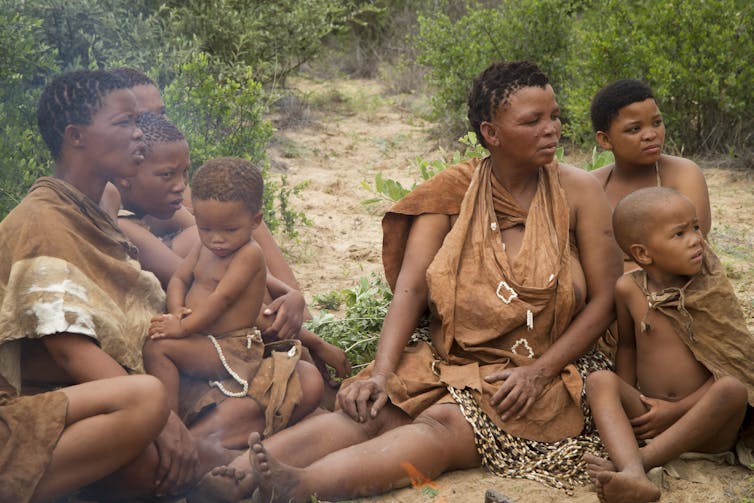
The origin of agriculture, as early as 12,000 years ago in some areas, changed the game. Even relatively simple horticulture necessitated defending crops, and thus staying put. Settlement increased conflict within and between groups. For example, the Yanomamo horticulturalists in Venezuela lived in heavily fortified group households, with violent raids on neighbouring groups and “bride capture” being part of life.
Where cattle-keeping evolved, the local population had to defend herds of livestock from raiding, leading to high levels of warfare. As women weren’t as successful as men in combat, being physically weaker, this role fell increasingly to men, helping them gain power and leaving them in charge of the resources they were defending.
As population sizes grew and settled, there were coordination problems. Social inequality sometimes emerged if leaders (usually male) provided some benefits to the population, perhaps in warfare or serving the public good in some other way. The general population, both male and female, therefore often tolerated these elites in return for help hanging on to what they had.
As farming and herding became more intensive, material wealth, now mainly controlled by men, became ever more important. Rules of kinship and descent systems became more formalised to prevent conflict within families over wealth, and marriages became more contractual. The transmission of land or livestock down the generations allowed some families to gain substantial wealth.
Monogamy vs polygamy
Wealth generated by farming and herding enabled polygyny (men having multiple wives). In contrast, women having many husbands (polyandry) was rare. In most systems, young women were the resource in demand, because they had a shorter window of being able to produce children and usually did more parental care.
Men used their wealth to attract young women to the resources on offer. Men competed by paying “bridewealth” to the family of the bride, with the result that rich men could end up with many wives while some poor men ended up single.
So it was males who needed that wealth to compete for marriage partners (whereas females acquired resources needed to reproduce through their husband). If parents wanted to maximise their number of grandchildren, it made sense for them to give their wealth to their sons rather than their daughters.
This lead to wealth and property being formally passed down the male line. It also meant women often ended up living far away from home with their husband’s family after marriage.
Women began to lose agency. If land, livestock and children are the property of the men, then divorce is almost impossible for women. A daughter returning to mum and dad would be unwelcome as the brideprice would need to be returned. The patriarchy was now getting a firm grip.
When individuals disperse away from their natal home and live with their new husband’s family, they do not have as much bargaining power within their new household than if they had stayed in their natal home. Some mathematical models suggest that female dispersal combined with a history of warfare favoured men being treated better than women.
Men had the opportunity to compete for resources with unrelated men through warfare, whereas women only competed with other women in the household. For these two reasons, both men and women reaped greater evolutionary benefits by being more altruistic towards men than towards women, leading to the emergence of “boys’ clubs”. Essentially, women were playing along with the gender bias against themselves.
In some farming systems, women may have had more autonomy. Where there were limits on the availability of farmland, this may have put the brakes on polygyny, as men couldn’t afford multiple families. If farming was hard and productivity was determined more by the work put in than by how much land was owned, then women’s labour became a key requirement and couples worked together in monogamous unions.

Under monogamy, if a woman marries a rich man, all his wealth goes to her offspring. So women then compete with other women for the best husbands. This is not true of polygyny, where the family wealth is shared between numerous other wives offspring, so the advantages to women of marrying a rich man are marginal.
Thus marriage payment under monogamy is in the opposite direction than it is under polygyny and takes the form of “dowry”. The parents of the bride give money to the parents of the groom, or to the couple themselves.
Dowry, which is still important in much of Asia today, is the parents’ way of helping their daughters compete with other women on the marriage market. Dowry can sometimes give women more agency and control over at least part of their family wealth.
But there is a sting in the tail. Dowry inflation can make girls expensive for parents, sometimes with dire consequences, such as families which already have daughters killing or neglecting female babies (or now female-selective abortion).
There were other consequences of monogamy too. As wealth was still passed down the male line to children of one wife, males did all they could to ensure that those children were theirs. They did not want to unwittingly invest their wealth in the offspring of another man. So women’s sexuality became strongly policed as a result.
Keeping women away from men (purdah), or placing them in religious “cloisters” such as monasteries (claustration) in India, or 2,000 years of binding women’s feet to keep them small in China, may all be the results of this. And in the current context, banning abortion makes sexual relationships potentially costly, trapping people in marriages and hindering women’s career prospects.
Matriarchal societies
It is relatively rare for wealth to be passed down the female line, but such societies do exist. These female-centred systems tend to be in somewhat marginal environments where there is little wealth to physically compete over.
For example, there are areas in Africa known as the “matrilineal belt” where the tetse fly made it impossible to keep cattle. In some of these matrilineal systems in Africa, men remain a powerful force in households, but it is older brothers and uncles who try to control women rather than husbands or fathers. But in general, women do have more power.
Societies with an absence of males for much of the time, due to long distance travel or high mortality risks, for example due to dangerous ocean fishing in Polynesia, or warfare in some Native American communities, have also been associated with matriliny.
Women in matriarchal system often draw on the support of their mothers and siblings, rather than their husbands, to help raise children. Such “communal breeding” by women, as seen for example in some matrilineal groups in China, makes men less interested (in an evolutionary sense) in investing in the household, as the households include not only their wife’s children, but many other women’s children to whom they aren’t related.
This weakens marriage bonds, and makes it easier to pass down wealth between female relatives. Women are also less controlled sexually in such societies as paternity certainty is less of a concern if women control the wealth and pass it to their daughters.

In matrilineal societies, both men and women can mate polygamously. The matrilineal Himba of southern Africa have some of the highest rates of babies produced in this way.
Even in urban settings today, high male unemployment often sets up more female-centred living arrangements, with mothers helping daughters to raise their children and grandchildren, but frequently in relative poverty.
But the introduction of material wealth, which can be controlled by men, has often pushed matrilineal systems to change to patrilineal ones.
The role of religion
The view of patriarchy I have outlined here may appear to downplay the role of religion. Religions are frequently prescriptive about sex and the family. For example, polygynous marriage is accepted in Islam and not in Christianity. But the origins of diverse cultural systems around the world cannot simply be explained by religion.
Islam arose in the year AD610 in a part of the world (the Arabian peninsula) then inhabited by nomadic pastoralist groups where polygamous marriage was common, whereas Christianity emerged within the Roman empire where monogamous marriage was already the norm. So while religious institutions definitely help to enforce such rules, it is hard to make the case that religions were the original cause.
Ultimately, the cultural inheritance of religious norms, or indeed of any norms, can maintain harsh social prejudices long after their original cause is gone.
Is patriarchy on its way out?
What is clear is that norms, attitudes and culture have a huge effect on behaviour. They can and do change over time, especially if the underlying ecology or economy changes. But some norms become entrenched over time and are therefore slow to change.
As recently as the 1970s, children of unmarried mothers in the UK were taken from them and shipped to Australia (where they were placed in religious institutions or put up for adoption). Recent research also shows how disrespect for women’s authority is still rampant in European and American societies that pride themselves in gender equality.
That said, it is clear that gender norms are becoming much more flexible and the patriarchy is unpopular with many men and women in much of the world. Many are questioning the very institution of marriage.
Birth control and reproductive rights for women give women, and also men, more freedom. While polygamous marriage is now rare, polygamous mating is of course quite common, and is perceived as a threat by incels and social conservatives alike.

What’s more, men increasingly want to be part of their children’s lives, and appreciate not having to do the lion’s share of providing for their families. Many are therefore sharing or even taking on the full weight of child-rearing and housework. Simultaneously we see more women confidently gaining positions of power in the world of work.
As men and women both increasingly generate their own wealth, the old patriarchy is finding it harder to control women. The logic of male-biased investment by parents is gravely injured if girls benefit equally from formal education and job opportunities are open to all.
The future is hard to predict. Anthropology and history do not progress in predictable, linear ways. Wars, famines, epidemics or innovations are always lurking and have predictable and unpredictable consequences for our lives.
The patriarchy isn’t inevitable. We do need institutions to help us solve the world’s problems. But if the wrong people come to power, the patriarchy can regenerate.
To get all of life’s big answers, join the hundreds of thousands of people who value evidence-based news by subscribing to our newsletter. You can send us your big questions by email at bigquestions@theconversation.com and we’ll try to get a researcher or expert on the case.
More Life’s Big Questions:
- Happiness: is contentment more important than purpose and goals?
- Could we live in a world without rules?
- Death: can our final moment be euphoric?
- Nature: have humans now evolved beyond the natural world, and do we still need it?
- Love: is it just a fleeting high fuelled by brain chemicals?
Information is flying at us from all directions. It can be overwhelming.
Wouldn’t it be easier if you could get trusted science information in one place? That place is The Conversation. As an editor here, I am fortunate to work with scientists and researchers, who break down the latest studies, sometimes their own. And every day our team sends an email which covers the sciences and other news. One email to keep you reliably informed. You don’t have to be overwhelmed any more.
Phoebe Roth
Commissioning Editor, Science + Technology
September 24th 2022
Mother charged with murder of her two children in car fire

Tom Tuite
A mother has been charged with the murder of her children, Mikey and Thelma Dennany, in a car blaze in Co Westmeath.
Thelma (5) and her brother Mikey (2) were fatally injured when their vehicle went on fire at about 4pm on September 9th.
Their mother, Lynn Egar (48), appeared before Judge Bernadette Owens at a late special sitting of Mullingar District Court on Thursday evening.
She did not address the proceedings and, following a five-minute hearing, was remanded in custody to appear again at Athlone District Court via video link on September 28th.
A passerby came across their car engulfed in flames at Lackan, a townland on a rural road linking the villages of Multyfarnham and Coole.
Mikey was rushed by ambulance to the Midlands Regional Hospital Mullingar, but he was pronounced dead there.
Their mother also suffered injuries but was airlifted to a Dublin hospital, where she remained for over a week and a half.
Arrest
Detectives based at Mullingar Garda station commenced an investigation and arrested her on Wednesday.
The children’s mother was detained under section four of the Criminal Justice Act, which allows gardaí to hold an individual for questioning for 24 hours, after which they must be released or charged.
Ms Egar lived at the family’s home in Winetown, Rathowen, Co Westmeath.

Lynn Egar (wearing a purple hoodie) arrives for a special sitting of Mullingar District Court, Co Westmeath, where she was charged with the murder of her two children. Photo: PA
Detective Sergeant David Donnelly told Judge Owens that he charged her with two counts of murder at 7.22pm. “In reply to charge after caution she made no reply,” he said, adding that she was handed a true copy of the charge sheets.
She is accused of the murders of Thelma and Michael Dennany at Lackan, Multyfarnham, on September 9th, contrary to common law.
The district court does not have the jurisdiction to consider bail in murder cases, which only the High Court can consider.
Gardaí applied for a remand in custody to appear at Athlone District Court via video link next Wednesday.
Ireland Video: Gardaí raid six homes over Cherry Orchard i… Read More
Ms Egar, dressed in a purple hooded zipped top, black trousers and navy shoes, leaned forward and bowed her head at the start of the hearing but then turned and faced the judge. However, she remained silent throughout the proceedings.
Defence solicitor Damien Coffey told Judge Owens there was consent to his client appearing by video link at the next hearing. Legal aid was granted after the judge noted the solicitor had shown the investigation team a statement of Ms Egar’s means.
Judge Owens asked Mr Coffey if anything else was required on the remand warrant, but the solicitor replied, “nothing further arises,” and he was granted permission to speak with his client after she was led out of the courtroom. She was remanded to the Dochas Centre, the women’s unit of Mountjoy Prison in Dublin.
The bodies of the two children were returned to the family after gardaí completed the formal identification process. Hundreds of mourners turned out for the children’s funeral service on September 15th at St Mel’s Cathedral before they were laid to rest at Cullyfad Cemetery in Longford.
BondAge by R.J Cook
BondAge
This is a revealing article below about who should be the new James Bond. It is not trivial – though it is inane. James Bond was never about truth or what men are. The first man to act out Ian Fleming’s character was not like the upper class Royal Navy Commander, i.e Fleming, upon which it was based. Bond was never a gruff voiced working class Scot like Sean Connery. There have been some closer to the Fleming model, but then there is the other truth. Fleming casts British intelligence officers as the good guys, licenced to kill for Queen and country – now King again as before 1952.
This is the age of psychological imperialism where Anglo British blatant killing of Reuters journalists in Iraq War 2, has seen the whistle blower Julian Assange jailed for over a decade without trial. That is elite Anglo-U. S Fake Democracy, where the the so called constitutional freedom has been replaced by ‘our freedoms -‘ NOT OUR FREEDOM, WHICH HAS LONG GONE, OUTSIDE THE SUPER RICH CULTURALLY DOMINANT RULING ELITE EXEMPLIFIED BY KING CHARLES III – ASSUMING THERE WAS EVER REAL FREEDOM FOR THE COMMON PEOPLE.
This is the British State where police can place secret PNC Criminal Markers on our cars based on malicious false unverified so called ‘soft intelligence’ leading to blind police chases and police lethal shootings because they perceive a danger to themselves or others.
In the Streatham case – where a 24 year old unarmed expectant father and innocent black man was shot dead at close range by armed police – the investigating female officer said that the officers perceptions leading to shooting do ‘not have to be right.’
My point here being -especially in this age where anti terrorism is used to extend the public space, spy on our internet, bug our phones, monitor our mail, organisations we join and movements – it is bland and superficial to talk about men ‘evolving’ just because they want the new Bond ‘actor’ to be female or any approved member of minority groups like LGBTQI or BLM. This mentality is not about diversity or freedom. It is a smokescreen and a latent tension management exercise because this is not multi culture.
The pontifications of our new King talking down to his subjects conveniently ignore his well earned notoriety in the 1980s and 90s. They conveniently forget his mother paying £12 million to silence the allegations of child rape against his brother Andrew, moaning Prince Harry and the dubious history of his family and the land grabbing intriguing Northampton Spencer family – see ‘A Century of Northampton’ by Robert Cook 1998.
British men have not evolved. It is a misuse of the dubious evolution theory which does not, for example, explain why Elephants never turned into humans. They may have devolved, and havs nmost certainly been suffocated in fermenting feminist Britain where any male identifying as transsexual gets the TERF feminist label of potential rapist by a rabble rouser led by the likes of children’s fantasy writer J.K Rowling, much loved by the extremely liberal political correct.
I may be a transsexual, though U.K police insist I am actually insane, spending the period 1988 – 2008 on a rampage of violent alcohol abuse , child abuse and other domestic violence meriting a PNC Criminal Vehicle Marker and much more. By and large men have been crushed, marginalised and scapegoated by rapid social changes since 1979 when Thatcher and her rich elite cronies set about destroying the social and economic fabric, stirring up riots, terrorism because of Iraq invasions to push up oil prices and expanding the scope and power of the state.
So any realistic update of James Bond would not fixate on the new versions colour , sexual libertarianism, choice of drink or gender. It would fixate on exactly what version of the evolved state the new James Bond represents and defends in this new age of psychological imperialism, where dissidents like me have so called psychiatrists using Blairiete State powers to force access to my home – declaring me a paranoid schizophrenic, bi polar, delusional psychotic long term alcohol abuser with abnormal psychology, ‘not needing hospital yet’ but should be subject to a ‘multi agency approach’ , forced to take anti psychotic drugs if I wanted to complete my sex change surgery and continue to receive hormones that had already sterilised me , changed my brain chemistry and enhanced my natural old fashioned femininity.
I make the last point because people are so bombarded with propaganda that they do not realise just how much common women have been mesmerised and brainwashed by vicious feminist leaders on behalf of a class capitalist system that wants to run their lives, impose extreme physical and social boundaries, frighten them away from men, worship a god which is another brainwashing political construct , for the purpose of social control and wage slavery.
Women by nature don’t thrive in hand to hand combat or jail, so even female doubters keep quiet and the men by and large have no more courage. They have the choice of either obeying the state through the proxy tyranny of their wives or ending up criminalised ,living in a lonely bedsit or more likely dying of alcoholism or drug abuse on the street – possibly victims of street violence , starvation and cold. James Bond will never represent these truths. He will continue to represent the continuation of British hypocrisy and the militaristic war monger posturing we saw from the officers and men of British armed forces at the funeral of our so hard done by self sacrificing value for money queen.
Official figures assert that her funeral cost £5 million with another £50 million for policing London over the period of laying in state and burial. That comes on top of the millions spent on her jubilee. The only evolution I can see here is into a more totalitarian state of bondage than England had under feudalism. So one would hope for an actor ( one mustn’t say or actress because that is officially sexist ) who represents this fake democracy and vicious tyranny with all its gold braided senior police and glittering colourful uniformed public school type upper class senior military officers commanding their men like Wellington.
The sight of their robotic wasteful ritualism in Windsor last Monday, turned my stomach with fear and disgust. At least Wellington had the honesty to call his canon fodder ‘the scum of the earth’ before becoming Prime Minister in an even more absurd version of British Democracy. Then he , as part of a regime, soon becoming Prime Minister, that saw those who survived the Napoleonic War savagery, ended up crippled, begging or in the workhouse.
Elite hypocrisy went on to provoke two world wars and the glories of heroic mass sacrifice. Only the rich elite matter , yet we hear nonsense like Boris Johnson ‘levelling up.’ The reality is epitomised by Truss’s moralising drivel to the U.N, slagging of Russia because they want that country in their psychological empire this unworthy cause, which Anglo U.S led NATO provoked – ignoring human rights abuses of ethic Russians in the Donbas and luring Zelensky toward pleasure bent EU and NATO membership. Any sensible fair minded person , apart from children, would realise that Bond’s gender or race was irrelevant. They would wonder why James Bond should go on. The answer is its ongoing elite propaganda brainwashing money making potential. If it can be fixed to be a woman, black or both, the myth of diversity is sustained, while real inequalities are further smokescreened. The article below is written either by an aspiring so called independent journalist , feminist or other lackey to our pernicious system.
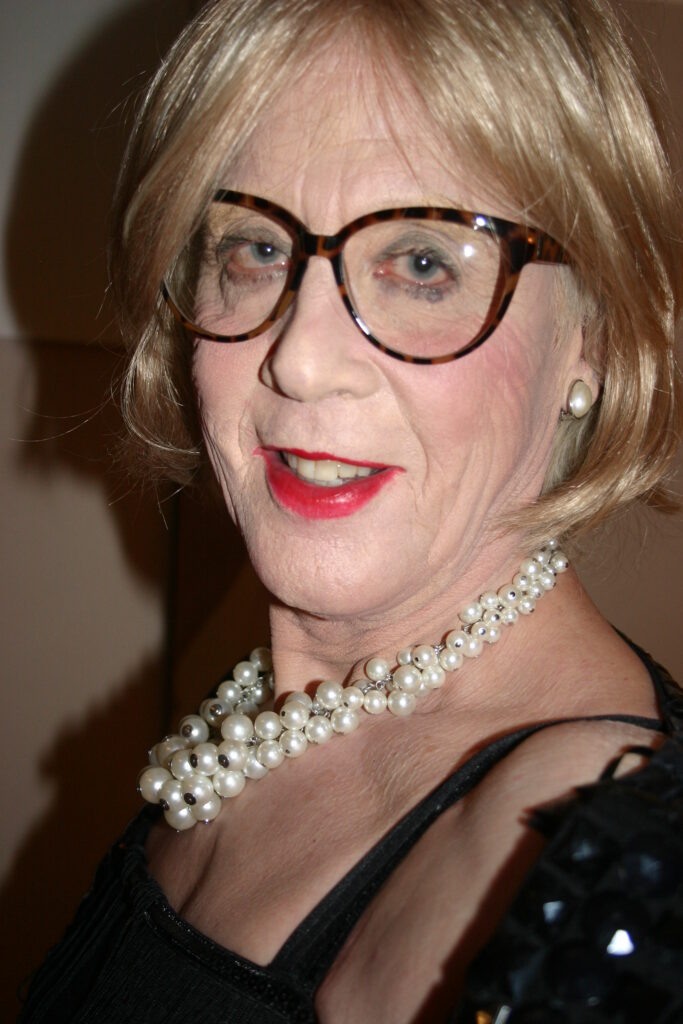
R.J Cook
James Bond Producers Search for a New 007 Who Will Commit for a Decade: ‘Bond Is Evolving as Men Are Evolving’

Landing James Bond may be the biggest acting gig in Hollywood, but 007 producers Barbara Broccoli and Michael G. Wilson say they still have to pitch prospective actors on the part.
When Variety catches up with Britain’s most famous producers in late August, they’re busy preparing for the 60th anniversary of Bond in October. But the search for a new actor to play the world’s most famous spy is quietly rumbling on in the background. It’s still “early days,” they claim, but whomever lands the role has to be in it for the long haul.
For a while, that person seemed to be Idris Elba. But the “Luther” star recently said he didn’t see Bond when he “looks in the mirror” — remarks that some have interpreted as Elba’s valediction to 007.
September 13th 2022
Sister of a boy, 17, who killed himself after being falsely accused of rape by a girl whose mother said ‘I’m going to f****** get him’ breaks down as she recalls the night he was found hanging from a tree they played on as children
- Jay Cheshire killed himself in 2015 after being falsely accused of rape by a girl
- His sister Camellia recalls the ordeal in BBC documentary I Am Not A Rapist
- Told how the accuser’s mother said: ‘I’m going to f****** get him’ on the phone
- Girl dropped the charges but by that point ‘Jay had already spiralled completely’
- He was found hanging from a tree he and Camellia used to play on as children
- For confidential support call the Samaritans on 116123 or visit a local Samaritans branch, or click here for details
By Stephanie Linning For Mailonline
Published: 15:10, 10 September 2020 | Updated: 15:11, 10 September 2020
3.7k shares 156 View comments
A woman whose 17-year-old brother took his own life after being falsely accused of rape tells how he was left ‘a shell of his former self’ following the allegation in a new BBC documentary.
Sixth form student Jay Cheshire, of Southampton, was ‘distraught’ to find himself at the centre of a police investigation when a girl accused him of rape in spring 2015.
The girl dropped the charges after two weeks but by then Jay, who was described as a ‘gentleman’ and ‘intelligent’, had already ‘spiralled completely’.
Comment If women claim equality, they should face maximum punishment for criminal lies, as should lying police officers. Men need chaperones and the police need policing. Sex should be recorded on a ‘black box’ type device, its comntents downloaded after every crash. Sex is not worth jail time and most women need it as least as much as men do – hence the whingeing Viagra advertisements. R J Cook
Believe Her! The Woman Never Lies Myth
Frank S. Zepezauer*
ABSTRACT: Empirical evidence does not support the widespread belief that women are extremely unlikely to make false accusations of male sexual misconduct. Rather the research on accusations of rape, sexual harassment, incest, and child sexual abuse indicates that false accusations have become a serious problem. The motivations involved in making a false report are widely varied and include confusion, outside influence from therapists and others, habitual lying, advantages in custody disputes, financial gain, and the political ideology of radical feminism.
Male sexual misconduct — rape, incest, stalking, sexual harassment, child molestation, pornography trafficking — has, according to some observers, become a problem so big that it demands a big solution, not only the reform of our legal system but of our entire society. Yet the increasingly heated debate over this crisis has focused primarily on how these misbehaviors are defined and how often they occur. The estimated numbers keep mounting. We hear that perhaps 31 million women are suffering from some form of rape, 41 million from harassment, 58 million from child sexual abuse, and all 125 million of them — from toddlers to grandmothers — from a toxic “rape culture” that suffocates the feminine spirit.
Much less discussed is how often an allegation of male sexual misconduct is false. The question seldom enters the debate because, presumably, it had long ago been settled. Pennsylvania State Law Professor Philip Jenkins (1993), in a review of the “feminist jurisprudence” which leads the sex crisis counterattack, reports that in response to the question its proponents have established an “unchallengeable orthodoxy.” It is that “women did not lie about such victimization, never lied, not out of personal malice, not from mental instability or derangement” (p.19).
Jenkins is not the first to cite this will to believe. Wendy Kaminer (1993) reported that “it is a primary article of faith among many feminists that women don’t lie about rape, ever; they lack the dishonesty gene” (p.67). Eight years earlier, in 1985, John O’Sullivan discovered a widespread defense of the belief that “no woman would fabricate a rape charge” (p.22). Feminists themselves admit as much. Law Professor Susan Estrich stated that “the whole effort at reforming rape laws has been an attack on the premise that women who bring complaints are suspect” (Newsweek, 1985, p.61). Some feminists believe that even defending that premise is a sex crime. Alan Dershowitz (1993) reports that he was accused of sexual harassment for discussing in class the possibility of false rape allegations.
Believing the self-proclaimed victim of sexual misconduct has thus evolved from ideological conviction to legal doctrine and, in some jurisdictions, into law. California now requires that jurors be explicitly told that a rape conviction can be based on the accuser’s testimony alone, without corroboration (Associated Press, 1992; Farrell, 1993). Canada is proposing that a man accused of rape must demonstrate that he received the willing consent of a sexual partner.
These new rules rest on the assumption that women do not lie because they have no motive to lie. Consequently, as Jenkins (1993) states, the question of the “victim’s credibility” has now become “crucial.”
Is that credibility warranted, particularly as feminist jurisprudence would want it established, as nearly automatic? Not if we consult recent history. And if we do, we will find that we do indeed face a sexual misconduct crisis, but not the one radical feminists now insist is ubiquitous in our society.
False Accusations of Rape
Begin with evidence of false accusation of rape, the crime which has become not only the metaphor for all cases of sexual misconduct but for male sexuality itself. Alan Dershowitz (1991), for example, has further harassed his students by telling them that an annual F.B.I. survey of 1600 law enforcement agencies discovered that 8% of rape charges are completely unfounded. That figure, which has held steadily over the past decade, is moreover at least twice as high as for any other felony. Unfounded charges of assault, which like rape is often productive of conflicting testimony, comprise only 1.6% of the total compared to the 8.4% recorded for rape.
Consult also a recent development, DNA testing, which is now becoming routine in rape investigations (Krajik, 1993). Also routine is the discovery that a third of the DNA scans produce non-matches. Consequently, a growing number of men are not only gaining acquittals but are also being released from prison. As with all rape statistics, these figures need careful scrutiny. Police investigators warn, for example, that a mismatch proves innocence only when the DNA could have come from no one but the assailant and its profile or makeup doesn’t match the suspect’s. Even so, the DNA tests, primarily a prosecutorial weapon, have now been added to the arsenal of defense attorneys, and more evidence of false allegation is appearing.
Although useful, the F.B.I. and DNA data on sex crimes result from unstructured number gathering. More informative, therefore, are the results of a focused study of the false allegation question undertaken by a team headed by Charles P McDowell (McDowell & Hibler, 1985) of the U.S. Air Force Special Studies Division. Its significance derives not only from its scholarly credentials but also its time of origin, 1984/85, a period during which rape had emerged as a major issue, but before its definition included almost any form of non-consensual sex.
The McDowell team studied 556 rape allegations. Of that total, 256 could not be conclusively verified as rape. That left 300 authenticated cases of which 220 were judged to be truthful and 80, or 27%, were judged as false. In his report Charles McDowell stated that extra rigor was applied to the investigation of potentially false allegations. To be considered false one or more of the following criteria had to be met: the victim unequivocally admitted to false allegation, indicated deception in a polygraph test, and provided a plausible recantation. Even by these strict standards, slightly more than one out of four rape charges were judged to be false.
The McDowell report has itself generated controversy even though, when rape is a frequent media topic, it is not widely known. Its calculations are no doubt problematic enough to raise serious questions. If, out of 556 rape allegations, 256 could not be conclusively verified as rape, then a large number, 46%, entered a gray area within which more than a few, if not all, of the accusations could have been authentic. If so, the 27% false allegation figure obtained from the remaining 300 cases could be badly skewed. Moreover, the study itself focused on a possibly non-representative population of military personnel.
The McDowell team did in fact address these questions in follow-up studies. They recruited independent reviewers who were given 25 criteria derived from the profiles of the women who openly admitted making a false allegation. If all three reviewers agreed that the rape allegation was false, it was then listed by that description. The result: 60% of the accusations were identified as false. McDowell also took his study outside the military by examining police files from a major midwestern and a southwestern city. He found that the finding of 60% held (Farrell, 1993, pp. 321-329).
McDowell’s data have received qualified confirmation from other investigators. A survey of seven Washington, D.C. area jurisdictions in the 1991/2 period, for example, revealed that an average of 24% of rape charges were unfounded (Buckley, 1992). A recently completed study of a small midwestern city was reported by Eugene J. Kanin (1994) of the Department of Sociology and Anthropology at Purdue University. Kanin concluded that “false rape allegations constitute 41% of the total forcible rape cases reported during this period” (p.81).
Kanin provides significant confirmation of McDowell’s findings in several ways. Kanin’s subject, for example, covered a nine-year period — 1978-87 — during which rape had become a highly-politicized issue. Members of the police department from which the data was taken were therefore sensitive to the kinds of misperceptions about which parties to the dispute had complained. The city offered a relatively useful model: free of the unrepresentative populations found in resort areas, remote from the extreme crime conditions plaguing large communities, small enough to allow careful investigation of suspicious allegations, but large enough to produce a useful sample of 109 cases. The investigators also separated “unfounded” from “false” rape allegations, a distinction sometimes blurred in other reports. Moreover, among the strict guidelines used to determine an allegation’s unreliability was McDowell’s requirement that only unambiguous recantations be used.
Equally revealing were addenda following Kanin’s basic report. They reported studies in two large Midwestern state universities which covered a three-year period ending in 1988. The finding of the combined studies was that among a total of 64 reported rapes exactly 50% were false. Kanin found these results significant because the women in the main report tended to gather in the lower socioeconomic levels, thus raising questions about correlations of false allegation with income and educational status. After checking figures gathered from university police departments, he therefore reported that “quite unexpectedly then, we find that these university women, when filing a rape complaint, were as likely to file a false as a valid charge.” In addition, Kanin cited still another source (Jay, 1991) which supported findings of high frequency false allegations in the universities. On the basis of these studies, Kanin felt it reasonable to conclude that “false rape accusations are not uncommon” (p.90).
Sexual Harassment
Alan Dershowitz’s experience with an esoteric definition of sexual harassment also raises questions about false allegations in this newly-defined but widely publicized crime. Skeptical checking has revealed that, as with rape, the percentage of unfounded accusations of sexual harassment may reach astonishingly high levels. That was the claim of Randy Daniels, whose confirmation for New York City’s Deputy Mayor was almost derailed by a sexual harassment charge he was able to refute. To see whether his experience was relatively rare, Daniels checked with the Equal Employment Opportunity Commission. He found that in 1991, the EEOC investigated or mediated 2119 cases of sexual harassment and found that 59% were determined to have no cause (Daniels, 1993, p. 1). Since the Hill/Thomas affair they have gone up sharply — up 64% in one year — but so have false allegations, remaining steadily in the plus 50% range.
Child Sexual Abuse
This rape and sexual harassment pattern — expanding definitions, rapidly increasing accusations, intensely politicized publicity campaigns, and significantly high percentages of false allegations — has also appeared in still another arena, the agencies which deal with the sexual molestation of children. With this kind of sexual misconduct the credibility of a third party, the child, becomes a factor, and we hear, in addition to appeals to “believe the woman” an appeal to “believe the child.” We are now learning that children can be manipulated into supplying dramatic testimony of sexual abuse and that in most cases the accusation originates not with the child but with the mother. Thus the question of credibility once again focuses on women. As one lawyer put it, “For a lot of these people ‘believe the child’ is just code. What they really mean is, ‘believe the woman, no questions asked”‘ (Stein, 1992, p. 160).
To keep this issue in perspective, note three significant facts. The first is that of the 2,700,000 cases of child abuse reported every year less than 10% involve serious physical abuse and only 8% involve alleged sexual abuse (Schultz, 1989). The second is that, contrary to the male victimizer/female victim paradigm of feminist ideology, at least as many boys as girls are victimized by child abuse, if not more. The third is that the majority of child abusers are women, that the most dangerous environment for a child is a home formed by a single mother and her boyfriend, and the safest is formed by a married mother and a husband who is the child’s biological father.1
In many cases allegations of child sexual abuse occur in a nasty divorce made nastier by a custody fight. It is now so common that it has received scholarly attention and its own acronym, S.A.I.D. (Sexual Allegations in Divorce). The consensus is that in “S.A.I.D. syndrome” cases the number of such allegations increased so rapidly — up from 7 to 30% in the eighties — that one scholarly team called it an “explosion.” Others, noting how often the guilt of the accused was assumed, used the word “hysteria” and searched for analogies in the Salem and the McCarthy witch hunts (Stein, 1992).
Another consensus is being reached: that the majority of these allegations are false. Melvin Guyer, Professor of Psychology at the University of Michigan, reports that “in highly contested custody cases where the allegation is made, a number of researchers have found the allegations to be false or unsubstantiated in anywhere from 60 to 80% of those cases ” (Felten, 1991). Another investigative team stated that of 200 cases they studied” about three-fourths have ultimately been adjudicated as no abuse” (Felten, 1991). Some studies have come in with a lower but still significant estimate. For example, a 1988 study by the Association of Family and Conciliation Courts said that sexual molestation charges in divorces are probably false one-third of the time (Dvorchak, 1992).
Allegations of child abuse, both divorce related and in general, are flying out so frequently that those who believe themselves victimized by false charges have organized a nationwide support group, VOCAL (Victims Of Child Abuse Laws), which now includes 80 local chapters. This group refers its members to both informal and professional counsel, sends out a newsletter, and offers access to a rapidly expanding data base. In 1989, its summary of relevant statistics cited 23 studies which reported findings on both sexual and non-sexual child abuse. Among these, the lowest assessment of false allegation was 35%, the highest 82%, averaging at 66%.
Recovered Memories
Those joining VOCAL are finding that an even more dramatic form of child abuse allegation is now sweeping the country. It originates with a “recovered memory” of sexual atrocity, often involving incest or satanic ritual abuse, usually made by an adult daughter against her father, and almost always discovered in therapy. This form of allegation made the headlines when celebrities such as Roseanne Arnold, La Toya Jackson, and Suzanne Sommers declared they had suddenly remembered a long repressed victimization. It is also claiming celebrities among the accused, most notably Cardinal Bernardin of the Roman Catholic Church, which was however later recanted.
In such cases the question of credibility applies not only to the accuser or accused but also to the therapist as well as the therapeutic technique and its supporting theory. Because cases of recovered memory of abuse have surfaced relatively recently, skeptical criticism is just now beginning to appear in the media although the underlying issues have been under debate for decades. One result has been the formation of an organization whose title already makes an assertion, the False Memory Syndrome Foundation. Thus to VOCAL we can add FMSF among the acronyms coined in response to the false allegation problem.
It appears to be widespread. The FMSF reported that within two years of its founding in 1991, it had built a file of 12,000 families who believed themselves victimized by accusations prompted by false memories. Eleanor Goldstein (Goldstein & Farmer, 1992) estimates that the actual number of involved families reaches into the tens of thousands. She also cites data from the National Committee for the Prevention of Child Abuse on the highly inflated estimates of victimization. Contrary to statements that one in four women have been abused prior to the age of 18, retrospective surveys reveal great variations, from 6 to 62%, which means, Goldstein says, “that we don’t have any valid statistics at all” (p.2).
How many of those reports of remembered child abuse, whether in the high or low range, were false? Several sources suggest that they may match figures on false allegations in reports of rape and sexual harassment. The National Center for Child Abuse reported that false allegations, which were 35% of all claims in 1975, had by 1993 reached 60% (FMSF Newsletter, 1993).
Other sources suggest that the kind of child abuse caused by satanic ritual cults is almost totally a myth. There may be a satan and he may have followers but, contrary to widely held belief in the mid-eighties, they did not surface all over middle America. Where accusations actually led to trials, as in Jordan, Minnesota and in Los Angeles in the McMartin Preschool Case, prosecutors suffered embarrassing defeats. An extensive New Yorker report of a Washington State case reveals that at least one conviction was indeed achieved. However, after a careful analysis of the facts, the writer concludes that it was a grievous miscarriage of justice, one more ghastly example of the recovered memory theory gone amok (Wright, 1993).
With regard to recovered memory cases which do not involve satanism, other indications point to a high number of false allegations. A strong phalanx of professional opinion has raised significant doubts about the veracity of long repressed memories even within a carefully disciplined therapeutic context. For that reason emphatic warnings are now being issued against their being used in a courtroom — not to mention a press conference — without persuasive corroboration, which, it appears, is often missing. Some mental health experts make the point more pungently. Dr. Paul Fink, head of Psychiatry at Albert Einstein Medical Center said, “If a therapist says 70 to 80% of patients remember abuse, I say the therapist ought to be a shoemaker” (Sifford, 1992). Dr. Richard Ofshe, a member of the FMSF professional advisory board who exposed the proliferating fallacies in the Washington State case, stated that “the incidence of cases in which repressed memories correspond with facts about abuse is as common as Siamese twins joined at the head” (Brzustowicz & Csicsery, 1993, p.8).
Motivations of Accusers
Even so, reasonable doubts about a woman’s veracity in all these often sensationalized sexual misconduct cases do not necessarily mean that she has deliberately lied. She may, for example, have suffered from confusion, a problem now proliferating as the definition for sex crimes becomes increasingly complicated and inclusive, leaving all parties struggling with questions about definition and propriety. Or she may have been affected by emotional instability or mental illness, which one study reported was a factor in 75% of false allegation in divorce cases (Wakefield & Underwager, 1990). In some cases a woman or her defenders might exaggerate a misdemeanor into a felony or, as happened in Washington state, translate bad parenting into sexual misconduct.
In addition, there has been a tendency to emphasize what a victim felt rather than what happened. Thus, a woman can truthfully say she felt raped, abused or harassed by behavior which is actually non-criminal. Moreover, the woman’s feelings are often influenced by outside parties with whom she has confided — friends, family members, social workers, therapists, clergymen, rape counselors, lawyers, political activists — any of whom can interpret her emotion as a sign of felonious abuse.
With regard to recovered memory, evidence published by the FMS Foundation suggests that the woman may be as much victimized by therapy or by recovery movement” enthusiasm as by a perpetrator hidden in her subconscious. Ericka Ingram, the primary accuser in the Washington State case, had come under the influence of both secular and religious counselors. Their intrusive encouragement helped to loosen a flood of wild charges she leveled against her father and mother as well as two of her father’s colleagues. These realizations have led to an increasing number of lawsuits now being filed by former patients against incompetent or overzealous therapists. By the same token, among the divorcing wives who file sexual molestation charges against their husbands are some who have been coached by self-serving lawyers. Columnist Barbara Amiel (1989) stated that “a lawyer is coming close to negligence if he does not advise a client that in child custody cases and property disputes, the mere mention of a child abuse allegation is a significant asset” (p.25).
In The Morning After, Katie Roiphe (1993) reported still another cause of false allegations: political passions generated by activities such as the “Take Back the Night” marches. She tells about “Mindy” who so wanted to be a “part of this blanket warmth, this woman-centered nonhierarchical empowered notion” that she was “willing to lie” (pp. 40-41). A similar story was told by a Stanford University professor whose daughter was, he claimed, behind a conspiracy to murder him. He testified that he had had a good relationship with her until she attended an anti-rape rally. “She appeared to have gotten swept up … and was experiencing great emotional distress” (Wykes, 1993).
These mitigating circumstances have often softened the judgment of authorities who confront women guilty of misrepresentation. In the Washington D.C. area, for example, police send women who lied about rape not to the court room but to a counseling center. The Princeton woman who accused a fellow student suffered no more than an obligation to write a public apology. Because of these sometimes compelling reasons for a departure from the truth, many officials hesitate to call a woman a liar.
But it appears, some women with little or no evidence do not hesitate to call a man a rapist. It also appears that more than a few of them have in fact knowingly and willfully lied. Regardless of the influences working on Ericka Ingram, for example, there came a point when the evidence openly confounded her story, leaving her with the choice either to persist or recant. Because she not only persisted but further embellished her story, Richard Ofshe called her an “habitual liar” (Wright, 1993, p.69). Whether Anita Hill lied about Clarence Thomas still cannot be determined, but David Brock demonstrated that in several other matters she had indeed lied. And as Charles P. McDowell and other rape allegation researchers have discovered, at least one out of four women in their study population have openly admitted to having lied.
Such disclosures should encourage skepticism toward the now widely held belief that, in accusations of sexual misconduct, women never lie. The same skepticism should be activated when we hear its supporting explanation: that filing such a charge is so painful that only a truthful woman would proceed. That belief, although equally strong, is equally suspect. The research that revealed how many sexual misconduct allegations are false has also revealed how often these unfounded accusations are strongly motivated.
The clearest example of compelling motive can be found in the Sexual Allegation in Divorce (S.A.I.D.) syndrome. In such cases questionable allegations multiply because the accuser has far more to gain than to lose. Simply charging a divorcing spouse with child molestation — or wife battering or spousal rape — can turn a hot but evenly balanced custody battle into a rout. In many cases, the accused husband must vacate what had been the “family” home and submit to prolonged alienation from his children. He also finds himself ensnared by both the criminal justice and the social service bureaucracies whose conflicting rules of evidence can deny him the presumption of innocence. In a process that only a Kafka can describe, he must then devote his resources to defending himself rather than pursuing the original divorce litigation.
Even then he may find himself in jail or in court ordered therapy while his accuser has won de facto custody not only of the children but of the house. Should he eventually win vindication, a process which can literally take years, he may enjoy at best a hollow victory which leaves him financially and emotionally drained, nursing a permanently injured reputation and functioning as an “absent” father with a sparse schedule of controlled visits. It is no wonder, then, that to express the reality commentators have sometimes used dramatic language, such as “the ultimate weapon” or the “atom bomb.”
The impressive results that are so often easily achieved with false allegations in custody disputes suggest the kind of temptations women may feel in other situations. Among those found to have lied about rape or sexual harassment, for example, a number of motivations have been identified. The McDowell report listed those they uncovered in declining order of appearance. “Spite or revenge” and “to compensate for feelings of guilt or shame” accounted for 40% of such allegations (Farrell, 1993, p. 325). A small percentage were attributed to “mental/emotional disorder or attempted extortion.” In all cases, then, the falsely alleging woman had any of several strong motives to lie. But, as with the S.A.I.D. syndrome, the most common motive was anger, an emotion which prompts more than a few embattled women to reach for “the ultimate weapon.
Although money gained through extortion ranked low among the motives for false rape allegations, it appears to rank higher when sexual harassment claims prove to be unfounded. A casual survey of some of the suits that have been filed suggests why. In the eighties, successful claims often brought damages in the $50,000 to $100,000 range. After the explosion ignited by the Hill/Thomas case, not only the number of claims but damage awards have skyrocketed. A clothing store cashier successfully sued her employer for $500,000. Employees of Stroh’s Brewery claimed that the company’s commercials, which showed the “Swedish Bikini Team,” constituted harassment and sued for damages ranging between $350,000 and $550,000. In the famous locker room harassment case, Lisa Olson was reported to have received a settlement ranging between $250,00 and $700,000. Damage claims — and awards — in the millions are becoming more common.
In some cases which were later proved to be false, the financial stakes were particularly high. One lawyer was charged with coaching six of his clients to “embellish or lie” about some of the incidents on which they based a sexual harassment case. They had asked for $487,000 (Gonzales, 1993). Eleven women from the Miss Black America Pageant, after claiming that Mike Tyson had touched them on their rears, filed a $607 million lawsuit against him. Several of the contestants later admitted they had lied in the hope of getting publicity and cashing in on the award money which would have given them around $20 million each (Farrell, 1993, p.328).
But where extortion does appear, the motivation may be political as well as monetary not only in particular cases but in the growth of the entire sexual misconduct crisis. Whether it is rape or sexual harassment or divorce-related child molestation or recovered incest memory, many of the investigators eventually mention the influence of ideological feminism. Katie Roiphe, for example, found feminist politics at work in the phony rape story invented by Mindy, the imaginative Princeton co-ed. Norman Podhoretz, who wrote about “Rape in Feminist Eyes,” attributes the current over-publicized obsession with rape to “the influence of man-hating elements within the (women’s) movement (which) has grown so powerful as to have swept all before it” (1992, p.29). As far back as 1985 John Sullivan attributed the overheated denial of false accusation to attempts to defend the “feminist theory of rape.” And Philip Jenkins (1993), who reported the trend toward automatically-assumed female credibility, stated that it was part of a larger campaign to establish “feminist jurisprudence.”
Whatever their motivations in particular cases, there is little doubt that ideological feminists have achieved significant political gains from publicizing the sexual misconduct crisis. Lisa Olson’s feelings of harassment may for example have been genuine, but as the focus for a prolonged media event that established for female reporters an access to locker rooms it was as unpopular with the general public as it was with male athletes. The real Anita Hill may or may not have been lying, but the Hill/Thomas affair propelled sexual harassment into a hot issue that rapidly generated a subindustry of scholars, consultants, and bureaucrats, prompted a “Year of the Woman” campaign that helped several women into congress, and revived a flagging women’s movement.
The same spectacular results may follow from the Tailhook Scandal, which, like Hill/Thomas, is raising serious questions about motive and credibility. Whether Paula Coughlin’s testimony will become as clouded as Anita Hill’s, her whistle-blowing has already scuttled the careers of a still growing number of naval officers, not to mention the Secretary of the Navy himself, intensified in-service anti-sexual harassment campaigns, reinforced an already strong feminist presence in the armed forces, and helped soften the military’s granitic opposition to women in combat. These incidents also helped to power a “Violence Against Women” bill through congress which will channel still more millions of government money into women’s programs, not to mention winning congressional validation of feminist jurisprudence. That’s a lot of political gain achieved by the words of a few women who suffered little more than an affront to their sensibilities.
Conclusions
This growing gap — between the anguish suffered by the victims of traditionally-defined sex crimes and what is suffered by victims of ideologically-defined crimes — suggests that the crisis we face is not the result of a sexual misconduct epidemic but of the crisis mentality itself, an ever more hysterical vision of a “rape culture.” It has a foundation in reality. In what has become a ritual disclaimer, those who have exposed the surprising number of false allegations of sexual misconduct have also admitted the appalling number of genuine accusations. And those who have attacked the incompetence, self-interest, and zealotry that has denied the extent of false allegation have also recognized the courage and energy that has exposed the problem of honest allegation begging vainly for belief. They have therefore applauded the effort to seek for this long ignored injustice both social and legal remediation.
But that effort, carried too far and exploited too often, has generated another gap: between our awareness of the now highly visible victims of sexual misconduct and the almost invisible victims of false allegation. The lesser known victims have their own stories to tell, enough to reveal another long ignored injustice that demands remediation. False allegations of sexual misconduct have deprived a rapidly growing number of men and women of their reputations, their fortunes, their children, their livelihood, and their freedom; have wasted the time and money of countless tax-supported agencies; have destroyed not only individuals but entire families and communities; and have left some so desperate that they have taken their lives.
For that reason, in the current revision of our sexual misconduct code, we must retain as a guiding premise the realization that women can lie because we know that, for several reasons, more than a few women have lied, more often than researchers into false allegation had expected, far more often than “rape culture” ideologues have admitted … too often, in any event, to be ignored by our jurisprudence, feminist or otherwise.
Endnote
| 1. | These assertions are themselves widely disputed. However, one of the most extensive studies on the subject, by Strauss and Gelles (1990) reports that for physical abuse, the rate is higher for mothers than for fathers: 17.7% for mothers vs. 10.1% for fathers. They found that preteen boys are slightly more likely to be abused than their sisters but that the pattern changes alter puberty. Strauss and Gelles, however, also refer to some contravening studies that show higher rates for fathers. Susan Steinmetz (1977/78) who has collaborated with Strauss and Gelles, reported independently that “mothers abused children 62% more often than fathers, and that male children were more than twice as likely to suffer physical injury” (p.499). David C. Morrow (1993) reports: “Drawing upon reports of the American Humane Association, the Association of Juvenile Courts, the National Center for the Prevention of Child Abuse, and the FBI’s 1978 crime report, John Rossler of Equal Rights for Fathers of New York State estimated that mothers commit over two-thirds of all child abuse, 80% of it in sole custody and none in joint custody situations, while boyfriends and new husbands perpetrate most of the rest. A similar study conducted a few years earlier in Utah by Ken Pangborn showed abuse 37% higher among single mothers than the general population and 67% of all abuse in the doing of women of whom 80% are single mothers.” Diane Russell (1986) reports that of adult women in San Francisco who reported one or more experiences of incestuous abuse, overall 4.5% were abused by a father (biological, step, foster or adoptive). But the abuse was much more likely to occur with a stepfather. Russell reports that 17% of the women who were raised by a stepfather were abused by him compared to 2% of the women who were raised by a biological father. This indicates the greater risk to a girl of growing up in a household without her biological father. Thomas Fleming (1986) cites a Canadian study that concluded that preschoolers were 40 times as likely to be abused in broken and illegitimate families as compared to those in intact two-parent families. The consensus thus appears to support the assertion that child abuse is much more common in single parent families or families missing the biological father, that women are more often the abusers, and that male children are more often the victims. [Back] |
References
Amid, B. (1989, November 24). Feminism hits middle age. The National Review, p. 25.
Associated Press (1992, May 8). Ruling favors victim’s word in rape cases. San Diego Union-Tribune.
Brzustowicz, Jr., R. & Csicsery, G. P. (1993, January). The remembrance of crimes past. Heterodoxy, p.8.
Buckley, S. (1992, June 27). Unfounded reports of rape confound area police investigators. The Washington Post, p. B-1.
Daniels, R. (1993, May/June). Sexual harassment. Transitions (PO Box 129, Manhasset, New York, NY 11030, p. 1.
Dershowitz, A. M. (1991, September). Justice. Penthouse, p. 52.
Dershowitz, A. M. (1993, December). Sexual harassment. The Liberator, p. 22.
Dvorchak, R. (1992, August 22). Sex abuse charge, “ultimate weapon” in custody cases. Houston Chronicle.
Farrell, W. (1993). The Myth of Male Power ()()(). New York: Simon and Schuster.
Felten, E. (1991, November 25). Divorce’s atom bomb: Child sex abuse. Insight, pp. 6-11, 34-36.
Fleming, T. (1986). Uncommon properties. Chronicles. Reporting on Trend report, February. 1986, Rockford Institute, 934 N. Main Street, Rockford, IL 61103-7061.
FMS Foundation Newsletter (1993, July 3). 3401 Market Street, Suite 130, Philadelphia. PA 19104.
Goldstein, E., & Farmer, K. (1992). Confabulations (). Boca Raton, FL: Sirs Books.
Gonzales, S. (1993, October 14). D.A.: Lawyer told sex-bias clients to lie. San Jose Mercury, p. 1B.
Jay, D. R. (1991). Victimization on the college campus: A look at three high-profile cases. Campus Law Enforcement Journal, 35-37.
Jenkins. P. (1993, October). Hard cases and bad law. Chronicles, p. 19.
Kaminer, W. (1993, October). Feminism’s identity crisis. The Atlantic Monthly, p. 67.
Kanin, E. J. (1994). False rape allegations. Archives of Sexual Behavior, 23(1), 81-92.
Krajik, K. (1993, November 1). Genetics in the courtroom. Newsweek, p.64.
McDowell, C. P., & Hibler, N. S. (1985). False allegations. Holland: Elsevier. Published for the Behavioral Science Unit, FBI Academy, Quantico, VA.
Morrow, D. C. (1993). Toward Gynology. Aladdin’s Window, Issue # 3, Afterglow Publications, P.O. Box 399, Shingletown, CA 96088.
Newsweek (1985, May 20). Rape and the law. p. 61.
O’Sullivan, J. (1985, August). Rape in the New Age. American Spectator, p. 22.
Podhoretz, N. (1992, November). Rape in feminist eyes. Commentary, p. 29.
Roiphe, K. (1993). The Morning After: Sex, Fear and Feminism on Campus (). Boston: Little, Brown & Company.
Russell, D. E. (1986). The Secret Trauma: Incest in the Lives of Girls and Women (). New York: Basic Books, Inc.
Sifford, D. (1992, March 15). A special tribute. Philadelphia Inquirer.
Stein, H. (1992, June). Presumed guilty. Playboy, pp. 74-76, 160-165.
Steinmetz, S. K. (1977/78). The battered husband syndrome. Victimology, 2, p. 89.
Strauss, M. A., & Gelles, R. J. (1990). Physical Violence in American Families ()(). New Brunswick, NJ: Transaction.
Wakefield, H., & Underwager, IL (1990). Personality characteristics of parents making false accusations of sexual abuse in custody disputes. Issues In Child Abuse Accusations, 2(3), 121-l36.
Wright, L. (1993, May 17 & 24). Remembering Satan: Part I & Part II. New Yorker, pp. 60-83, & 54-76.
Wykes, S. L. (1992, December 9). “Plot” target says daughter changed. San Jose Mercury, p.1-B.
July 17th 2022
The Birthplace of your awakening
Welcome home, Sacred Woman.
It’s time to become the sacred CEO and leader you know you can be alongside women with hearts and souls in passion, joy, play, adventure, and wildness. Step up into your passion with soul on fire. Embody your truth, live on purpose, and consciously create a limitless life of your wildest dreams. Learn More
Trump: Supreme Court Overturning Roe v. Wade ‘Only Made Possible Because I Delivered’
By Zachary Stieber June 24, 2021
Former President Donald Trump on June 24 praised the Supreme Court after a majority of justices overturned Roe v. Wade while asserting the decision was only made possible because of his presidency.
“Today’s decision, which is the biggest WIN for LIFE in a generation, along with other decisions that have been announced recently, were only made possible because I delivered everything as promised, including nominating and getting three highly respected and strong Constitutionalists confirmed to the United States Supreme Court,” Trump said in a statement.
Trump, a Republican, was referring to how three of the six justices who ruled in favor of the state of Mississippi against Jackson Women’s Health Organization, an abortion clinic, were appointed by him.
Those justices—Brett Kavanaugh, Neil Gorsuch, and Amy Coney Barrett—joined with Justices Clarence Thomas, a George H.W. Bush appointee; John Roberts, a George W. Bush appointee; and Samuel Alito, a George W. Bush appointee to form the majority.
The majority found that Roe was wrongly decided in 1973, as was a ruling in 1992 that reaffirmed Roe.
“The Constitution does not confer a right to abortion; Roe and Casey are overruled; and the authority to regulate abortion is returned to the people and their elected representatives,” the majority opinion stated.
June 25th 2022
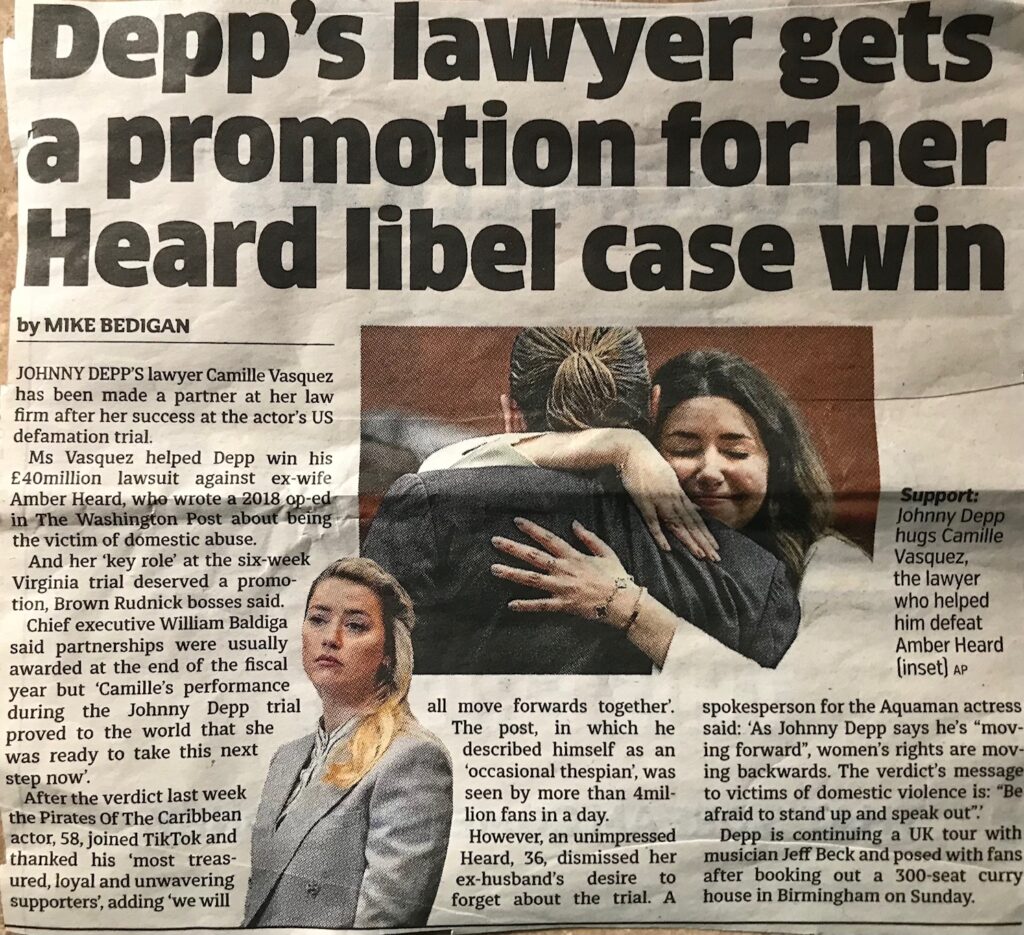
Amber Must Be Heard – Women Never Lie & Men Deserve Domestic Abuse.
Britain is the home of bigoted zealous extreme feminism, from suffragettes to the Me Too Movement. Women are always victims and never lie. No trnassexual woman could ever hope to reach their exalted plain.
We can see the petulance, the affront to Aamber’s automatic right to be believed over ex husband Johnny Depp. The fact she lied about Depp pushing Kate Moss down the stairs or cutting the top of of one of the guitarists fingers doesn’t matter. She must have been provoked into lying several times over.
If she wanted to right opinion peaces slagging Depp off, with intent to destroy his career, no problem. An English Judge agreed with her, but a U.S Court saw through her and the injustice of a me too movement which ws\ started by another aggrieved little actress of minimal talnet..
Men need to bewarse All gemder shared homes should have videoand audio recording, unless couples could be sent to supervsied breeding frms. A woman’s tears say more thsn real evidence ever could. Feminists hate transsexuals because no man could become as sainted as they and they need scapegoats and sperm donors. They don’t likie Depp’s fans, thronging with normal wopmen and they think men are so deseraate to rape them, they will have their male genitals doctored so they have no penis.
Men can never be women, and can still rape with the fingers, eyes and God knows what else what else, but why they would bother ? Why do so many need the make mentake the make date rape drug viagra ? You can see from Heard’s picture and whinge, that this fourt rate sullen petulant littleactress is on a mission for all women. That will make her more famous than any more of her crumby acting roles.The fact she shared Depp’s wild life style is of no matter. She is a woman and knows what it is like to suffer.. Men must give way to greater ‘equality ( sic ).
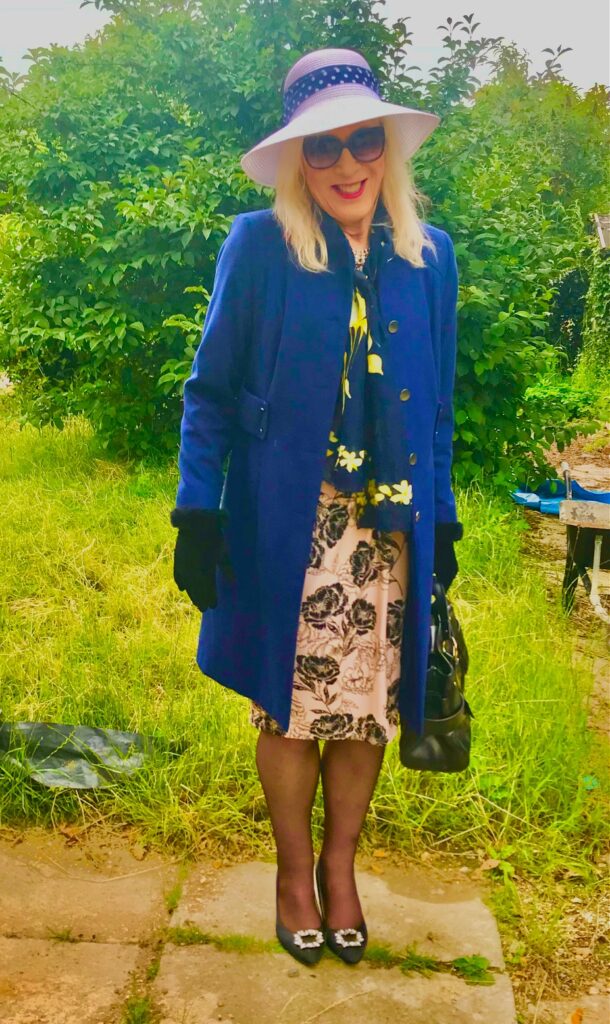
Miss Roberta Jane Cook
June 3rd 2022
Amber Must Be One Of The Feminist Herd – comment by Miss Roberta Jane Cook
One of the matters never mentioned in stories like this, is the absurd amounts of money these stars earn, a mockery of equality, particularly in the case of the minimally talented Ms Heard, a former model and accomplished poseur making the most of her tenuous fame and fortune from rubbish like Aqua man – which I watched several times because I am no intellectual snob. Low brow can be fun, but not when it produces preening self important dullards like Heard.
Johnny Depp, on the other hand is phenomenal. Depp comes from a troubled background, working as a musician before getting his film break in ‘Nightmare On Elm Street.’
The following two reports stand logic on its head, to create ‘feminist logic’, a contradiction in terms and school of thought where common women are part of a herd, led by bourgeoise female dominants who are always right and always telling the truth.
Feminists in the U.K and U.S are enraged that while a pious feminists sympathising U.K Judge, with no jury, found in Heard’s favour. It was a different story in the U.S, where a Jury, along with what feminists decry as dangerous fan phenomenon, found in Depp’s favour. Feminists now want to police fans and reform any woman, ostracising them if needed, who does not share their nasty puritanical coercive controlling bigotry.
The implication of these war crying harridans’ self righteous hysteria, is that when women allege life destroying domestic violence or sex offences, the man is guilty and must be judged and written off accordingly. Of course those judgements do not apply to senior U.K male police officers because they always tell the truth, so woe betide any man or woman who accuses them because there will be no investigation and the accuser will end up sectioned or jailed.Such police officers clain the right under a 1999 Tony Blair Law to be immune from press coverage, that way they avoid the Me Too movement and are free to abuse at will.
That is why P.C Couzens got away with it for so long, the system blaming all men when he raped and killed Sarah Everard, and why I am aware of a very senior corrupt U.K police officer who believes he is above the law. No ‘me too’ risks for him. Prince Andrew was recently described as a disaster by a fawning TV commetator telling us how otherwise wonderful Royalty are. No mention that he is a long time sex offender escaping because mummy paid a victim £12million. Equality is a sick joke which pnly imbeciles would find funny.
The same goes for the likes of Prince Andrew whose mummy, the esteemed old Queen stumped up £12 million to get him off. It is no wonder that more and more men are under pressure to take the male date rape drug viagra, or chase transsexual females like me.
The following articles make clear that if a woman alleges domestic abuse or sexual assault, the accused should be jailed , and ruined. Campaigners want the statute of limitations for domestic abuse raised to 2 years and sex assault is already without limitation.No evidence will be required beyond tears, so men should be very wary.. Women’s group leaders are looking for supremacy in all things. They are the ultimate transsexuals, scorning those of us who represnt a gentler more submissive colourful jaunty and humorous style of femininity.
Meanwhile, any male victim of domestic abuse is said, according to feminists , to have been asking for it, even if the man is crippled, maimed or murdered. Feminists and female posh TV presenters always insist that for every known male abuse victim there are 10 women. There is no mention that men are afraid to report it and won’t be believed any way. My ex wife admitted hitting me on four seprate occasions she could remmeber, but wouldn’t do anything because I had upset her mother – for very good reasons. Her last attack on me was cornering me witha broken wine glass.
It was treated as a joke when Mrs Bobbit cut of her husband’s penis while he slept. Mrs Bobbit drove away with it , dropping it into a dirty gutter. She was not prosecuted for sex offence or GBH because all she had to do was cry rape. Evidence not necessay – and they wonder why so many men need viagra.
On top of this, U.K courts are being told to find more men guilty of rape and abuse, no evidence needed because all women are timid shy creatures who would never lie about such embarrassing things. So the likes of Heard should have won so more women will come forward confident they will be believed, the man convicted and they will be compensated.It was deemed a tragedy when Caroline Flack hung herself rather than face court for GBH on her sleeping boyfriend. Now Amber Heard, who lied that Depp pushed Kate Moss down some stairs, is being elevated to the feminists martyrdom, their equivalent to the VC. Women never lie because they say they don’t. Britain is the ancestral home of feminism with the U.S lapping it up and Anglo America exporting it to Eastern Europe.. It is an indsutry supporting a very pernicious vicious destructive war on all men, commensurate with our Nazi age. They even want to make it a crime to not like women . In my view, there are men , women and individuals. The international elite don’t like individuals. They like a herd, the like Amber Heard.

#MeToo is over if we don’t listen to ‘imperfect victims’ like Amber Heard
Martha GillWhen even young women join the actor’s male tormentors, ideas of justice soon begin to unravel
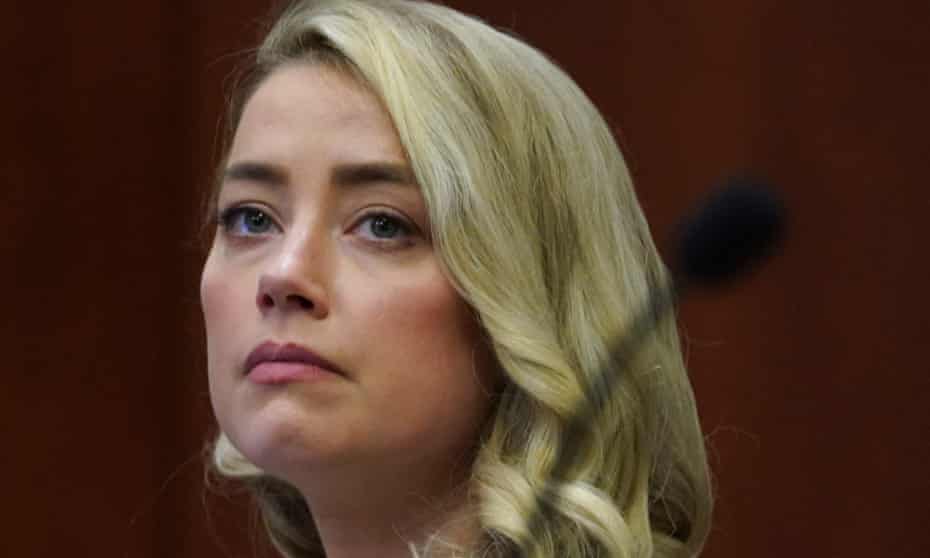
Sun 22 May 2022
/Getty ImagesSun 22 May 2022 07.30 BST
The backlash to the #MeToo movement was always coming. We know this because a backlash has followed every single step forward feminists have ever made. This backlash was always going to be big, too. Not only did #MeToo threaten a status quo that props up powerful men, it threatened these men personally, and – as it seemed to some – with reckless caprice.
“If somebody can be brought down by accusations like this,” a White House lawyer said shortly after Christine Blasey Ford’s allegations against Brett Kavanaugh were made public, “then you, me, every man certainly should be worried.”
It wasn’t just men who were worried. The idea that systems that previously treated only women, minorities and lower-class men unfairly might be capable of doing the same to high-status men was deeply unsettling to everyone.
After all, when a man is treated badly it lands with a double sense of burning injustice. Women’s stories of woe are so common that they can leave us comparatively unfazed. We feel bad, but we already know women are treated unfairly. It is priced in. “[Women’s stories were] all the same story, which is not to say it wasn’t important. But it was boring,” writes Taffy Brodesser-Akner in her novel Fleishman Is in Trouble. “The first time I interviewed a man, I understood we were talking about something more like the soul.” When something bad happens to a powerful man, it has not happened to a statistic. It has happened to a human soul.
Female accusers are still routinely treated as if they are lying, both by the public and the courts
For these reasons, #MeToo struck many men – and women – as deeply unfair. Yet it was merely an attempt to correct a bias that still exists. Female accusers are still routinely treated as if they are lying, both by the public and the courts – more so than other alleged victims of crime. It took the testimony of more than a hundred women to bring down Harvey Weinstein. Brett Kavanaugh was not brought down.
Published: June 3, 2022 4.42am BST
Could the Depp v. Heard case make other abuse survivors too scared to speak up?
Published: June 3, 2022 4.42am BST
Johnny Depp has won his defamation suit against his ex-wife Amber Heard for her Washington Post op-ed article published in 2018, which stated she was a “public figure representing domestic abuse”.
The facts in every case are unique, and the jury is always in a better position to judge these facts than commentators relying on media reports.
Nevertheless in such a high profile case as this, the verdict has a ripple effect that can go beyond the facts. The unfortunate reality is the Depp Heard case is likely to reinforce the fear that women who come forward with claims of sexual and domestic abuse will encounter a system in which they are unlikely to be believed.
Reform is needed to better balance the protection of men’s individual reputations with the rights of women to speak about their experiences.
Read more: The Johnny Depp-Amber Heard defamation trial shows the dangers of fan culture
Defamation a tool of elite men
Depp was awarded more than US$10 million in damages after convincing the jury Heard was a malicious liar.
This is despite the fact a UK judge determined in 2020 that it was “substantially true” Depp had assaulted Heard repeatedly during their relationship.
May 19th 2022
Teacher arrested for sex with student after husband informs headteacher
Shweta Sharma
A Pennsylvania high school music teacher has been arrested and charged for allegedly having a sexual relationship with one of her students after her husband disclosed their affair to the school.
Olivia Lois Ortz’s affair with her student was busted by her husband to the school- Wilmington Police Department
Olivia Lois Ortz, 26, a teacher of Wilmington Area High School, was charged with two counts of sexual contact with a 17-year-old school student, and one count of sexual offence with a minor, New Castle News reported.
Ms Ortz of Hermitage was suspended from the school on 9 May, and an arrest warrant was issued on Friday. She remained at large over the weekend but turned herself in to authorities on Monday afternoon.
The matter came to light after her husband, Cody Ortz, alerted the school headteacher.
He reportedly found out about his wife’s affair with a female student after he returned from a trip from Florida and found incriminating message exchanges on Ms Ortz’s iPad.
Read More Teacher arrested for sex with student after husband informs headteacher (msn.com)
Comment This is an outcome of empowering women to an absurd level. Women have the same sexual urges, if not more so, as men. But because female genitals are intruded and male’s extruded, the myth is that the penis is a weapon and the vagina an innocent helpless target, rather than a hungry mouth. That is why this woman will be excused because of her hormones and husband’s neglect. The same excuses do not apply to men. As for the all powerful cis vagina, this is the love tunnel through which we arrive into a world of lies, hate, deception and corruption.
Feminist consciousness is a rip off from Karl Marx. Marx was always absurd on that one, replacing one religious bigotry with his own. Science can not explain consciousness, so there can be no such useful concept as false consciousness. That is why psychiatrist have come up with ‘delusions’. That concept cannot be applied to feminism aka feminazism – so useful to dividing men from women and social control.
. Miss Roberta Jane Cook

May 9th 2022
RAPING TRUTH
by Roberta Jane Cook

All things are connected on this planet. Consciousness is invisible. I always thought Karl Marx’s esteemed concept of false consciousness rather absurd because of the obvious contradiction in terms.
Over 30 years ago I was an A level examiner in sociology for Oxford University Board. Basically one simply raced through the pile of scripts ( I marked two papers from each of 400 candidates yearly, simply looking for the right references and quotes, ticking and adding up marks for grading accordingly. Successful students could go on to University where the same process applied until lucky post graduates became grovelling researchers for the entrenched academic elite – and their paradigms.
That is how we get the smug feminist perspectivist thinking that has no room for suspecting women of dishonesty, sex or any other kind of abuse. They hijacked Marxism, defining all women as the noble exploited underclass , creating the moral morass and world of hopeless feral youth where men are still the scapegoats – and absurd liberal democracies. Religion is dragged back into this oppressive picture, with its absurdly outdated hypocritical pseudo morality derived from an obviously political Judaic Christian Islamic World of vested interests far closer than any false consciousness Karl Marx ever thought of. Miss Roberta Jane Cook.
Evil mum handed over nine-year-old son to be abused and raped by paedophile ring
Hollie Bone & Hannah Mackenzie Wood
A child sex abuse survivor has spoken out about his horror childhood after his homophobic mum willingly handed him into care where he was raped by “hundreds of men”.
Richie Barlow, 39, was brutally tortured by his evil parent from the age of four and would have “fairy liquid and chilli powder poured down his throat” just “because he was gay”.
At nine-year-old, she then voluntarily passed him over to Nottinghamshire County Council who placed him in a children’s care home.
Upon his arrival, he was branded “a predator” and outed to the other children and care staff.
In the four years that followed, Richie was beaten and trafficked into a paedophile ring where he subjected to constant sexual abuse – but says police and care authorities ignored his pleas for help.
Read More Evil mum handed over nine-year-old son to be abused and raped by paedophile ring (msn.com)
April 12th 2022
With jury picked, Johnny Depp opens U.S. libel case against ex-wife Heard
By Jan Wolfe

WASHINGTON (Reuters) -Lawyers for Hollywood star Johnny Depp on Tuesday gave a jury an overview of his U.S. defamation case against his ex-wife Amber Heard, the latest chapter in a long-running legal fight between the two Hollywood stars.
Opening statements kicked off in a Virginia courtroom in a lawsuit Depp, 58, brought against Heard, 35, for $50 million in 2018.
Depp alleges Heard defamed him when she penned a December 2018 opinion piece in the Washington Post about being a survivor of domestic abuse.
Read More With jury picked, Johnny Depp opens U.S. libel case against ex-wife Heard (msn.com)
Comment Women don’t need evidence to destroy a man’s reputation and credibility. It is an enormous risk for men to marry or even live with a woman because the presumption of guilt is always with the man. I don’t condemn all women as I still have some very loyal female friends. But the system is wide open for women to lie and destroy good men’s lives. Equality is nonsense.
There are some very bad women and some very good men. Why should we have to live under this oppressive feminists dictatorship. My answer to the conundrum of whether transsexual women are the same as cis women is NO. By definition. We transsexual women should aspire to something higher than membership of a bigoted self centred self seeking vengeful feminist herd. My experience has put me on the edge of suicide for the past 14 years.
R. J Cook.
March 19th 2022
New York Post says ‘dressing like a lesbian’ is the new trend – the internet says it’s just a pantsuit
Meredith Clark
In a tweet that took the internet by storm, the New York Post declared that dressing like a lesbian is fashion’s newest trend. Attached to the tweet was a recent article published by the news outlet, in which it declared that womenswear is “leaning toward the stereotypical lesbian look”.
The article published by The Post referenced an essay written by queer author Jill Gutowitz for Harper’s Bazaar. In the poignant excerpt from her new book, Girls Can Kiss Now, Gutowitz reflects on how the mainstreaming of lesbian fashion has validated her own queer identity, while also making her feel resentful that for so long lesbians were unable to appear visibly androgynous. The article was an insightful tribute to fashion and identity.
March 3rd 2022
Sarah Everard murder sparked UK reckoning with male violence, say charities
Alexandra Topping
Sarah Everard’s murder a year ago sparked a nationwide reckoning and revolutionised how the British public understand male violence against women, according to research.
The first major survey of women’s groups in the UK since the 33-year-old’s death also reveals the majority of charities believe the risk to women and girls has increased over the last year.
The survey by Rosa, a grant-making charity for 320 frontline women’s organisations, found 89% thought there had been a shift in public awareness over the last 12 months.
Read More Sarah Everard murder sparked UK reckoning with male violence, say charities (msn.com)
Comment This appalling crime should also cause a reckoning with police powers and abuses – and selection processes. There is also the issue of lunatic lockdowns and the fact that an average of 17 men are killed by their partners in the U.K every year, as well police not taking violence against men seriously, explaining it all away as men asking for it.
Additionally there are class and ethnic dimensions to these cases. Also police officers have a well above average rate of abusing partners along with provocatively high rates of adultery and divorce.. Blaming all men is asinine prejudice. There have been 5 different women killing their children in the U.K this year so far mentioned in media , with a syndrome usually used as an excuse. There would be outrage if women were all accused of child abuse – even though there are very high statistics for this and child neglect. R J Cook
March 1st 2022
International Women’s Day quotes that will make you feel fearless and empowered
Aleesha Badkar
Turn your tanks around and leave Ukraine, Boris Johnson urges PutinJoe Jonas strips off in DNCE’s steamy new music video
International Women’s Day quotes celebrate women across the globe and this year’s theme, #BreakTheBias encourages women across the world to challenge stereotypes and discrimination.
Read More International Women’s Day quotes that will make you feel fearless and empowered (msn.com)
January 29th 2022
BOYS, MALE SPACE, MEN’S ISSUES
MEN ARE GOOD AND SO ARE MALE ONLY SPACES


want to introduce you to a new hero of mine, a man named Johnny Shanahan. Johnny runs barber shops in Ireland and Great Britain. He decided that he wanted his shops to be male only. This has predictably created considerable resistance from those who felt it was sexist. Johnny won’t back down. Good on him. Johnny offers more than just a haircut. In some of his shops a bar is available, some offer poker, some cigars and the welcomed male banter. Johnny is standing up for the rights of men to gather in a male only space. He sees the obvious benefit for men to gather together. I don’t think it is a stretch to guess that Johnny also thinks men are good.
But why does Johnny even need to provide such a service for men? Well, because we have seen a systematic dismantling of male spaces over the last 40 years. The prominent justification is that women are facing discrimination by being excluded from the men’s spaces with the implication that men are using all of their male only spaces to network and market and thus leaving women out and disadvantaged. Framed in this manner male only space was deemed sexist and the demands followed that male spaces need to change and incorporate women. There may be an ounce of truth in this idea but that is no reason to dismantle ALL male spaces. The feminist demonization of men strikes again and the public has followed along like a little puppy dog.
Read More Men Are Good and so are Male Only Spaces | Men Are Good
Why We Need Women-Only Spaces

Last week I got the kind of email I’ve come to anticipate, having worked in women’s book publishing for the past 13 years. Sometimes the subject line implies the content: “Do you publish men?” Occasionally these are neutral inquiries. More often than not, the man on the other end asks me if he can change his gender, or publish under a pseudonym. I get a lot of emails from men telling me how much they love women, as if our exclusion of them implies they don’t love (or more importantly, support) women. It does not.
But last week I got an inquiry from a man whose resentment was palpable. He informed me in a very officious way that he’d blurbed a She Writes Press book and therefore found it “ironic” that we don’t publish men. So I guess he was hoping that his support of a female-authored book should cause us to rethink our very foundation. Um, no.
Read More Why We Need Women-Only Spaces | HuffPost Communities
January 27th 2022
Third-wave feminism – Wikipedia
https://en.wikipedia.org/wiki/Third-wave_feminism
Third-wave feminism is an iteration of the feminist movement. It began in the United States in the early 1990s and continued until the rise of the fourth wave in the 2010s. Born in the 1960s and 1970s as members of Generation X and grounded in the civil-rights advances of the second wave, third-wave
Nicola Sturgeon’s transgender reforms ‘could be harmful to women and should be stopped’
Daniel Sanderson
Nicola Sturgeon’s plans to overhaul transgender laws in Scotland risk proving damaging to women and should be shelved, the UK’s equalities watchdog has said.

The Scottish Government faced renewed calls to abandon the controversial proposals, after the “serious and substantial intervention” by the Equality and Human Rights Commission (EHRC) backed up concerns of feminist campaigners.
In a major reversal from its previous stance, the body urged the Scottish Government to halt proposals to make it far easier to legally change gender, claiming that the existing system struck the right balance between protecting transgender people and women.
It backed fears, repeatedly dismissed by SNP ministers and pro-trans lobby groups, that the “potential consequences” of the changes would impact on fields such as sport and criminal justice, as well as “measures to address barriers facing women”.
Read More Nicola Sturgeon’s transgender reforms ‘could be harmful to women and should be stopped’ (msn.com)
Comment
Feminists and their male supporters attitude to transsexuals is even more evidence that women know they are not equal to the average man and they want laws to advantage themselves. It is about power. The reference to trans people not being given equal treatment to women by the criminal justice system is also revealing that women’s groups expect such advantages. This is a bigger issue than just being about transsexuals. It is about how feminists see all men and demand preferential treatment.
Feminists cannot afford to accept transsexuals as women. There are too many glamorous old fashioned transsexuals who know how to dress to please men. Feminists need male scapegoats and the fantasy that all men are rapists. Women always get the benefit of the doubt in law. If they harm men it is always because they have been provoked. If they harm children it will be some kind of syndrome or because a man made them do it. No person born male could ever hope to reach the hallowed state of womanhood.
Women are now to be seen as the complete opposite of the Biblical image. According to the religion of feminism, men are not simply the ones who tempt women, they push them, with intent to rape and violence at the back of their minds. So in dresses, without their male genitals, men will lurk in ladies lavatories or get into their jails just to rape them.
How does this square with women pressing their men to take Viagra ? Sad fact for women is that males wanting to change sex is because they want sex and love with and the company of men. Men are beginning to realise that they risk losing everything in marriage, including contact with their children. So why bother ? Meanwhile there is an attempt to pass a U.K law making disliking women a hate crime. Men must bow to women.
R J Cook

January 24th 2022
Gary Lineker admits he’s ‘much happier being single’ despite his ‘two wonderful marriages’
“It’s nice to be unanswerable in a slightly selfish way and I’m not actively seeking a partner right now,” he told The Times. “I had two wonderful marriages and now I’m single and I’m in a good place, but that might change.”
January 15th 2022
Sinead O’Connor in hospital days after son’s death
Bang Showbiz
UK coronavirus cases ‘plateauing’ and giving ’cause for optimism’…Who is Poodle on The Masked Singer?
Sinead O’Connor has been admitted to hospital, just days after her 17-year-old son was found dead.
Her tweet came after she posted a flurry of messages, claiming she “doesn’t deserve to live” and blaming herself for her lad’s death.
She wrote: “I’m a piece of s***. I don’t deserve to live and everyone who knows me will be better off without me. I am sorry for all the harm I caused.
Read More Sinead O’Connor in hospital days after son’s death (msn.com)
January 14th 2022
Three Long Island women charged with assaulting Delta Air Lines employee at JFK
by Abigail Adcox, Staff Reporter | January 14, 2022
The White House said the move would involve sabotaging Russia’s own forces, creating a pretext to invade.
January 11th 2022
New-born baby survives after teen mother throws him into a dumpster and drives off
Georgia Bulldogs 33-18 Alabama Crimson Tide: College Football Playoff…Gabrielle Union filmed fake scenes for Bring It On trailer
A teenage mother in New Mexico has been arrested and charged with attempted murder and child abuse, after she was captured on CCTV throwing her new-born baby in a dumpster.
Read More New-born baby survives after teen mother throws him into a dumpster and drives off (msn.com)
January 10th 2022
Armed police in stand-off with father who refuses to come out of home with eight-year-old son
Cambridge University scraps prisoners programme after 2019 terror attackPeter Moody obituary
A house in Coventry has been cordoned off by police since early on Sunday amid concerns for the welfare of a man and his eight-year-old son.
Comment Men are increasingly going mad. They have a reduced role in family life but take all the blame. Women expect men to take Viagra and Terf feminists like Rowling preach hate against transsexuals. Free speech only applies to them. Raising a voice to a woman, if you are a man, is abuse and a criminal record. Women don’t have to prove anything to hold a man to ransom and /or destroy his life.
All a woman has to do to block father’s contact with his children is to go to police. Fathers are always the scapegoat and social services have a record of failure. A 27 year old mother recently killed her child and then herself. Out came the excuses. Had the genders been reversed there would be no sympathy. Feminists art about dominance, not equality of any kind.
R J Cook

Image Appledene Photographics / RJC
January 9th 2022
Woman who toppled Colston statue slams Tory ‘war on woke’
Harrison Jones
Trump promotes conspiracy theory that federal agents were responsible for…Ant and Dec’s last doomed game show attempt they knew would flop after first…
One of the Colston four has hit out at the backlash against the quartet being cleared, labelling jury trials and freedom of speech the ‘cornerstones of our society’.
Rhian Graham was acquitted of criminal damage after disgraced slave trader Edward Colston’s statue was torn down during a Black Lives Matter protest last summer.
After an 11-day trial, she was found not guilty at Bristol Crown Court on Wednesday, alongside Milo Ponsford, 26, Sage Willoughby, 22, Jake Skuse, 33.
But that has led to a ‘culture war’ backlash, with even some Government ministers getting involved.
Read More Woman who toppled Colston statue slams Tory ‘war on woke’ (msn.com)
Support grows for Manchester bus driver sacked for being ‘too short’
Maya Wolfe-Robinson
More than 13,000 people have joined a campaign to support one of Greater Manchester’s first female bus drivers who was dismissed for being “too short”.
Read More Support grows for Manchester bus driver sacked for being ‘too short’ (msn.com)
Comment I am sure the same rules would be applied for any man too short. There have been years of women on the march expressing a God given right to blaze trails into dominating every sphere of male activity.
Women’s groups have a mantra that they have not gone far enough. They also complain that men are changing in ways they don’t like or approve of. This woman was warned about dealing with bad language. As someone who was taken to Crown Court for swearing on a CID officer’s answer phone, after his attempted malicious prosecution, threatening me with jail, I am all too aware that feminising every area of social interaction means shouting and bad language is regarded as a criminal offence.
I refused to plead guilty to any offence and was threatened with jail. That is the world we are living in. It is no wonder increasing numbers are going mad and drinking themselves to death. As a truck driver with over 13 years experience, I know the road is a very dangerous place. R J Cook
January 8th 2022
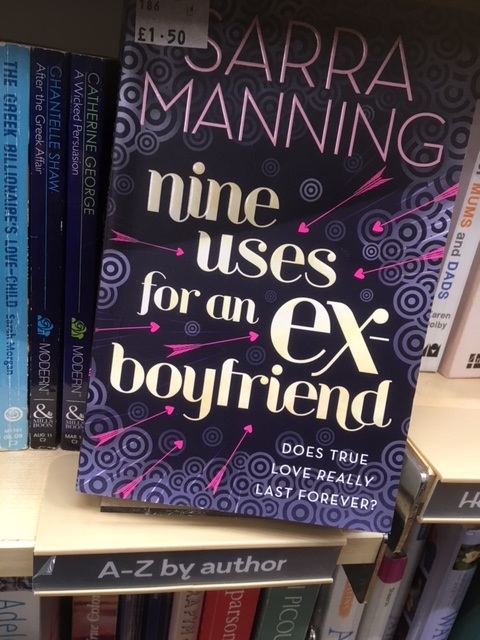
The moral of the story is that little boys are just not up to the horrors and difficulties of life as a little girl. Makes you wonder about all those boys lining up for sex change. Feminists just don’t have to make sense. World War One killed one third ( 33% ) of all European men aged between 16 and 22. Any young British man not in uniform was handed a white feather – a practice repeated in World War Two.
It was industrialised slaughter facilitated by the railways for benefit of rich Imperial ruling elites. R J Cook
Mother ‘put her son in car boot after he tested positive for COVID-19’ to avoid getting infected
Connor Sephton,
Which UK charity is named after a New York bar? The Saturday quizMiley Cyrus held hands with Maxx Morando at TV special
A mother in Texas has been accused of putting her 13-year-old son in the boot of her car after he tested positive for coronavirus.
January 7th 2022
Ghislaine Maxwell: Defence calls for retrial after juror says he was a ‘victim of sexual abuse’
Anthony France and Michael Howie
Prosecutors urged the judge who presided over the trial of Ghislaine Maxwell on Wednesday to conduct an inquiry into a juror’s reported claims that he was a victim of sexual abuse.
It came as her lawyers wrote to Judge Alison Nathan saying the issue “presents incontrovertible grounds for a new trial”.
Comment There have already been representations in the media to the effect that Ms Maxwell was not really guilty of any sex offence. This is because women never do sex or any other abuse crime, as with the two who starved a little boy to death, unless mesmerised or forced into it by men. Hence the female child killers provoked a campaign for no ‘knee jerk reaction to social services neglect’.
On the other hand , a knee jerk response to Sarah Everard’s pervert cop who raped and broke her neck, was a curfew for all men because of their natural violence toward women.
So it follows that just because a male juror wanted a bit of fame and sympathy for saying he was an abuse victim, nullifies the verdict. Perhaps what should have nullified the verdict was all the years of pre trial publicity. I have no idea of the details of Maxwell’s misdemeanours other than her involvement with Prince Andrew. It seems rather unfair he can buy his way out of this when the Maxwell woman, who he described in a BBC TV interview as his girlfriend, should have that option, paid for by mummy , the Queen..
There is , of course, the matter of her book of names, currently with the FBI and rumoured to have some very significant VIPS on the list of sex perverts. Epstein’s suicide was something of a tall and convenient story. Maybe letting her off would keep the lid on the high level can of filth and depravity..
I have no interest in judging this case other than to repeat that it is nauseatingly serious how we are supposed to accept that only men are ultimately responsible for such vile offences and other forms of child abuse. It is the same with domestic abuse. Dame Jenny Murray actually said on ‘Woman’s Hour’ that the average of 17 men killed by wives or partners every year in the U.K ‘probably deserved it.’
There is something very wrong here. it is no wonder we have record numbers of gay men and sex changes. The likes of J K Rowling , with her Terf and male acolytes, feel and express their sense of threat by this phenomenon. Hence their PC fantasy that men change sex to rape women in ladies lavatories. People like Rowling need men to keep their penises because the ‘penised individual’ is a rapist simply by casting an unwelcome look or brushing past. Men need to be very careful. R J Cook
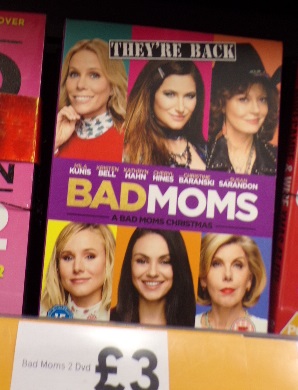
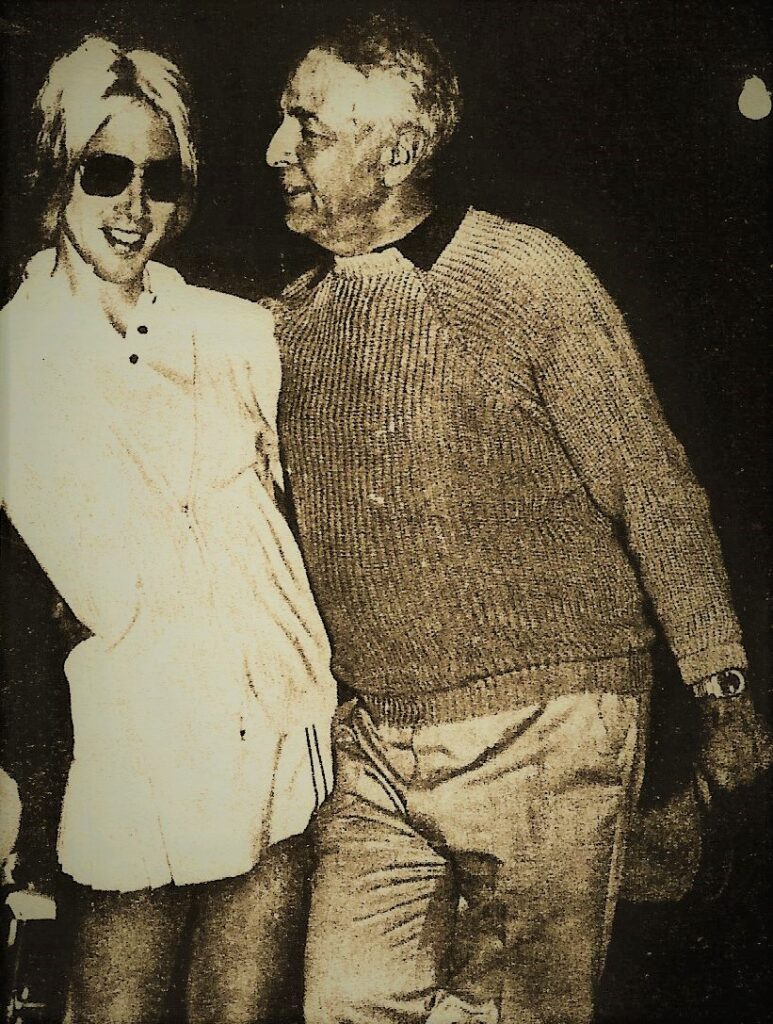
December 18th 2021
Females Inherently Good But Sometimes Misled !!! Females All Love One Another In A Benign Exemplary Sisterhood.
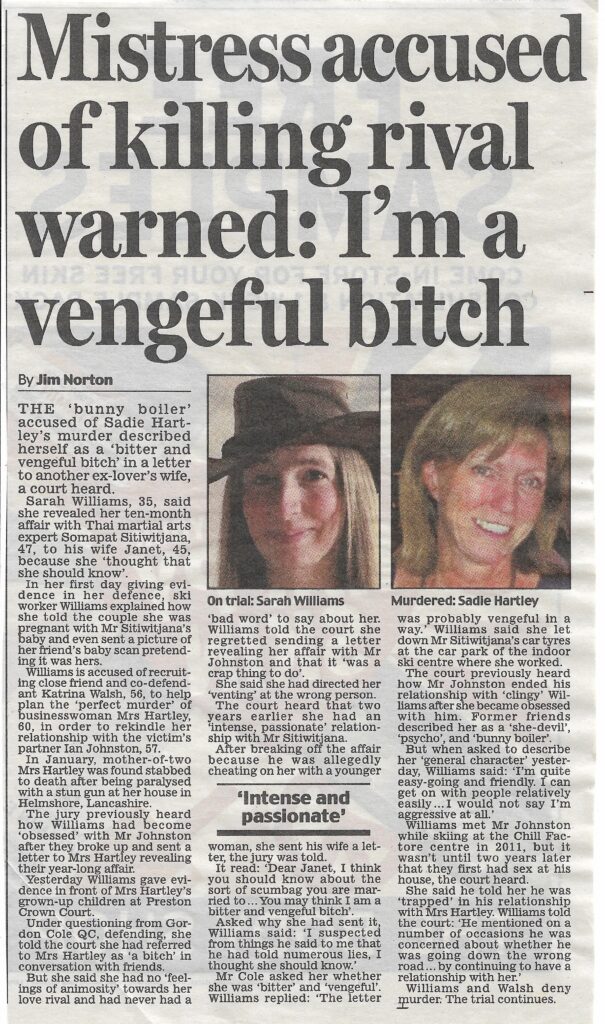
‘Utterly devastated’: Father of four boys who died in house fire speaks of ‘tragic loss’.
Covid live: Omicron spreads significantly faster than Delta, says WHO; experts…BBC Strictly Come Dancing star engaged as celeb pals share congratulations
The father of two sets of twin boys who died in a house fire has spoken of the “devastating” impact of the incident on his family.
Read More ‘Utterly devastated’: Father of four boys who died in house fire speaks of ‘tragic loss’ (msn.com)
Comment The State always assumes women are the best child carers and encourages ‘hate male’ attitudes. R J Cook
November 26th 2021
Haircuts To Avoid So You Don’t Look Like A ‘Karen’
UPDATED JUNE 23 202129

David Livingston/Getty Images North America
If you have been keeping in the loop lately, then you have probably heard of the term “Karen” and the negative memes attached to it. While many people see it as a pejorative term aimed at older women, that’s not necessarily true. It’s more of an attitude check. “Karens” are women who are acting overly entitled or demanding beyond the scope of what is appropriate. They believe rules should be broken to accommodate them, or service workers should go to great lengths to get their nod of approval.
Read More Haircuts To Avoid So You Don’t Look Like A ‘Karen’ – It’s Rosy (itsrosy.com)

November 16th 2021
Stanley Johnson accused of inappropriately touching senior Conservative MP
Beth Rigby, political editor 12 hrs agoLike|42
Rare Sierra Nevada foxes survive Dixie fireDancing with the Stars recap: heading into the finale two more fan…
Stanley Johnson, the former MEP and father of the prime minister, has been accused of inappropriately touching a senior Conservative MP.
Read More Stanley Johnson accused of inappropriately touching senior Conservative MP (msn.com)
Forget Climate Change & Disaster , It’s The Gender War That Counts – a few more cuttings from the Appledene Archives – Posted August 21st 2021
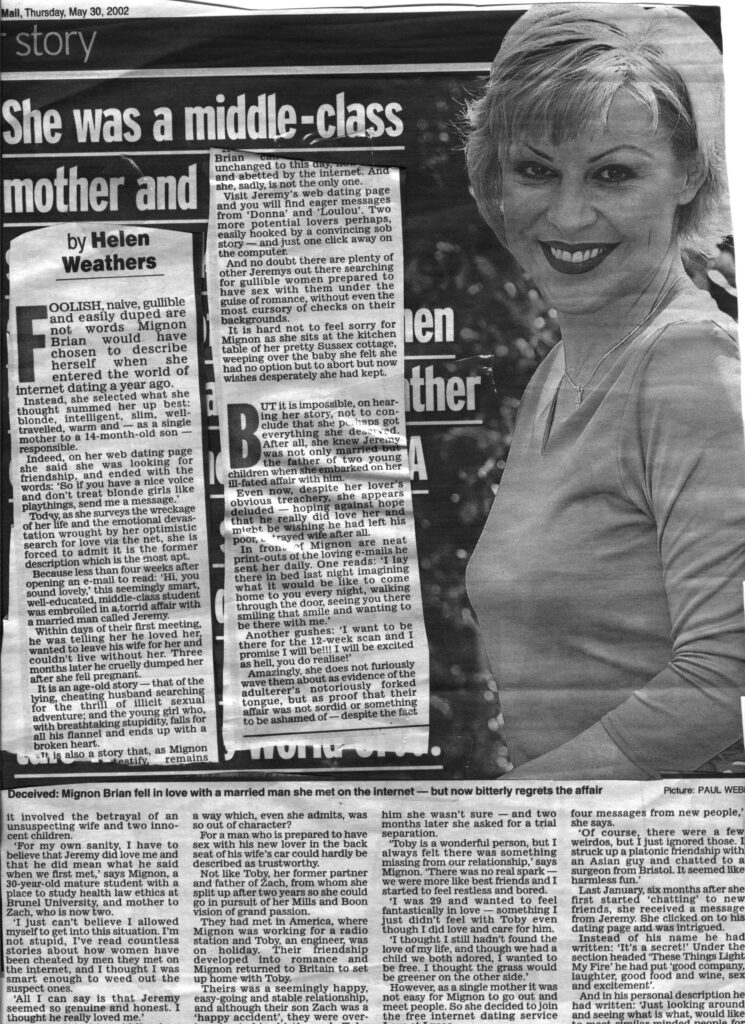
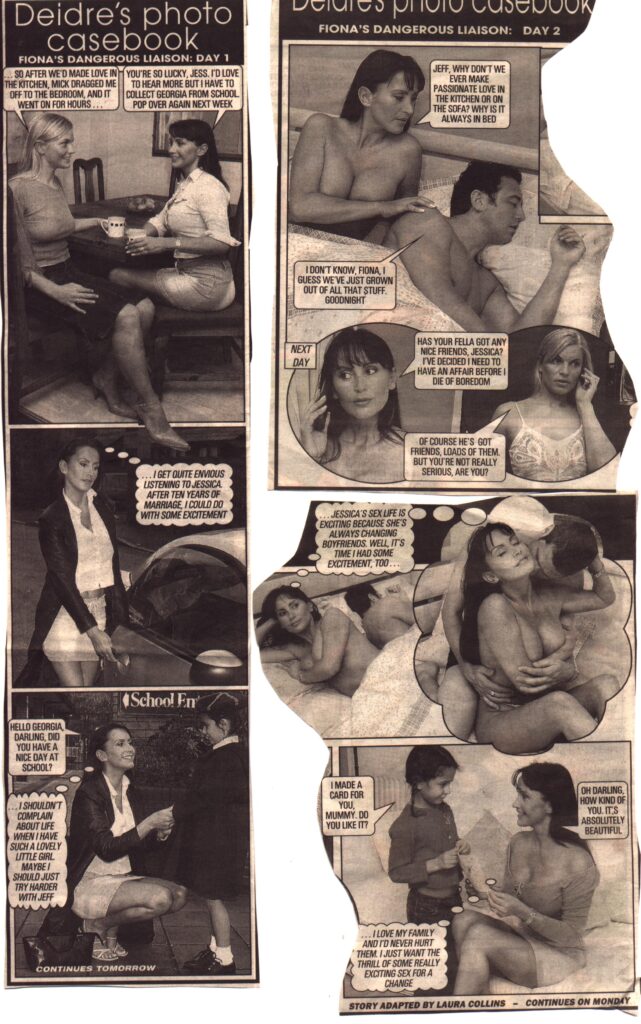
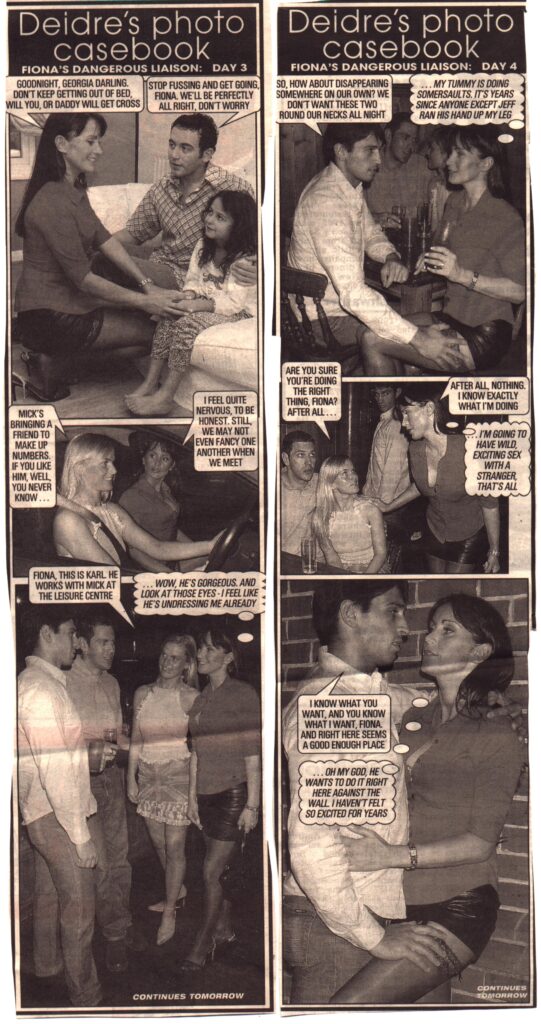
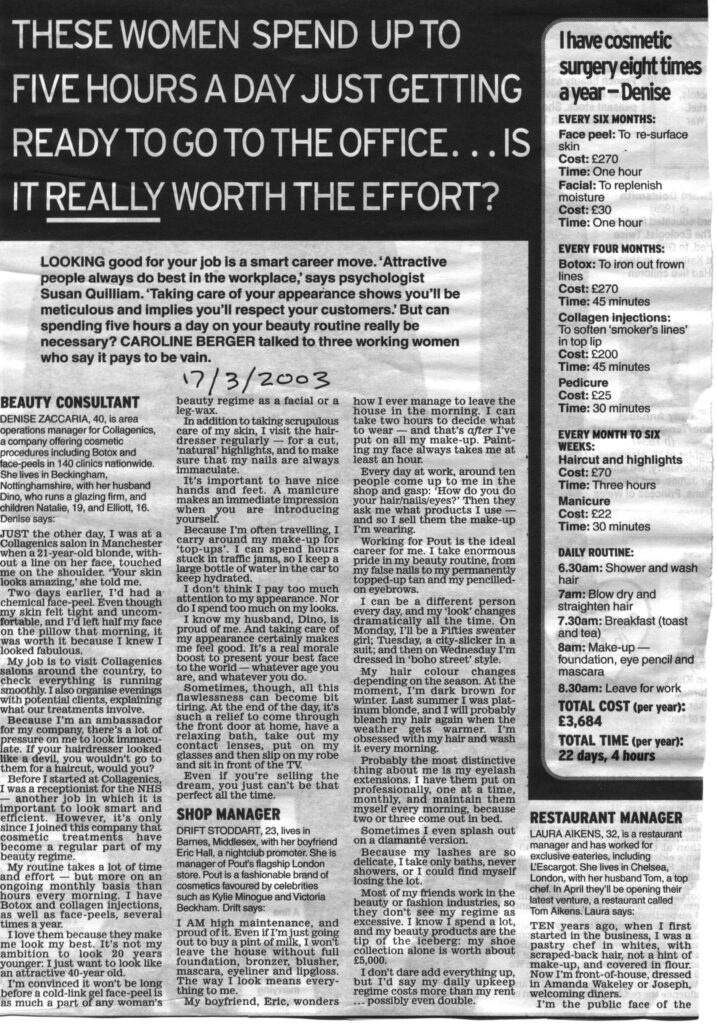
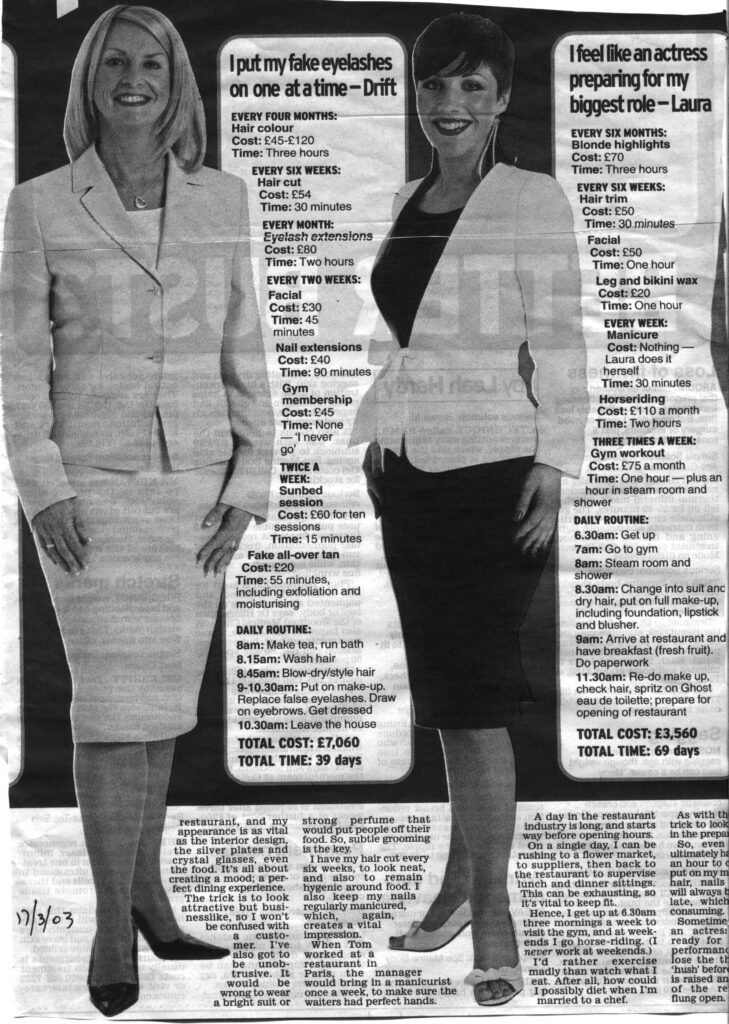

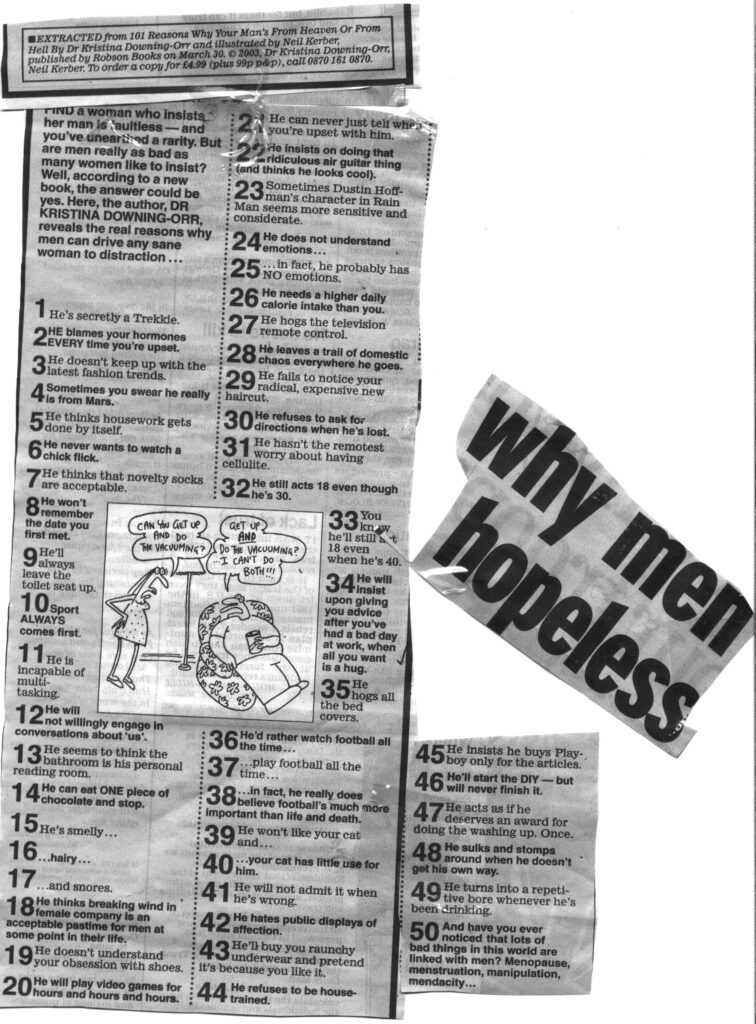
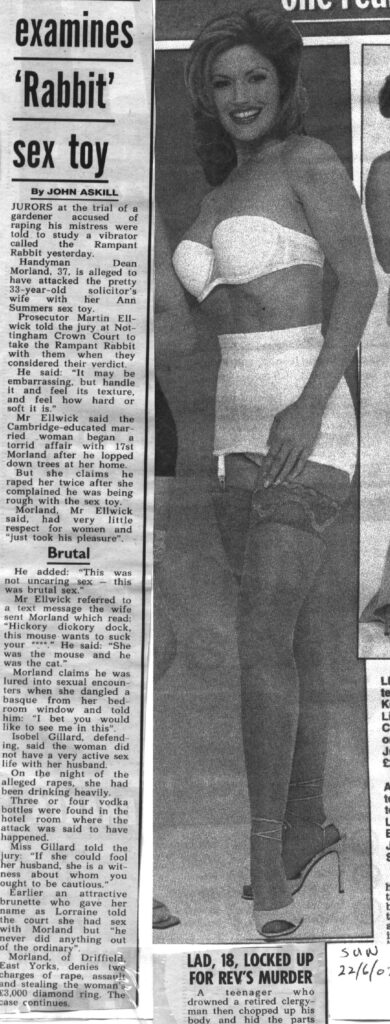
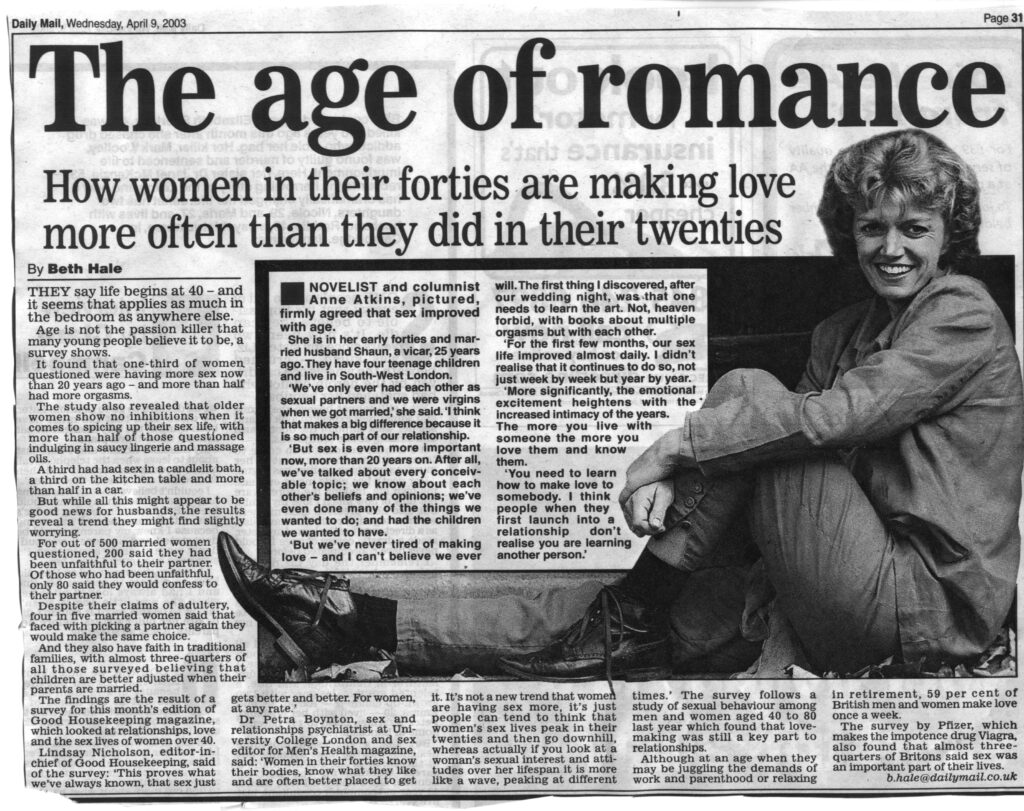
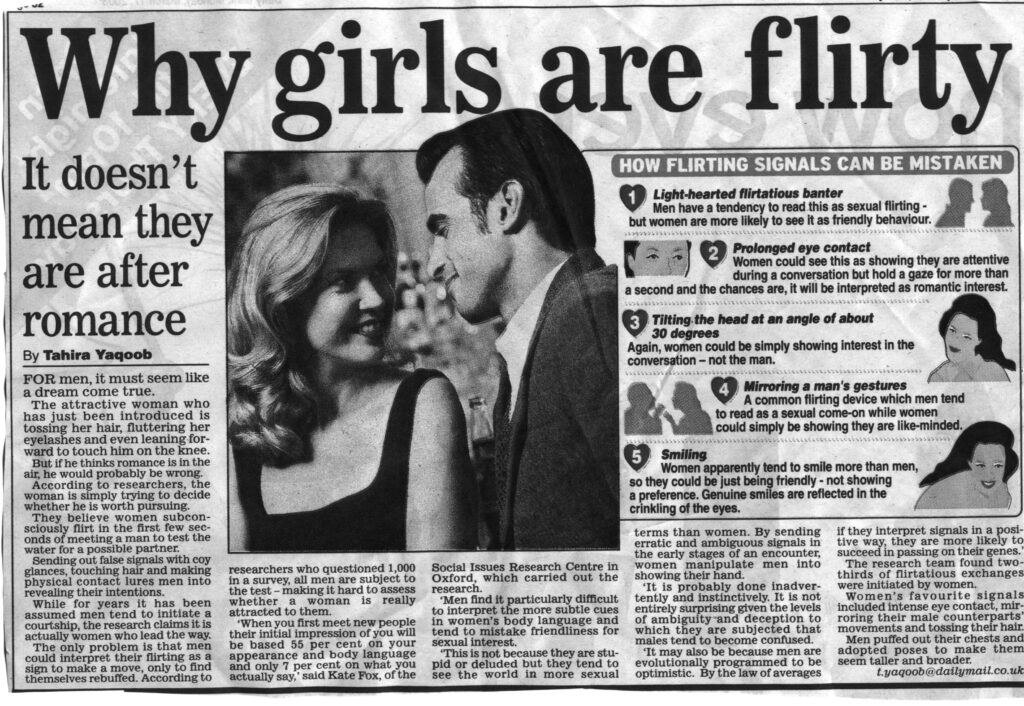
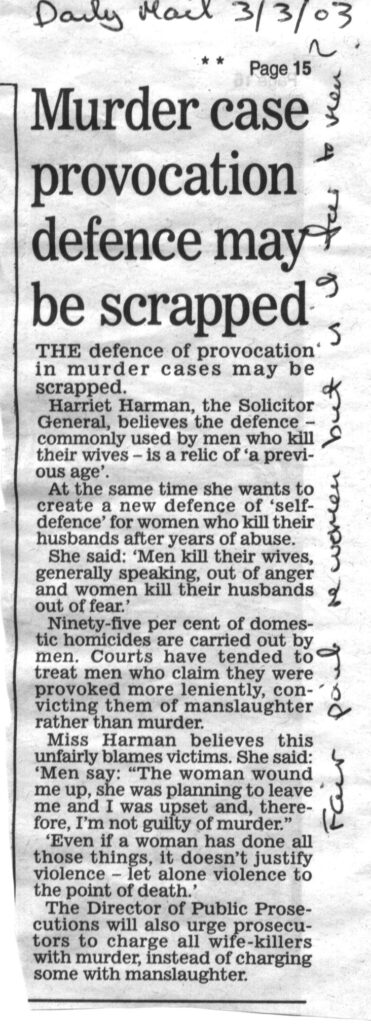
The above selection uncovers some of the complexities of being female. The final article derives from the established feminist view that women never tell lies about anything , especially men. They don’t do all that dressing and making up to impress men. They do it because they are fighting back , getting empowered and all that. That is what Caroline Flack was doing when she beat her recumbent boyfriend with a heavy lamp when she discovered he was cheating on her. I would never do that to a man, nor would I ever lie.

Roberta Jane Cook
Why dementia is killing more women than men – and the ‘silver bullet’ solution – August 11th 2021
Professor James Goodwin
Huge California fire grows as Montana blaze threatens townsRenewed calls for federal protection for live performance industry
While all eyes have been on Covid these past 17 months, a more familiar, far slower killer has remained in our midst. Dementia caused more female deaths last year than coronavirus, new figures show. Yet, somewhat inevitably, the 45,922 women it killed in 12 months have been much further from the spotlight than Covid has. 
Dementia and Alzheimer’s don’t only kill women, of course. The Office for National Statistics (ONS) figures show the diseases also claimed the lives of more than 24,000 men during the same period. One in three of us is expected to develop it in our lifetime and 850,000 people in the UK are currently living with some kind of dementia. But the prevalence is undeniably higher among women, who account for approximately two-thirds of those who develop dementia.
The question is why might this be? As is so often the case, there are multiple factors at play. More research is needed to gain a complete picture, but we do have some answers already.
Women’s brains appear to age slower than men’s. A woman’s brain is on average four years younger than the brain of a man the same age. So it may seem paradoxical that more women get dementia than men. But we know the single biggest risk factor for dementia is age. And quite simply, women live longer than men. By the time you reach 85, there are about 50 men for every 100 women.
With advancing age comes an increase in inflammation, a process of the immune system that goes on in the body all the time but more so as you get older, in part due to the malfunctioning of immune cells. Inflammation in turn contributes to the process of neurodegeneration – that is, the progressive loss of brain cells that begins some 20 to 30 years before a dementia diagnosis.
Another thing that happens as we age is an increase in comorbidities. In other words, we pick up more illnesses as we grow older. These comorbidities affect men more. While women are more likely to report health problems and see their doctor about them, they are also less likely to die at any age. But as they advance in years, these comorbidities they will increasingly pick up cause a growing inflammatory burden on the body, contributing towards dementia risk.
Meanwhile there is another story going on, and it’s about gender inequality. Women aren’t only more likely to develop dementia because they’re more likely to live long enough to develop it. They also carry a greater cumulative burden of chronic stress and life events.
We call this the allostatic load, and it is increased by factors such as poverty, social disadvantage, poor diet, low levels of exercise and poor stress management. Women are more likely to be single parents, more likely to suffer gender-based discrimination, more likely to be juggling unpaid caring responsibilities with paid employment… and so on. Over generations, they have been disadvantaged compared with men, in terms of their economic status, working life and reproductive burden.
All of this contributes to their shouldering a greater allostatic load, which again increases levels of inflammation in the body quite dramatically. Throughout your life, 25 per cent of the change in your thinking skills is due to your DNA. There’s a genetic risk factor for dementia, and if both your parents have it you are more likely to be predisposed to it. But 75 per cent of the way your cognitive abilities change as you age is due to your allostatic load.
It’s not quite as simple as saying the harder your life is, the more likely you are to get dementia. This doesn’t paint the whole picture. But it is clear there is a link, and that allostatic load is an important factor that contributes to dementia risk.
A further potential risk factor for women, and one that requires more research, is the menopause. When a woman enters the menopause, she experiences a sudden drop-off in the levels of her sex hormones, oestrogen and progesterone. Men also see their sex hormones decrease as they age, but for them the process is gradual and some men are more affected than others.
Gallery: 15 surprising risks associated with lack of sleep (Espresso)

We know sex hormones are essential for the development and maintenance of brain, and in recent years researchers have been investigating a possible link between menopause and cognitive decline. But at this stage there is insufficient evidence that taking hormone replacement therapy will be protective against dementia.
A greater volume of research has been carried out on the male brain than the female one and we could certainly benefit from a better understanding of female-specific risk factors for dementia.
But the good news is we already know enough about the modifiable risk factors to be able to slow down the neurodegeneration that precedes dementia. Researchers have found there are at least 12 modifiable risk factors that can increase the likelihood of dementia: midlife hearing loss, high blood pressure, smoking, air pollutants, lower education levels, traumatic brain injury, physical inactivity, diabetes, excessive alcohol consumption, depression, social isolation and obesity. Forty per cent of dementias can be prevented by paying attention to these 12 risk factors.
But if it’s a silver bullet you’re looking for, you could do a lot worse than to focus on exercise. If there ever was an easy answer to slowing down brain ageing, this would be it. Because exercise is not only good for your cardiovascular health; it is also brilliant for your brain. When you exercise, your muscles produce proteins that circulate to the brain, which ultimately leads to the stimulation of new brain cells. Since neurodegeneration is the progressive loss of brain cells, the more new brain cells you produce, the more you slow down that process.
As an illustration of this effect at work, we know for instance that people who are more physically active have better memories on average.
But exercise alone is not enough. If you run for half an hour and then sit in a chair for the rest of the day, the exercise benefits will be undermined – exercise is not an antidote for sloth. While you’re sedentary, the levels of inflammation in your body build up. So sedentary behaviour is a risk factor for dementia. You therefore have to build constant activity into your daily routine and ensure you are not sitting down continually for more than 40 to 50 minutes at a time.
This can be hard when you’re doing an office job, and it’s important to find reasons to get up from your seat. I used to walk up two flights of stairs to use a bathroom on a different floor at work, just to decrease the time I was sitting in my chair and to keep me more physically active.
The other good news is it’s never too late to make changes that will help slow down neurodegeneration. Scientists used to believe that once the brain had matured, that was pretty much that. But a 2019 study at the University of Madrid found the brain rejuvenates itself every decade. So throughout our life, the brain can undergo the generation of new brain cells, known as neurogenesis.
This can be aided not only by exercise but also by social contact, which is one reason lockdowns have been so punishing for those who live alone. Social isolation increases inflammation in the body. It is absolutely detrimental to your whole health, and certainly to your brain cells.
From 1998, researchers at Harvard University tracked 8,000 people over 12 years. They found in those who said they were lonely that cognitive performance declined 20 per cent faster than those who did not.
Your 40s, 50s and 60s are the perfect age to think about your lifestyle – especially exercise and diet – and whether there are changes you can make. Whether you’re male or female, there will be adjustments within your reach that will give you a better chance of having a healthy brain, now and into the future.
As told to Rosa Silverman
Professor James Goodwin is director of science and research impact at the Brain Health Network. Supercharge Your Brain by James Goodwin is available for £12.99 at books.telegraph.co.uk or call 0844 871 1514
Comment Women live significantly longer than men. Therefore they are eventually going to reach a point where their mind starts to fail. It is absurd but essential to gender politics to talk about all women as if they are the same. Social class factors and industrial health risks killing men at younger ages are not mentioned anymore. Nor are issues like alluminium sulphate used as floculants in water supplies.
On average women experience more care, respect , consideration and healthier safer employment. Equality legislation is about extending these privileges and making excuses for women. There are non stop complaints about the misery of being woman. Women were the ones who gave out white feathers to young men who they thought should march off to meet the machine guns of modern war. R.J.Cook

Stunning Evidence that the Left Has Won its War on White Males
July 15th 2021

There is a sickness in American society, fanned by the propaganda campaigns of the left, and it is killing people. White males, in large numbers, are simply losing their will to live, and as a result, they are dying so prematurely and in such large numbers that a startling demographic gap has emerged. It is not just the “opioid epidemic” that is killing off white working class males, it is a spiritual crisis, and Princeton economists Anne Case and Angus Deaton have the numbers to sustain this conclusion.
Jeff Guo of the Washington Post reveals the new findings of the two economists who first noticed the declining white male mortality.
The problem of dying whites can’t only be blamed on rising rates of drug overdoses, suicides and chronic alcoholism, they say. More and more, middle-aged white Americans are dying for all kinds of reasons — and the underlying issue may have less to do with opioids and more to do with how society has left behind the working class.
“Ultimately, we see our story as about the collapse of the white, high school educated, working class after its heyday in the 1970s, and the pathologies that accompany that decline,” they write.
This is slightly different than what they said in their first paper, where they emphasized that the trend of rising white mortality was “largely accounted for by increasing death rates from drug and alcohol poisonings, suicide, and chronic liver diseases and cirrhosis.” That’s technically correct — but by focusing only on the increase in death rates, Case and Deaton distracted from the larger picture.
The alarming fact isn’t just that middle-aged whites are dying faster, but also that mortality rates have been dramatically declining in nearly every other rich country. The United States is getting left behind.
That last point, that American white males are the exception, is the real proof that something particularly dangerous and harmful has been underway in American society. The two economists have summed up the relative change in mortality with this startling chart:
As Case and Deaton show, the gap in mortality between white middle-aged Americans and middle-aged Germans is about 125 deaths per 100,000 people now. Every year, of 100,000 Germans between the ages of 45 and 54, about 285 die. In the United States, it’s more than 410.
Out of those 125 additional American deaths, only about 40 might be explained by the spike in deadly drug use, drinking and suicides. And the rest? It’s hard to say. In their latest paper, Case and Deaton say that heart disease is part of the problem. While other countries have cut down heart disease deaths by over 40 percent in the past 15 years, heart disease remains a significant killer for white middle-aged Americans.

For at least four decades, white males have been under continuous assault as bearers of “white privilege” and beneficiaries of sexism. Special preferences and privileges have been granted to other groups, but that is the least of it. More importantly, the very basis of the psychological self-worth of white males have been under attack. White males are frequently instructed by authority figures in education and the media that they are responsible for most of the evils of the modern world, that the achievements of Euro-American civilization are a net loss for humanity, stained by exploitation, racism, unfairness, and every other collective evil the progressive mind can manufacture.
Some white males are relatively unscathed by the psychological warfare, but others are more vulnerable. Those who have educational, financial, or employment achievements that have rewarded their efforts may be able to keep going as productive members of society, their self-esteem resting on tangible fruits of their work and social position. But other white males, especially those who work with their hands and have been seeing job opportunities contract or disappear, have been losing the basis for a robust sense of self-worth as their job opportunities disappear.
We now have statistical evidence that political correctness kills.
A friend, David Kahn, comments:
This is terribly troubling. How all this has fallen outside the focus of our political debate is astonishing. This would seem to be at least as important as the issues of the day including which bathroom you can use, police abuse and who can be legally married to whom. It’s easy to understand why these people would resent the attention being paid to these issues and to the rights of the illegal immigrants.
There is a sickness in American society, fanned by the propaganda campaigns of the left, and it is killing people. White males, in large numbers, are simply losing their will to live, and as a result, they are dying so prematurely and in such large numbers that a startling demographic gap has emerged. It is not just the “opioid epidemic” that is killing off white working class males, it is a spiritual crisis, and Princeton economists Anne Case and Angus Deaton have the numbers to sustain this conclusion.
Jeff Guo of the Washington Post reveals the new findings of the two economists who first noticed the declining white male mortality.
The problem of dying whites can’t only be blamed on rising rates of drug overdoses, suicides and chronic alcoholism, they say. More and more, middle-aged white Americans are dying for all kinds of reasons — and the underlying issue may have less to do with opioids and more to do with how society has left behind the working class.
“Ultimately, we see our story as about the collapse of the white, high school educated, working class after its heyday in the 1970s, and the pathologies that accompany that decline,” they write.
This is slightly different than what they said in their first paper, where they emphasized that the trend of rising white mortality was “largely accounted for by increasing death rates from drug and alcohol poisonings, suicide, and chronic liver diseases and cirrhosis.” That’s technically correct — but by focusing only on the increase in death rates, Case and Deaton distracted from the larger picture.
The alarming fact isn’t just that middle-aged whites are dying faster, but also that mortality rates have been dramatically declining in nearly every other rich country. The United States is getting left behind.
That last point, that American white males are the exception, is the real proof that something particularly dangerous and harmful has been underway in American society. The two economists have summed up the relative change in mortality with this startling chart:
Read more: https://www.americanthinker.com/blog/2017/03/stunning_evidence_that_the_left_has_won_its_war_on_white_males_.html#ixzz70eJf2Yup
Follow us: @AmericanThinker on Twitter | AmericanThinker on Facebook
Comment I don’t think this matter is confined to the United State. It is certainly the case in the U.K. Sex change and other forms of feminisation are also outcomes , along with specific forms of self destructive crimes including the refuges of racism and misogyny.
You can’t have the white elite and BLM condemning whites , meaning working clas males , without consequences. Mental illness is another expanding issue. along with marriage collapse and white women taking sole charge of male offspring leading to behavioural issues. Robert Cook

Girls Don’t Need Kamala Harris As A Role Model June 19th 2021

I received a text message from a female family member on Wednesday stating how excited she was for both herself and my young daughter to see Kamala Harris be sworn in as the first female vice president. It now meant my daughter could aspire to be anything she wanted, up to and including the president, too. There is no shortage of news headlines proclaiming commensurate enthusiasm and messaging.
But is any of it warranted?
For starters, the claim that my daughter can now aspire to be anything falls short when one simple question is asked: Who did Kamala Harris use as a role model? If my daughter needs to see Harris, then who did Harris see? It doesn’t make sense.
Second, my daughter will be successful because she will be raised in a home that values morality, hard work, kindness, and will be given the love and support of both men and women in her immediate and extended families. Above all, if she does need a terrific female role model, she has her mother. There is simply no substitute for family.
Third, if young girls everywhere needed a role model like Harris to finally see the potential that was always within them, how do they explain all of the young white boys that have only ever seen themselves in office that never amount to much? Doesn’t this logic need to go both ways? I only need to identify one meth-addicted, prison-stinting bumpkin to make the point that white privilege doesn’t exist and that having a white man in office is no guarantor of individual future success. Who knows, maybe I am wrong and every black girl will now cure cancer in the next ten years.
Fourth, is biological sex a thing again? We are constantly told of a blurred line between men and women, but now when it’s convenient to distinguish a female first, we go all in. Had my daughter been born in New York City, I could have marked her sex, in addition to the only biological options of male or female, as a gender-neutral X. It’s the same insanity as when Team Biden felt like constructing a massive wall around the Capitol and conscripting 25,000 National Guard members to keep him safe. Are walls ok now? Are police ok? AOC should have demanded that the plaza be serviced by 25,000 social workers.
Fifth, where was this excitement when Sarah Palin was on a major party ticket? It doesn’t matter that Palin was painful to listen to and incompetent; she was a woman. I encourage everyone to revisit only SNL skits or pick up an archived New York Times to revisit the vile ridicule she endured. Selective enthusiasm rings as hollow as the selective outrage over the Capitol riots and silence or outright support of Black Lives Matter riots.
Fourth, is biological sex a thing again? We are constantly told of a blurred line between men and women, but now when it’s convenient to distinguish a female first, we go all in. Had my daughter been born in New York City, I could have marked her sex, in addition to the only biological options of male or female, as a gender-neutral X. It’s the same insanity as when Team Biden felt like constructing a massive wall around the Capitol and conscripting 25,000 National Guard members to keep him safe. Are walls ok now? Are police ok? AOC should have demanded that the plaza be serviced by 25,000 social workers.
Fifth, where was this excitement when Sarah Palin was on a major party ticket? It doesn’t matter that Palin was painful to listen to and incompetent; she was a woman. I encourage everyone to revisit only SNL skits or pick up an archived New York Times to revisit the vile ridicule she endured. Selective enthusiasm rings as hollow as the selective outrage over the Capitol riots and silence or outright support of Black Lives Matter riots.
Fifth, where was this excitement when Sarah Palin was on a major party ticket? It doesn’t matter that Palin was painful to listen to and incompetent; she was a woman. I encourage everyone to revisit only SNL skits or pick up an archived New York Times to revisit the vile ridicule she endured. Selective enthusiasm rings as hollow as the selective outrage over the Capitol riots and silence or outright support of Black Lives Matter riots.
Fourth, is biological sex a thing again? We are constantly told of a blurred line between men and women, but now when it’s convenient to distinguish a female first, we go all in. Had my daughter been born in New York City, I could have marked her sex, in addition to the only biological options of male or female, as a gender-neutral X. It’s the same insanity as when Team Biden felt like constructing a massive wall around the Capitol and conscripting 25,000 National Guard members to keep him safe. Are walls ok now? Are police ok? AOC should have demanded that the plaza be serviced by 25,000 social workers.
Fifth, where was this excitement when Sarah Palin was on a major party ticket? It doesn’t matter that Palin was painful to listen to and incompetent; she was a woman. I encourage everyone to revisit only SNL skits or pick up an archived New York Times to revisit the vile ridicule she endured. Selective enthusiasm rings as hollow as the selective outrage over the Capitol riots and silence or outright support of Black Lives Matter riots.
Fifth, where was this excitement when Sarah Palin was on a major party ticket? It doesn’t matter that Palin was painful to listen to and incompetent; she was a woman. I encourage everyone to revisit only SNL skits or pick up an archived New York Times to revisit the vile ridicule she endured. Selective enthusiasm rings as hollow as the selective outrage over the Capitol riots and silence or outright support of Black Lives Matter riots.
Fourth, is biological sex a thing again? We are constantly told of a blurred line between men and women, but now when it’s convenient to distinguish a female first, we go all in. Had my daughter been born in New York City, I could have marked her sex, in addition to the only biological options of male or female, as a gender-neutral X. It’s the same insanity as when Team Biden felt like constructing a massive wall around the Capitol and conscripting 25,000 National Guard members to keep him safe. Are walls ok now? Are police ok? AOC should have demanded that the plaza be serviced by 25,000 social workers.
Fifth, where was this excitement when Sarah Palin was on a major party ticket? It doesn’t matter that Palin was painful to listen to and incompetent; she was a woman. I encourage everyone to revisit only SNL skits or pick up an archived New York Times to revisit the vile ridicule she endured. Selective enthusiasm rings as hollow as the selective outrage over the Capitol riots and silence or outright support of Black Lives Matter riots.
Fifth, where was this excitement when Sarah Palin was on a major party ticket? It doesn’t matter that Palin was painful to listen to and incompetent; she was a woman. I encourage everyone to revisit only SNL skits or pick up an archived New York Times to revisit the vile ridicule she endured. Selective enthusiasm rings as hollow as the selective outrage over the Capitol riots and silence or outright support of Black Lives Matter riots.
Fourth, is biological sex a thing again? We are constantly told of a blurred line between men and women, but now when it’s convenient to distinguish a female first, we go all in. Had my daughter been born in New York City, I could have marked her sex, in addition to the only biological options of male or female, as a gender-neutral X. It’s the same insanity as when Team Biden felt like constructing a massive wall around the Capitol and conscripting 25,000 National Guard members to keep him safe. Are walls ok now? Are police ok? AOC should have demanded that the plaza be serviced by 25,000 social workers.
Fifth, where was this excitement when Sarah Palin was on a major party ticket? It doesn’t matter that Palin was painful to listen to and incompetent; she was a woman. I encourage everyone to revisit only SNL skits or pick up an archived New York Times to revisit the vile ridicule she endured. Selective enthusiasm rings as hollow as the selective outrage over the Capitol riots and silence or outright support of Black Lives Matter riots.
Fifth, where was this excitement when Sarah Palin was on a major party ticket? It doesn’t matter that Palin was painful to listen to and incompetent; she was a woman. I encourage everyone to revisit only SNL skits or pick up an archived New York Times to revisit the vile ridicule she endured. Selective enthusiasm rings as hollow as the selective outrage over the Capitol riots and silence or outright support of Black Lives Matter riots.
Fourth, is biological sex a thing again? We are constantly told of a blurred line between men and women, but now when it’s convenient to distinguish a female first, we go all in. Had my daughter been born in New York City, I could have marked her sex, in addition to the only biological options of male or female, as a gender-neutral X. It’s the same insanity as when Team Biden felt like constructing a massive wall around the Capitol and conscripting 25,000 National Guard members to keep him safe. Are walls ok now? Are police ok? AOC should have demanded that the plaza be serviced by 25,000 social workers.
Fifth, where was this excitement when Sarah Palin was on a major party ticket? It doesn’t matter that Palin was painful to listen to and incompetent; she was a woman. I encourage everyone to revisit only SNL skits or pick up an archived New York Times to revisit the vile ridicule she endured. Selective enthusiasm rings as hollow as the selective outrage over the Capitol riots and silence or outright support of Black Lives Matter riots.
vFifth, where was this excitement when Sarah Palin was on a major party ticket? It doesn’t matter that Palin was painful to listen to and incompetent; she was a woman. I encourage everyone to revisit only SNL skits or pick up an archived New York Times to revisit the vile ridicule she endured. Selective enthusiasm rings as hollow as the selective outrage over the Capitol riots and silence or outright support of Black Lives Matter riots.
Sixth, it needs to be understood that Harris was placed on the ticket not because 1) she excited the base, or 2) she was qualified. Joe Biden announced he wanted a female of color. That’s it. Those were the two requirements when he filled the slot, and Harris must have been a default pick. Stacey Abrahms is a trainwreck who still thinks she’s the governor of Georgia and Susan Rice makes Harris look sympathetic. So, that left Harris, someone who dropped out of the primaries and even lost her own state of California in the effort.
Seventh, even conceding that this is a monumental day (firsts of anything usually are), who can honestly look at Harris and be excited she was the first woman to have this honor bestowed upon them. We have over 150 million women in this country and he opted for Harris? Really? If sleeping your way to the top, displaying utter contempt for half of this country, and running with someone who just a few months prior she herself accused of being a racist, at what point can we say: I wish we’d done better?
Eighth, it’s a bold choice to champion a woman who supports the murder of hundreds of thousands of unborn female fetuses each year. It’s safe to say she does not support all women. What women does she support, then; the lucky ones not murdered by unable, unwilling, or simply selfish parents? It’s safe to say she doesn’t support all of Trump supporting women, either. But yes, girl power. And unity. Don’t forget the unity.
Ninth, celebrating a woman for merely being a woman is disrespectful to capable women everywhere. Moreover, it’s absurd. When commercial aviation sought to rebrand itself as an inclusive profession in the 1980s, airlines went out of their way to hire and retain less qualified (and indeed, more dangerous) female pilots. This isn’t to say women can’t or shouldn’t be pilots. However, ask any passenger on a plane as it enters heavy turbulence or lands with 30 knot crosswinds if they cared about the sex of their pilot during the most extreme conditions. Every human being will be praying not that their captain has ovaries, but that their captain knows what they’re doing. Does anyone think for a second Kamala Harris, or any of her staff, would want or even allow less qualified pilots on Air Force One?
As my daughter goes through school, would I want her teachers to pass her because she is female? I can imagine sitting down at parent-teacher conferences and them telling me she can’t read but it’s ok because, since she’s a girl, she can do anything. Wouldn’t that be reassuring? Life will get really confusing as she heads off to college and her professors tell her that femininity is a patriarchal structure and that there is no such thing as a binary of men and women. Of course, since she still can’t read – but remember, it’s ok because she was a girl! – and only got to college based on false grades, her mind will morph into a pretzel.
Tenth, we need only revisit recent history to realize that any “wins” from the inauguration and swearing in of Kamala Harris will be short lived and soon forgotten. Consider the following two questions. How are race relations in America right now? What were people saying about the election (and reelection to a lesser extent) of Barack Obama as the country’s first black president? Barack Obama made race relations worse in this country by pandering to the black community and perpetuating the narrative that blacks are victims in this country. Yes, the first black president said blacks are victims in this country without a hint of irony. The Cambridge police incident, Trayvon Martin death, Ferguson riots, and quoting how racism is in this country’s DNA are just a few of the many disastrous choices Obama made.
Does anyone think this will end better for the relationships of the sexes? Kamala Harris plays the victim card. She sees herself as a victim. If her victim mentality extends to policy, why wouldn’t she want to get back at men? I only ask that if she goes after white men that she start with her husband. Yes, she hates white men and married one. Go figure.
When past presidents were elected, regardless of their political bent I always defaulted to a position of hoping for their success. A successful president meant a successful nation. I no longer feel that way. If Kamala Harris is successful in executing her visions, this nation is doomed. I rue for the young girls everywhere, my daughter included, that will both have to put up with endless lies about female empowerment as well as grow up in a less free and tolerant world.
Kamala Harris might be my elected representative, but she represents nothing in the way my daughter will be raised.
By: Parker Beauregard. This article originally appeared on Blue State Conservative
SEXUAL OFFENCES ARTICLES
WHAT TO DO IF YOU ARE FALSELY ACCUSED OF RAPE Posted June 19th 2021
 Contents1 Will the police come to my house?2 Will the police interview me?3 What happens after the police interview?4 Should I contact the accuser?5 What happens to the person who falsely accused me?6 Where can I get help if I have been falsely accused?
Contents1 Will the police come to my house?2 Will the police interview me?3 What happens after the police interview?4 Should I contact the accuser?5 What happens to the person who falsely accused me?6 Where can I get help if I have been falsely accused?
Of all the crimes that one could falsely be accused of, rape is without a doubt among the worst. People are falsely accused for a number of reasons, which include malicious accusations as well as cases of misidentification, misrecollection, and misleading forensic evidence. Knowing what to do if you are falsely accused of rape can go a long way to mitigating the damage that could be done to your reputation, as well as setting your mind at ease about what might happen next. Read on to discover more about what will happen if you are accused and what you can do to prevent word spreading about the accusation as much as possible.
WILL THE POLICE COME TO MY HOUSE?
With accusations as serious as rape, the police will want to speak with you, and they are likely to try to find you as quickly as possible. This is not only because the nature of the offence itself is so serious, but also because – in their eyes – you could be a threat to other people, or to yourself. Because the police do not want to give accused individuals a chance to run, they are likely to turn up at your house or at another location where you are likely to be (your workplace or a particular place you are known to spend a lot of time, such as your favourite pub or restaurant, for example). You are not likely to get any notice of this, again, because the police do not want to give people a chance to run away or to arrange for others to lie to police on their behalf.
WILL THE POLICE INTERVIEW ME?
The police are likely to interview you under caution. This means you will be taken to (or requested to attend) a police station where you will be questioned about your alleged criminal activity. In cases of suspected rape, this is likely to be a difficult interview where your personal life and relationships will be questioned and scrutinised. As difficult as this may be, and as upset as you are likely to be on account of the falsehood of the accusation, you must remain calm and answer the police officers’ questions as fully and as truthfully as possible.
Remember that you have rights at the police station, including to have food, water, and rest breaks, but more importantly to legal representation. Do not say anything unless you have spoken to or are in the presence of a solicitor, who will be able to protect you as far as possible from anything that may be self-incriminating or taken in evidence and used against you at trial. If you have not had time to arrange a solicitor prior to your interview, you have the right to call one at the station or to use the duty solicitor.
The police are likely to take your fingerprints and a number of samples from you. Your consent is not required for fingerprints, saliva samples, oral swabs, or footprint impressions, but your consent is required for samples of urine, blood, and semen, and for dental impressions.
The police are also likely to take your mobile phone and any cameras or computer equipment they find in your possession. These devices will be sent to a forensic laboratory for testing, and it could be weeks or even months before you receive these devices back.
WHAT HAPPENS AFTER THE POLICE INTERVIEW?
As soon as any accusation is made, the police will begin to investigate. This includes collecting any scene of the crime evidence, like footprints, abandoned clothing, CCTV images, and other contextual information, as well as interviewing key suspects, witnesses, and the accuser(s).
In this regard, you should know that the police investigation may have preceded your interview, and it may proceed it too. In other words, both before and after the interview the police will be investigating and gathering more evidence. As such, there could already be evidence against you and in combination with your answers at the interview, the police may decide to detain you in custody. Even where there are suspicions that the accusation may be false, with crimes as serious as rape, people are usually detained ‘just to be on the safe side’. If you are detained, you may remain at the same police station or you may be transferred elsewhere until you are able to be seen in court.
If you are released, it is highly likely you will be released with conditions attached to your bail, meaning not only that you are required to return to the station for further questioning at the police officers’ instruction, but also that you might be required to observe a certain curfew, to remain within a certain geographic area or avoid a certain area, or that you have your passport confiscated.
SHOULD I CONTACT THE ACCUSER?
Whatever you do, do not contact the person who has accused you of raping them. For one thing, you do not want to exacerbate the situation in general, but perhaps more importantly, you do not want to be accused of intimidating your accuser or trying to silence them. Contact whether direct or indirect (i.e. getting someone else to speak to the person on your behalf) counts in this sense, so try to put as much distance between you and the person accusing you as possible.
In any circumstances where someone is accusing someone else of a serious crime, emotions and tensions are likely to be sky high. For this reason alone, any attempt to speak to the person accusing you carries a significant risk of having the situation get out of hand. If the accuser keeps confronting or contacting you, do your absolute best to remove yourself from the situation and, where possible, have witnesses see that you are doing so. It is best to inform your solicitor if this happens.
WHAT HAPPENS TO THE PERSON WHO FALSELY ACCUSED ME?
If it is discovered that the person falsely accused you, or if the person admits to such, there could be a number of consequences for that person. Much depends on the situation in these cases, and the police may decide to take or not take action regardless of your views on the matter.
In some cases, especially where the investigation has taken a lot of time or where multiple false accusations were made, the Crown Prosecution Service (CPS) may find it appropriate to charge the accuser with perverting the course of justice (a very serious offence that carries a maximum sentence of life imprisonment, although it is highly unlikely such a punishment would be issued in a case of false accusation) or – more commonly – the offence of wasting police time (which carries a maximum sentence of six months’ imprisonment and/or a fine).
In practice, however, such prosecutions are extremely rare. Rape accusations are, of course, highly sensitive issues and the criminal justice system has to be very careful not to deter people from making complaints where warranted.
In some cases, a civil claim against the person for defamation of your character may be more appropriate, especially if you have lost your job or suffered other harm as a result of the false accusations.
WHERE CAN I GET HELP IF I HAVE BEEN FALSELY ACCUSED?
On account of the serious nature of accusations and the fact that so often accusations can be false, a number of helplines have been established to assist people finding themselves in this position. It is important that you get the necessary support if you have been falsely accused, not least because you will need to be in a strong mental state to face any charges that are made against you, and the legal proceedings that will follow.
Certain websites offer general assistance and emotional support whether you have been falsely accused or have falsely accused someone else, and others offer advice solely to those on the receiving end of a false allegation. Some of the most popular and well-respected services include:
- FASO (False Allegation Support Organisation)
Helpline: 0844 335 1992
www.false-allegations.org.uk - Falsely Accused of Rape Forum
www.daftmoo.org.uk - Accused Me
www.accused.me.uk
While these services are undoubtedly useful in terms of emotional and community support, the best option for figuring out what to do if you have been falsely accused of rape is to contact an expert criminal defence solicitor.
At Stuart Miller Solicitors, we have been helping people with false rape accusations for a number of years, and our experts are placed to help you in a confidential, non-judgemental, and friendly manner. Contact us today for a no-obligation consultation about your case and more information on what to do next.
‘Suicide is painless & it brings on many changes ( sic ) – June 11th 2021

A photograph shared on social media show a man sat on the edge of a bridge flanked by what appears to be two police officers.
Cheshire Police said it was called to a bridge over the M62 by Warrington on Tuesday afternoon due to safety concerns.
Vulnerable Citizen Support Leeds, a community interest company providing welfare services for those in need, shared a photograph of the incident on their Facebook page to raise awareness of mental health issues.
The non-profit organisation said it was sharing the image to show “it’s okay not be ok”.
The group, who also deliver food to the homeless, praised the lorry driver for taking action.
“What a trucker,” the post said.
Comment Male suicides , one parent families, sex changes and delinquency have risen exponentially with the rise of feminist aggression against men, their vile name calling, and now the woke are attacking white men as racists just because they are white. I have personal experience of a son threatening suicide , along with NHS incompetence , lies and cover ups. I cannot say more for legal reasons. Robert Cook
Female student, 29, who said ‘women have vaginas’ and are ‘not as strong as men’ faces disciplinary action by university after fellow classmates complained about the ‘offensive and discriminatory’ comments – May 18th 2021
- Lisa Keogh facing disciplinary action at Abertay University in Dundee, Scotland
- The student said women were born with female genitals during a video seminar
- She was reported to university’s chiefs by her classmates following the debate
By Bhvishya Patel For Mailonline
Published: 02:03, 15 May 2021 | Updated: 17:43, 15 May 2021
A student who said women were born with female genitals and the difference in physical strength between men and women ‘was a fact’ is facing disciplinary action by her university.
Lisa Keogh, 29, who studies law at Abertay University in Dundee was reported to university chiefs by her classmates after she said that women were not as physically strong as men.
The mature student, who is in her final year, is now facing a formal investigation by the university for the alleged ‘offensive’ and ‘discriminatory’ comments.
The mother-of-two said she had been taking part in a video seminar about gender feminism and the law when she raised concerns about trans women taking part in mixed martial arts.
- Following the debate, in which Ms Keogh claims she was muted by her lecturer, the mature student was met with a flurry of abuse from her fellow classmates. Pictured, Abertay University in Dundee
After telling her classmates that a women who had testosterone in her body for 32 years would be genetically stronger than the average woman, the mature student was accused of calling women the ‘weaker sex’.
She told The Times: ‘I thought it was a joke. I thought there was no way that the university would pursue me for utilising my legal right to freedom of speech.’
Following the debate, in which Ms Keogh claims she was muted by her lecturer, the mature student was met with a flurry of abuse from her fellow classmates.
Ms Keogh, who is being supported by Joanna Cherry QC, the SNP MP for Edinburgh South West, continued: ‘I didn’t intend to be offensive but I did take part in a debate and outlined my sincerely held views.’
She added: ‘I wasn’t being mean, transphobic or offensive. I was stating a basic biological fact.’
Comment Though I agree with this female student, there is an irony. Feminists are always telling us that women are equal . The sexes – or must I say genders – are not equal , people are not equal. The basic equality issue is money. The rest is a smokescreen.
Physically men and women , on average are not equal. Females cannot match men in any sport where power , spatial awareness and stamina are the issue. Twisting and limiting language, which is the woke norm , to argue that TS women are or are not biological women will not alter reality.
Female ‘sports ‘ stars are worried about their egos and the money and they should because any male who has transitioned after puberty will beat them. They don’t like being told that , but they don’t like the competition either.
There is also the more disturbing truth that this mature female student was shut up by her lecturer , abused and now faces disciplinary action. All the signs are that Britain is an advanced police state. That is why the authorities and their media keep telling us it is a democracy. LGBTQI is a box , lifestyle choice at best.
Peoples’ sex lives , like their religion should be private matters. But the elite need to make issues of all of this. This mentality doesn’t stop here. It is Nazism. Stifling this girl’s statement of the obvious is just another example that anyone caught saying or writing the wrong thing will face judgement by the vurtue signallers and punishment by the British Police State.
Robert Cook.
https://inculture.microsoft.com/womenshistorymonth/?ocid=AID3030225_QSG_513693
Truth is people lie about sex & violence , no evidence needed- Robert Cook May 15th 2021
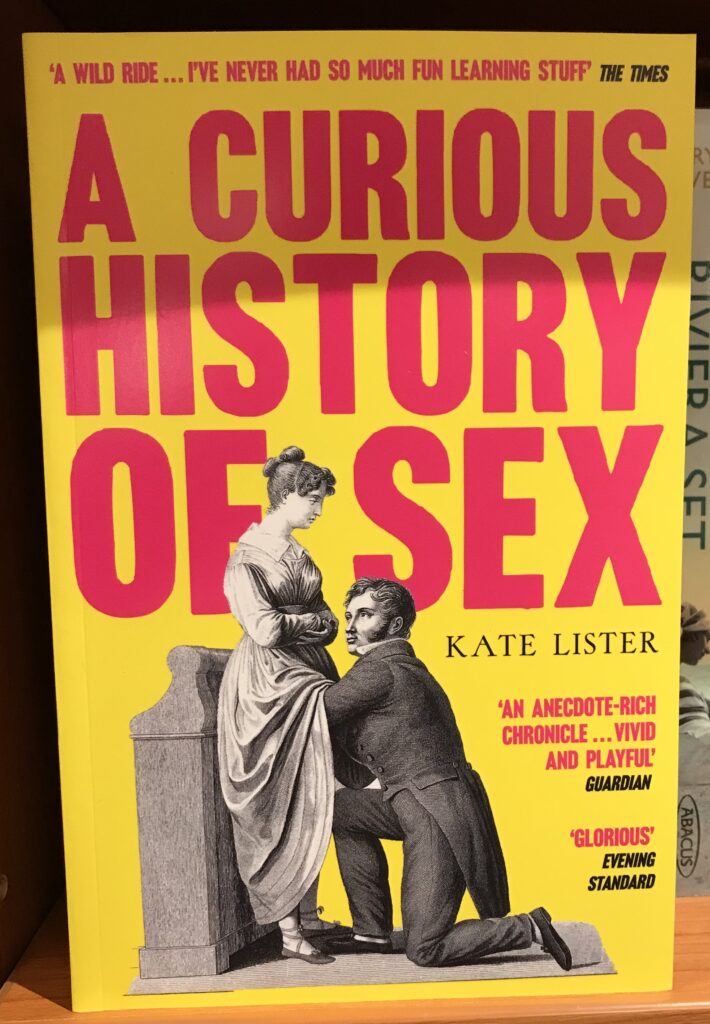
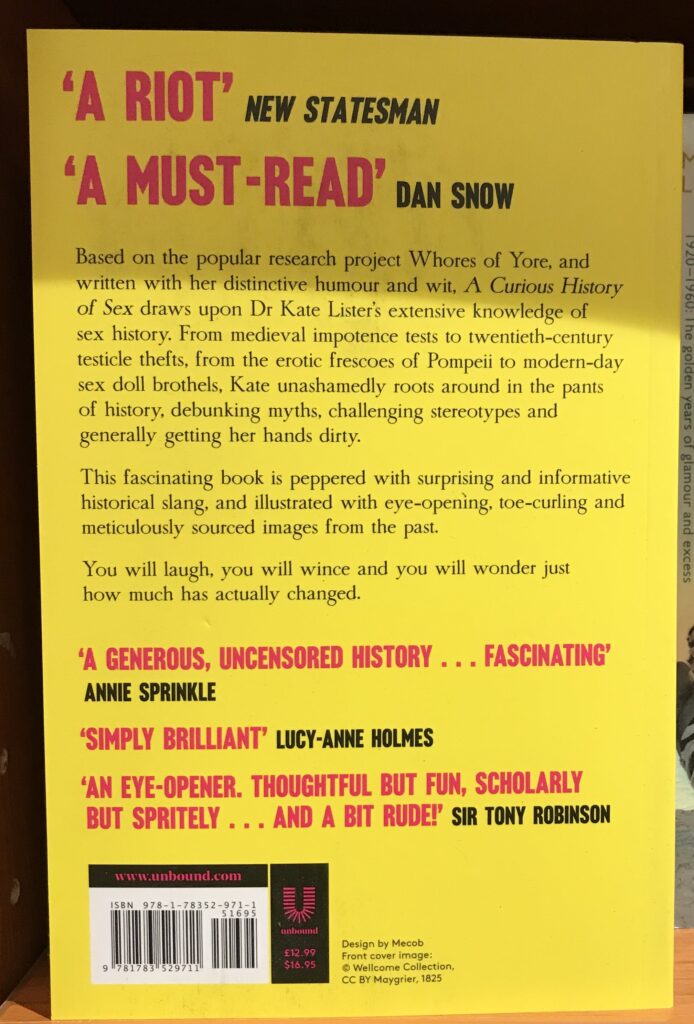
The truth about sex is that ‘nice’ people don’t want to hear the truth or for others to know it. This book is the usual bourgeois drivel. The very fact that Dan Snow from the Snow mainstream media dynasty likes it says it all.
Sex is now about politics in a way it never was before the mid 1960s so called sexual revolution. It is now far from a joking matter, other than to say how absurd human society now treats and polices the matter .
Germaine Greer’s career is like a time line for the bourgeois age of the endless quest for female equality. She got lucky with a ridiculously entitled book ‘The Female Eunuch’ . Since a eunuch is a castrated male, one has to assume that she sees women as metaphorical metaphorically castrated males. Hence the flavour of resentment and revenge in hers and all the writers she inspired. Her sort actually believe , like Islamists , that there is no counter argument. It is clear from her history, she has issues with her height, dancing the male part at her posh all girl boarding school and daddy matters. Thus , she began her tirade as if she were centre of the universe. It is also relevant that she came from ‘the land down under’ where men used to be men.’
She inspired so many women to follow in her bra burning footsteps. By the 1980s she was posing such great philosophical questions like : ‘You have to ask yourself when he wants you in certain underwear, who’s he fu-cking, you or the basque ?’ Other gems included the line that ‘ men should pay a genital tax’ and ‘ men who want to change sex are failures as men.’ After years of struggle with those who wanted her ‘no platformed’, Greer no platformed herself for all time with the line ‘Most rapes are just bad sex.’ She has had no mainstream sound bite opportunities since.
White people are nowadays being urged to cut their less than one average baby so as to make room for migrants – an interesting idea for reducing world population and a subject in its own right , since BAME are responsible for unsustainable climate damaging population growth. So making fun of sex rather than discussing what sex is for, how it affects worldwide issues , general physical and mental health is not on the bourgeois political agenda.
The only people allowed to make mainstream comments on sex and its bourgeois feminist politics are those of this elite. Like racism, publishers can’t get enough of man bashing books, especially if they can get a nice man like Dan Snow ( white ) to endorse them. I will add one more Greer quote. ‘Once I passed 50 I became invisible to men.’ Don’t worry Germaine, more and more men are getting the message so modern women won’t have to wait till 50 to not get noticed. Noticing and just speaking to women is now very dangerous. They are more rival than companion. As for sex, a modern woman can change her mind during sex and the next morning , then accuse you of rape. There is no statute of limitations and evidence is not needed to convince police , judge or jury , just a woman’s word and tears. Even touching and kissing can become retrospective rape.
This is equality and apparently it hasn’t gone far enough. Women are doing you a favour it seems, though an old girlfriend told me a few years ago : ‘Sex is an itch and you have to scratch it.’
Many years before , in my teens, a factory worker and old Irish colleague from Dublin, ridiculed my romanticism. He mocked my reading of D H Lawrence , commenting ‘Load of old bollocks. It’s just in with the prick.’ I was shocked because I had a strong notion of female beauty and love. I wish I had seen the light sooner. But feminists are now debunking those silly ideas.
I look forward to the banning all of the fancy clothes, decorative underwear, perfume, make up , hair products and ridiculous high heel shoes. I am at one with the feminists on this. Men should not notice women as in anyway sexual. That’s the way to equality , justice and cutting the serious matter of world overpopulation and climate change.
If a man raises his voice to or near a woman, there can be harassment issues. Lives are destroyed and men kill themselves because of mere allegations and rampant press revelations . ‘Women never tell lies’, is the official view. It really isn’t safe to be alone with a woman, not even your wife if she takes against you. Men are always blamed for divorce, child abuse , rape , domestic violence and female adultery is taken evidence of them escaping abusive men , finding love. Sperm counts are thus dropping along with male desire and their sense of identity – I am only talking about white people and am aware of ethnic differences , which I dare not mention.
As for the more historical aspects of sex history , rich powerful men were apt to rape servants and have their victims locked away if they became pregnant – while moralising and taking their well dressed spolied wives to church etc. Adultery has always been a hobby of the upper classes , including Royalty. But if you were a woman , like my maternal grandmother, having large families to ensure one or two of them survived you, there was no NHS. My grandmother died , in 1924 .of what was euphemistically called ‘milk fever’ , in a North London slum , two weeks after my mother was born. Comfortable patronising feminists and their friends like this writer and Snow ( white ) don’t like talking about class. All we whites are privileged , ‘don’t ya know ! ’ Robert Cook
Guilty White Men Must Do Better , Migrants Deserve A Better Welcome – May 13th 2021
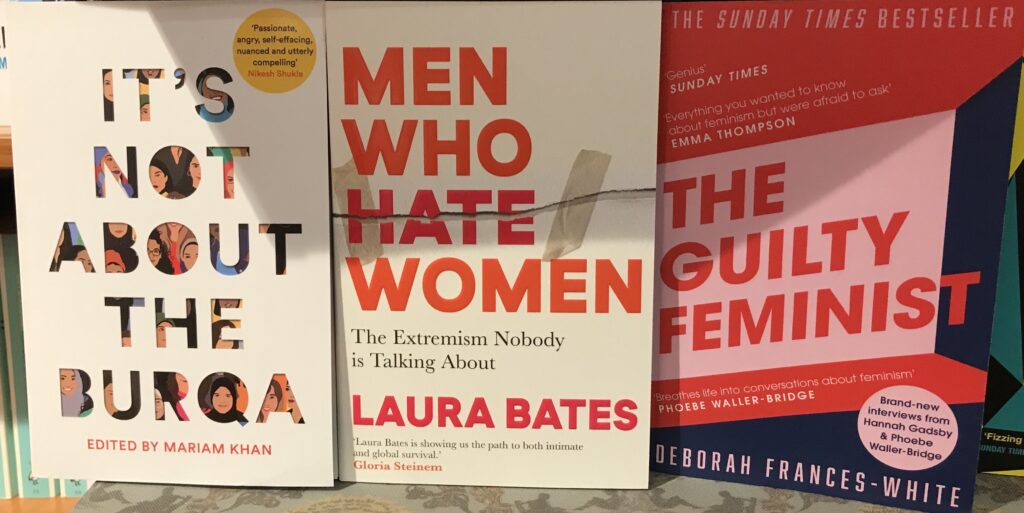
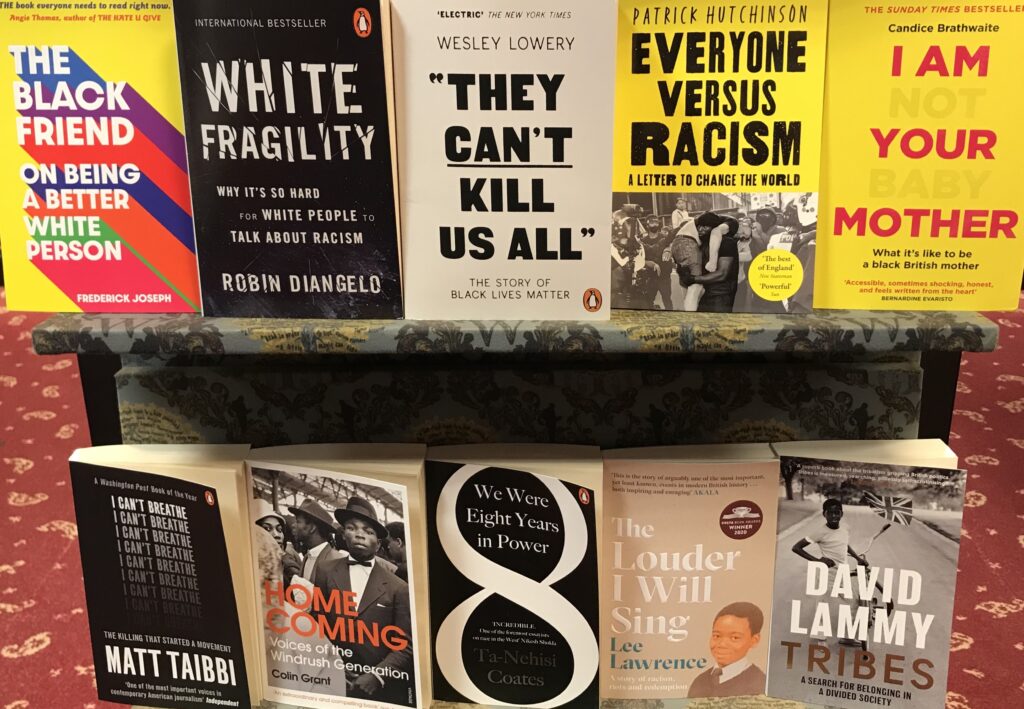
Some Castle April 28th 2021
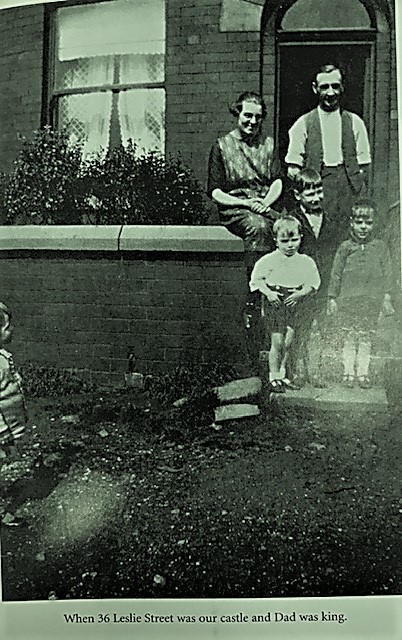
The latest excuse relates to lockdown. Police chief calls for power of entry into homes of suspected lockdown breakers
West Midlands police commissioner calls for ‘useful tool’ to enforce new national lockdown measures
Coronavirus – latest updates
See all our coronavirus coverage

Police community support officers in Leeds city centre after Boris Johnson announced further lockdown measures. Photograph: Danny Lawson/PA
Police say ,the government should toughen the lockdown by giving officers the right to force entry into homes of suspected law breakers, a policing leader has said.
David Jamieson, the police and crime commissioner for the West Midlands police, England’s second biggest force, said: “For the small minority of people who refuse entry to police officers and obstruct their work, the power of entry would seem to be a useful tool.
“I have raised this issue with the policing minister previously and clarity on the power of entry would help police officers enforce the new Covid regulations more easily.”
As the third lockdown comes into force in England at midnight on Wednesday, the rising infection rate is also causing increasing absences from the ranks of officers needed to help enforce the lockdown.
Most Mass Shooters ‘Dad-Deprived Males’: Author Warren Farrell Posted April 23rd 2021
By Zachary Stieber and Jan Jekielek April 22, 2021 Updated: April 22, 2021 biggersmallerPrint
Key commonalities for most mass shooters in the United States are that they are male and that they lack a father figure in their lives, author Warren Farrell says.
“There’s common denominators among mass shooters, the most obvious is that they’re male—98 percent are male. A second common denominator is that they’re almost all dad-deprived males,” Farrell told The Epoch Times’ “American Thought Leaders.”
People who carry out mass shootings at schools in particular tend to be boys who are suicidal, depressed, and dad-deprived.
In one example, a recent school shooter in Indianapolis did not have a father because in his early teens, his dad committed suicide. In another case, Stephen Paddock, who killed 58 in a mass shooting in Las Vegas, experienced his father imprisoned and went lengthy periods of time without seeing him. Adam Lanza, who authorities say opened fire in Newtown, Connecticut in 2012, also did not often see his father, who was divorced from his mother.
“What we think of when we think of mass shootings is the people who are hurt. We don’t realize that all of these people are hurt by boys who are hurt, who are deprived of their dads, who are feeling neglected and depressed,” said Farrell, the chair of the Coalition to Create a White House Council on Boys and Men.

In his research for his most recent book, “The Boy Crisis,” Farrell identified signs of boys being hurt, developing a list of 63 signs. He hopes the list, which he described as a “male depression-suicide inventory,” is used to question young people.
“Because if you have these experiences, these are red flags that the guidance counselors and psychologists in school should be paying attention to,” he said. “So for example, one of the questions that is on the inventory is, ‘do you feel that no one loves you? And no one needs you. And there’s no hope of that changing.’ So a boy who doesn’t feel loved? And who doesn’t feel needed? And feel that there’s no hope of that changing? That’s a huge red flag,” he said.
Examining the list in interactions with children could help prevent mass shootings, Farrell asserted, adding that boys who are depressed tend to act out, bullying others.
Most boys who have very troubled childhoods do not end up becoming mass shooters.
“It’s also very important to remember that when boys become mass shooters … I am not saying that they should not be fully punished and fully held accountable for this. It’s a heinous crime that has to be held fully accountable,” Farrell emphasized.
“I’m also saying, we care about protecting ourselves both from mass shootings, and also from the other things, that the crimes that the boys who are both dad-deprived and depressed and suicidal, tend to do. And if we’re going to prevent those things from happening, then we can catch the boy in the process of his grief and at the same time, save ourselves. So we have a win win situation.” Follow Zachary on Twitter: @zackstieberFollow Zachary on Parler: @zackstieber
Danger Signals April 11th 2021
I studied social sciences at the Univerity of East Anglia in the early 1970s – eventually majoring in economics following a good grounding in all of them. The key issue with all was grounding , verifying and evidence gathering. Marxism and concern for the under class was fashionable then.
Returning to post graduate study at London University in the late 1970s, I renewed an interest in psychology which had begun when I read one of my late father’s encyclopedias on the subject , then aged 12. Following his death I developed acute OCD and anxiety issues. Paying attention at school was an issue for me. I was bullied and didn’t want to be there.
Luckily , during my formative years alternating between a secure rural community and a snug North London community in the 1950s – where there was no shortage of role models regradless of our material poverty, I already had an advanced reading age. So in London , I combined studying to be a teacher with evening sessions on the part time MA Psychology course.
I never had the temerity to go through with plans to be an educational psychologist because I doubted my ability to use their methods to make an accurate safe assessment. So my note of caution regarding the following is based on a feeling that the real issue about girls and boys diagnosed as having ADHD , has much to do with society’s influencers using the education system for social engineering.
At Goldsmiths’ College, we were told that our mission in education was fighting sexism and racism by challenging racial and gender syereotypes. I took this all too seriously , leaving London for my native Buckinghamshire as one of the advanced guard warriors.
To cut a long story short, I took matters to their logical conclusion. In between universities , I had abandoned plans to become a military pilot for the mythical Britain I had grown up in. Infected by hippy unisex culture at the University of East Anglia , I was dismayed when a female officer psychiatrist told me the job might well resolve itself into me being required to kill without question.
Male and females of her exalted position do not get there without an identity based on social position and good education . The problem these days , and in the wider society, the rainbow multi culture world where we csn be whoever and whatever we like, offers no sound basis for choice or real choice given what young people have become in a world without secure role models. In short it is a con.
For my part , I took all of this gender identity choice too seriously , teaching and writing a book about it. My ex wife was not impressed – a complex and difficult subject in its own right. It is only relevant here because ,coming from an earlier age ADHD was the least of her problems.
As my marriage steadily failed miserably over several years , she was not happy when I started thinking I might have a female brain and should dress and modify behaviour accordingly. The outcome of her and other peoples responses was interesting to put it mildly. As an inveterate writer – though maybe not a good one – there was an element of experiment on my part.
The world of trnsgender has officially been closed to question and scrutiny but it won’t prevent prejudice , ostrcism nd socil punishment. No doubt experts are working on gender reassignments where patients may have full reproductive potential , meaning that in richer countries , gender may be a matter of choice. But gender alone is not a route to happiness or contentment. More of a problem for society is the nonsense that we can ignore nature while attempting to control it. Looking back over 18 years teaching , I saw the system shifting slowly at first, softening people up, toward outright brain washing. Now it is warp speed.
Economic and social change , outside of the Islamic world at the moment but coming to them soon , has broken traditional families and communities. Schools and media are working flat out for change. The problem here is that once docile girls are beginning to rebel , attracting the same ADHD label as the boys. Shut up with an ever more constrictive national curriculum and robotic target driven teachers in schools managed by gender/racial neutral super clones, they are expected to pay attention and absorb it all, shape shifting accordingly in mind , if not body.
For my own part , having gone to the analyst my ex wife insisted upon, I was told to find the ‘woman within’ on the basis of a book I had written. I have already said that I am an inveterate writer ( and photographer ) . So I took him seriously , monitoring my changes while planning a book on how the hero/heroine might contrive to have that woman within murdered – rough draft on this site.
Interestingly , I was told by the gender identity clinic that they could not complete the process until i agreed to anti psychotic drugs. These are basically zombie drugs, affecting motor control , bowel movements and memory. Maybe some are that desperate or ignorant in our poorly educate society to accept them.
It seems to me, that what we have in the following is more pseudo science, which I wasted years studying , to justify more spending to adapt young women to take seriously some very serious and unnatural diktats packaged as education for their own freedom.
‘The Divided Self ‘ Robert and Roberta Cook ( take your pick }
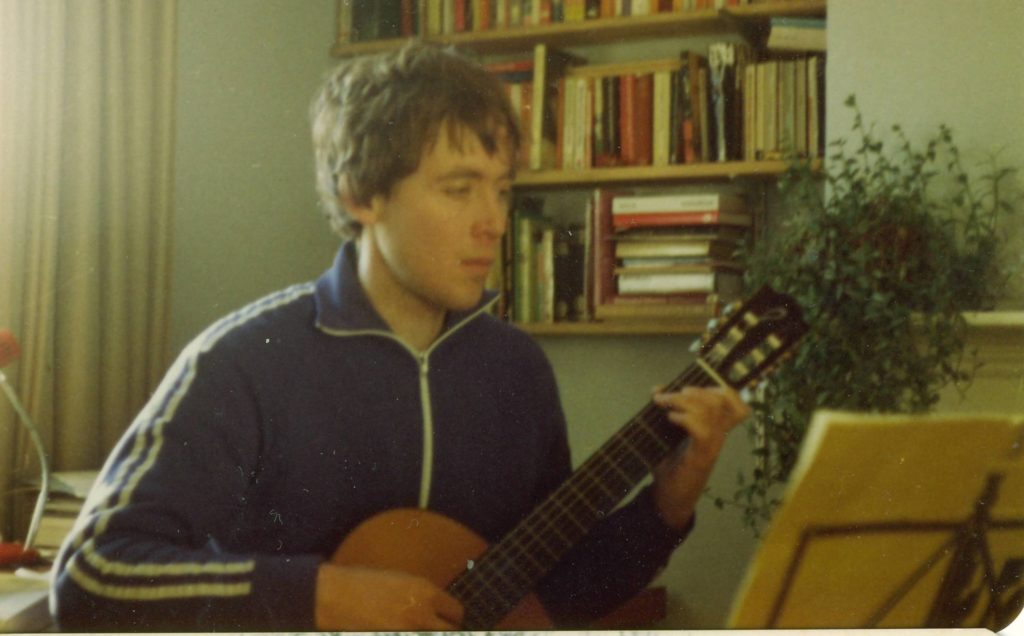
Image Appledene Photographics Archive.

So do all modern females need drugs to fit in with the ‘slave new world ?.’
Image Appledene Photographics/RJC
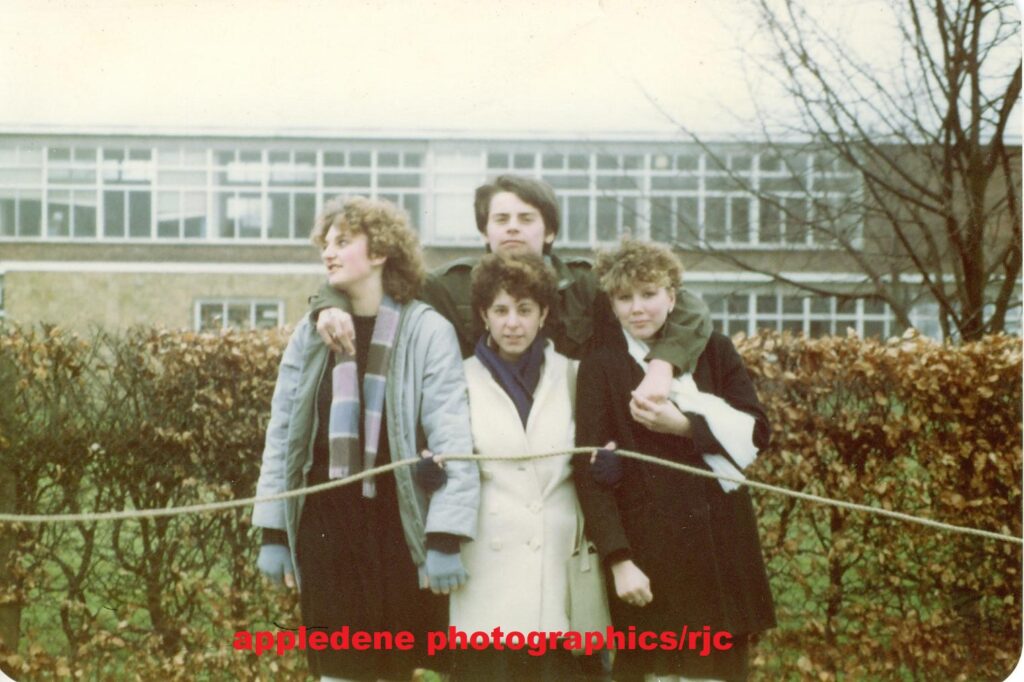
Decades of Failing to Recognize ADHD in Girls Has Created a “Lost Generation” of Women Posted April 11th 2021
Not the gender equality we had hoped for.
- Jenny Anderson
Read when you’ve got time to spare.
A painful discovery. Photo by Giada Fiorindi
Girls are closing one gender gap we don’t want: diagnoses of Attention deficit hyperactivity disorder (ADHD). Between 2003 and 2011, parents reported an increase of ADHD diagnoses of 55% for girls, compared to 40% for boys, according to a 2015 study in the Journal of Clinical Psychiatry.
And yet girls continue to be misdiagnosed in spades, with alarming consequences, Dr. Ellen Littman, clinical psychologist and co-author of Understanding Girls with AD/HD, tells Quartz. “The outcomes for girls are horrendously negative compared to boys,” she says.
ADHD materializes dramatically differently in girls.
“Anxiety and depression turn into low self-esteem and self-loathing, and the risk for self-harm and suicide attempts is four-to-five times that of girls without ADHD,” 2012 research shows.
“This is not about having trouble with their homework,” Littman says.
Unlike boys, many of whom show hyperactivity, girls’ symptoms veer more toward inattentiveness and disorganization. Girls tend to develop ADHD later than boys. They frequently mask it in an attempt to conform to society’s expectation that they be on the ball and organized. And while some ADHD symptoms can become less intense for boys after they pass through puberty, for many girls, it gets worse.
“I think we have a lost generation of women who are diagnosed with ADHD later in life, who have had to manage the condition on their own and deal with it on their own for the majority of their lives,” Michelle Frank, a clinical psychologist and ADHD expert, tells Quartz. “The diagnosis is a blessing and a curse: it’s a great relief, but they wonder what could have been different if they had only known.”
ADHD is Harder to Recognize in Girls
In Understanding Girls with AD/HD, Littman and her co-authors explain that ADHD was first diagnosed in young, white boys, with a key indicator being hyperactivity. As a result, guidelines were written around how it manifests in boys, and research is almost exclusively focused on boys (1% is specific to girls, Littman says).
It also materializes much later in girls, which was problematic when the American Psychiatric Association’s diagnosis criteria called for symptoms to be visible by age 7. It recently changed the age (pdf) to 12, allowing more girls to be captured.
Dr. Patricia Quinn, one of Littman’s co-authors on the book and a pediatrician in Washington, DC, who founded the National Center For Girls and Women With ADHD, told HuffPo Parents that girls’ symptoms include:
- a tendency toward daydreaming
- trouble following instructions
- making careless mistakes on homework and tests.
ADHD is a chronic neurobiological disorder which affects the brain structurally and chemically, as well as the ways in which various parts of the brain communicate with one another. It is highly heritable, says Frank.
Pressure to perform means many girls internalize their symptoms—disorganization or carelessness—as personal flaws rather than medical issues to be treated through medicine and therapy.
Girls with ADHD are significantly more likely to experience major depression, anxiety, and eating disorders than girls without. “They tend to have few friendships,” Littman says. “As a result of their low self-esteem, they often choose unhealthy relationships in which they may accept punitive criticism and or abuse.”
Teachers and parents often miss the warning signs because feeling disorganized or unfocused often leads to depression and anxiety. Failing to properly diagnose the condition, girls miss out on critical academic services and accommodations, as well as therapy and medication. Many girls end up misdiagnosed and treated with anti-anxiety or depression drugs, some of which exacerbate the effects of ADHD.
The Numbers
Progress is being made. Not long ago, the ratio of diagnosed boys vs. girls with attention-deficit hyperactivity disorder was 10 to 1. Today, it is somewhere between 4 to 1 and 2 to 1, Littman says.
According to the Journal of Clinical Psychiatry study, ADHD affected 7.3% of girls in 2011, compared to 16.5% for boys. Oddly, as awareness grows about ADHD in girls, there is evidence that boys are being wildly over-diagnosed with ADHD, including 17-year-old-boys who want extra time to complete the SAT for college applications.
“There’s no question it is both under-diagnosed and over-diagnosed,” Littman says.
This is not to say that millions of boys and men don’t have ADHD or suffer from the consequences of it.
“It’s important to remember that while we have to focus on increasing awareness and services to girls and women, boys and men are also profoundly affected by ADHD. We have a long way to go in addressing the immense stigma and gross misunderstanding that surrounds this diagnosis,” says Frank.
But Littman says the myths around ADHD and girls remain pervasive and she is deluged daily by people who are seeking help. “Girls are being told still by pediatricians and primary care doctors that ‘you are a girl, you can’t get ADD.” (ADHD includes the symptom of physical hyperactivity while ADD does not).
Women and ADHD
Other pernicious myths around ADHD include the perception that adult women, including successful professionals, can’t have ADHD.
Just the opposite. When the structure of school and college make way for the anarchy of balancing work and maybe having children, keeping ADHD at bay becomes harder.
Littman works with, and has studied, the impact of ADHD on high-IQ men and women, many of whom spent years masking their symptoms with their high abilities. As she tries to target if ADHD is the issue, she asks whether they are “constantly in a state of being overwhelmed and frantic about coping with day-to-day basic things?” Most burst into tears. “These are the people least likely to be acknowledged and because of the shame of feeling smart, they don’t feel they are entitled to help.”
Not surprisingly, she says, there are as many female as male patients in adult clinics. One study of ADHD medication showed women were the fast-growing population. Between 2008 and 2012, the number of Americans using medication to treat ADHD rose 36%; among women aged 26 to 34, the figure rose 85%.
Frank says even those who were diagnosed, though perhaps late, face serious longer-term consequences. “You can treat ADHD, you can get support and strategies, but the self-esteem challenges are going to be left over and you have to work at that for a lot longer.”
Personal stories have helped to raise awareness about the fact that girls can have ADHD, and that it presents itself differently. Maria Yagoda wrote in the Atlantic about being diagnosed as a junior at Yale:
My peers were also confused, and rather certain my psychiatrist was misguided. “Of course you don’t have ADHD. You’re smart,” a friend told me, definitively, before switching to the far more compelling topic: medication.“So are you going to take Adderall and become super skinny?” “Are you going to sell it?” “Are you going to snort it?”
The answer, clearly, was no.
“Medication is certainly not a cure-all, but when paired with the awareness granted by a diagnosis, it has rendered my symptoms more bearable—less unknown, less shameful,” she wrote.
Believe Her! The Woman Never Lies Myth Frank S. Zepezauer Posted April 5th 2021
| Believe Her! The Woman Never Lies Myth Frank S. Zepezauer* ABSTRACT: Empirical evidence does not support the widespread belief that women are extremely unlikely to make false accusations of male sexual misconduct. Rather the research on accusations of rape, sexual harassment, incest, and child sexual abuse indicates that false accusations have become a serious problem. The motivations involved in making a false report are widely varied and include confusion, outside influence from therapists and others, habitual lying, advantages in custody disputes, financial gain, and the political ideology of radical feminism. Male sexual misconduct — rape, incest, stalking, sexual harassment, child molestation, pornography trafficking — has, according to some observers, become a problem so big that it demands a big solution, not only the reform of our legal system but of our entire society. Yet the increasingly heated debate over this crisis has focused primarily on how these misbehaviors are defined and how often they occur. The estimated numbers keep mounting. We hear that perhaps 31 million women are suffering from some form of rape, 41 million from harassment, 58 million from child sexual abuse, and all 125 million of them — from toddlers to grandmothers — from a toxic “rape culture” that suffocates the feminine spirit. Much less discussed is how often an allegation of male sexual misconduct is false. The question seldom enters the debate because, presumably, it had long ago been settled. Pennsylvania State Law Professor Philip Jenkins (1993), in a review of the “feminist jurisprudence” which leads the sex crisis counterattack, reports that in response to the question its proponents have established an “unchallengeable orthodoxy.” It is that “women did not lie about such victimization, never lied, not out of personal malice, not from mental instability or derangement” (p.19). Jenkins is not the first to cite this will to believe. Wendy Kaminer (1993) reported that “it is a primary article of faith among many feminists that women don’t lie about rape, ever; they lack the dishonesty gene” (p.67). Eight years earlier, in 1985, John O’Sullivan discovered a widespread defense of the belief that “no woman would fabricate a rape charge” (p.22). Feminists themselves admit as much. Law Professor Susan Estrich stated that “the whole effort at reforming rape laws has been an attack on the premise that women who bring complaints are suspect” (Newsweek, 1985, p.61). Some feminists believe that even defending that premise is a sex crime. Alan Dershowitz (1993) reports that he was accused of sexual harassment for discussing in class the possibility of false rape allegations. Believing the self-proclaimed victim of sexual misconduct has thus evolved from ideological conviction to legal doctrine and, in some jurisdictions, into law. California now requires that jurors be explicitly told that a rape conviction can be based on the accuser’s testimony alone, without corroboration (Associated Press, 1992; Farrell, 1993). Canada is proposing that a man accused of rape must demonstrate that he received the willing consent of a sexual partner. These new rules rest on the assumption that women do not lie because they have no motive to lie. Consequently, as Jenkins (1993) states, the question of the “victim’s credibility” has now become “crucial.” Is that credibility warranted, particularly as feminist jurisprudence would want it established, as nearly automatic? Not if we consult recent history. And if we do, we will find that we do indeed face a sexual misconduct crisis, but not the one radical feminists now insist is ubiquitous in our society. False Accusations of Rape Begin with evidence of false accusation of rape, the crime which has become not only the metaphor for all cases of sexual misconduct but for male sexuality itself. Alan Dershowitz (1991), for example, has further harassed his students by telling them that an annual F.B.I. survey of 1600 law enforcement agencies discovered that 8% of rape charges are completely unfounded. That figure, which has held steadily over the past decade, is moreover at least twice as high as for any other felony. Unfounded charges of assault, which like rape is often productive of conflicting testimony, comprise only 1.6% of the total compared to the 8.4% recorded for rape. Consult also a recent development, DNA testing, which is now becoming routine in rape investigations (Krajik, 1993). Also routine is the discovery that a third of the DNA scans produce non-matches. Consequently, a growing number of men are not only gaining acquittals but are also being released from prison. As with all rape statistics, these figures need careful scrutiny. Police investigators warn, for example, that a mismatch proves innocence only when the DNA could have come from no one but the assailant and its profile or makeup doesn’t match the suspect’s. Even so, the DNA tests, primarily a prosecutorial weapon, have now been added to the arsenal of defense attorneys, and more evidence of false allegation is appearing. Although useful, the F.B.I. and DNA data on sex crimes result from unstructured number gathering. More informative, therefore, are the results of a focused study of the false allegation question undertaken by a team headed by Charles P McDowell (McDowell & Hibler, 1985) of the U.S. Air Force Special Studies Division. Its significance derives not only from its scholarly credentials but also its time of origin, 1984/85, a period during which rape had emerged as a major issue, but before its definition included almost any form of non-consensual sex. The McDowell team studied 556 rape allegations. Of that total, 256 could not be conclusively verified as rape. That left 300 authenticated cases of which 220 were judged to be truthful and 80, or 27%, were judged as false. In his report Charles McDowell stated that extra rigor was applied to the investigation of potentially false allegations. To be considered false one or more of the following criteria had to be met: the victim unequivocally admitted to false allegation, indicated deception in a polygraph test, and provided a plausible recantation. Even by these strict standards, slightly more than one out of four rape charges were judged to be false. The McDowell report has itself generated controversy even though, when rape is a frequent media topic, it is not widely known. Its calculations are no doubt problematic enough to raise serious questions. If, out of 556 rape allegations, 256 could not be conclusively verified as rape, then a large number, 46%, entered a gray area within which more than a few, if not all, of the accusations could have been authentic. If so, the 27% false allegation figure obtained from the remaining 300 cases could be badly skewed. Moreover, the study itself focused on a possibly non-representative population of military personnel. The McDowell team did in fact address these questions in follow-up studies. They recruited independent reviewers who were given 25 criteria derived from the profiles of the women who openly admitted making a false allegation. If all three reviewers agreed that the rape allegation was false, it was then listed by that description. The result: 60% of the accusations were identified as false. McDowell also took his study outside the military by examining police files from a major midwestern and a southwestern city. He found that the finding of 60% held (Farrell, 1993, pp. 321-329). McDowell’s data have received qualified confirmation from other investigators. A survey of seven Washington, D.C. area jurisdictions in the 1991/2 period, for example, revealed that an average of 24% of rape charges were unfounded (Buckley, 1992). A recently completed study of a small midwestern city was reported by Eugene J. Kanin (1994) of the Department of Sociology and Anthropology at Purdue University. Kanin concluded that “false rape allegations constitute 41% of the total forcible rape cases reported during this period” (p.81). Kanin provides significant confirmation of McDowell’s findings in several ways. Kanin’s subject, for example, covered a nine-year period — 1978-87 — during which rape had become a highly-politicized issue. Members of the police department from which the data was taken were therefore sensitive to the kinds of misperceptions about which parties to the dispute had complained. The city offered a relatively useful model: free of the unrepresentative populations found in resort areas, remote from the extreme crime conditions plaguing large communities, small enough to allow careful investigation of suspicious allegations, but large enough to produce a useful sample of 109 cases. The investigators also separated “unfounded” from “false” rape allegations, a distinction sometimes blurred in other reports. Moreover, among the strict guidelines used to determine an allegation’s unreliability was McDowell’s requirement that only unambiguous recantations be used. Equally revealing were addenda following Kanin’s basic report. They reported studies in two large Midwestern state universities which covered a three-year period ending in 1988. The finding of the combined studies was that among a total of 64 reported rapes exactly 50% were false. Kanin found these results significant because the women in the main report tended to gather in the lower socioeconomic levels, thus raising questions about correlations of false allegation with income and educational status. After checking figures gathered from university police departments, he therefore reported that “quite unexpectedly then, we find that these university women, when filing a rape complaint, were as likely to file a false as a valid charge.” In addition, Kanin cited still another source (Jay, 1991) which supported findings of high frequency false allegations in the universities. On the basis of these studies, Kanin felt it reasonable to conclude that “false rape accusations are not uncommon” (p.90). Sexual Harassment Alan Dershowitz’s experience with an esoteric definition of sexual harassment also raises questions about false allegations in this newly-defined but widely publicized crime. Skeptical checking has revealed that, as with rape, the percentage of unfounded accusations of sexual harassment may reach astonishingly high levels. That was the claim of Randy Daniels, whose confirmation for New York City’s Deputy Mayor was almost derailed by a sexual harassment charge he was able to refute. To see whether his experience was relatively rare, Daniels checked with the Equal Employment Opportunity Commission. He found that in 1991, the EEOC investigated or mediated 2119 cases of sexual harassment and found that 59% were determined to have no cause (Daniels, 1993, p. 1). Since the Hill/Thomas affair they have gone up sharply — up 64% in one year — but so have false allegations, remaining steadily in the plus 50% range. Child Sexual Abuse This rape and sexual harassment pattern — expanding definitions, rapidly increasing accusations, intensely politicized publicity campaigns, and significantly high percentages of false allegations — has also appeared in still another arena, the agencies which deal with the sexual molestation of children. With this kind of sexual misconduct the credibility of a third party, the child, becomes a factor, and we hear, in addition to appeals to “believe the woman” an appeal to “believe the child.” We are now learning that children can be manipulated into supplying dramatic testimony of sexual abuse and that in most cases the accusation originates not with the child but with the mother. Thus the question of credibility once again focuses on women. As one lawyer put it, “For a lot of these people ‘believe the child’ is just code. What they really mean is, ‘believe the woman, no questions asked”‘ (Stein, 1992, p. 160). To keep this issue in perspective, note three significant facts. The first is that of the 2,700,000 cases of child abuse reported every year less than 10% involve serious physical abuse and only 8% involve alleged sexual abuse (Schultz, 1989). The second is that, contrary to the male victimizer/female victim paradigm of feminist ideology, at least as many boys as girls are victimized by child abuse, if not more. The third is that the majority of child abusers are women, that the most dangerous environment for a child is a home formed by a single mother and her boyfriend, and the safest is formed by a married mother and a husband who is the child’s biological father.1 In many cases allegations of child sexual abuse occur in a nasty divorce made nastier by a custody fight. It is now so common that it has received scholarly attention and its own acronym, S.A.I.D. (Sexual Allegations in Divorce). The consensus is that in “S.A.I.D. syndrome” cases the number of such allegations increased so rapidly — up from 7 to 30% in the eighties — that one scholarly team called it an “explosion.” Others, noting how often the guilt of the accused was assumed, used the word “hysteria” and searched for analogies in the Salem and the McCarthy witch hunts (Stein, 1992). Another consensus is being reached: that the majority of these allegations are false. Melvin Guyer, Professor of Psychology at the University of Michigan, reports that “in highly contested custody cases where the allegation is made, a number of researchers have found the allegations to be false or unsubstantiated in anywhere from 60 to 80% of those cases ” (Felten, 1991). Another investigative team stated that of 200 cases they studied” about three-fourths have ultimately been adjudicated as no abuse” (Felten, 1991). Some studies have come in with a lower but still significant estimate. For example, a 1988 study by the Association of Family and Conciliation Courts said that sexual molestation charges in divorces are probably false one-third of the time (Dvorchak, 1992). Allegations of child abuse, both divorce related and in general, are flying out so frequently that those who believe themselves victimized by false charges have organized a nationwide support group, VOCAL (Victims Of Child Abuse Laws), which now includes 80 local chapters. This group refers its members to both informal and professional counsel, sends out a newsletter, and offers access to a rapidly expanding data base. In 1989, its summary of relevant statistics cited 23 studies which reported findings on both sexual and non-sexual child abuse. Among these, the lowest assessment of false allegation was 35%, the highest 82%, averaging at 66%. Recovered Memories Those joining VOCAL are finding that an even more dramatic form of child abuse allegation is now sweeping the country. It originates with a “recovered memory” of sexual atrocity, often involving incest or satanic ritual abuse, usually made by an adult daughter against her father, and almost always discovered in therapy. This form of allegation made the headlines when celebrities such as Roseanne Arnold, La Toya Jackson, and Suzanne Sommers declared they had suddenly remembered a long repressed victimization. It is also claiming celebrities among the accused, most notably Cardinal Bernardin of the Roman Catholic Church, which was however later recanted. In such cases the question of credibility applies not only to the accuser or accused but also to the therapist as well as the therapeutic technique and its supporting theory. Because cases of recovered memory of abuse have surfaced relatively recently, skeptical criticism is just now beginning to appear in the media although the underlying issues have been under debate for decades. One result has been the formation of an organization whose title already makes an assertion, the False Memory Syndrome Foundation. Thus to VOCAL we can add FMSF among the acronyms coined in response to the false allegation problem. It appears to be widespread. The FMSF reported that within two years of its founding in 1991, it had built a file of 12,000 families who believed themselves victimized by accusations prompted by false memories. Eleanor Goldstein (Goldstein & Farmer, 1992) estimates that the actual number of involved families reaches into the tens of thousands. She also cites data from the National Committee for the Prevention of Child Abuse on the highly inflated estimates of victimization. Contrary to statements that one in four women have been abused prior to the age of 18, retrospective surveys reveal great variations, from 6 to 62%, which means, Goldstein says, “that we don’t have any valid statistics at all” (p.2). How many of those reports of remembered child abuse, whether in the high or low range, were false? Several sources suggest that they may match figures on false allegations in reports of rape and sexual harassment. The National Center for Child Abuse reported that false allegations, which were 35% of all claims in 1975, had by 1993 reached 60% (FMSF Newsletter, 1993). Other sources suggest that the kind of child abuse caused by satanic ritual cults is almost totally a myth. There may be a satan and he may have followers but, contrary to widely held belief in the mid-eighties, they did not surface all over middle America. Where accusations actually led to trials, as in Jordan, Minnesota and in Los Angeles in the McMartin Preschool Case, prosecutors suffered embarrassing defeats. An extensive New Yorker report of a Washington State case reveals that at least one conviction was indeed achieved. However, after a careful analysis of the facts, the writer concludes that it was a grievous miscarriage of justice, one more ghastly example of the recovered memory theory gone amok (Wright, 1993). With regard to recovered memory cases which do not involve satanism, other indications point to a high number of false allegations. A strong phalanx of professional opinion has raised significant doubts about the veracity of long repressed memories even within a carefully disciplined therapeutic context. For that reason emphatic warnings are now being issued against their being used in a courtroom — not to mention a press conference — without persuasive corroboration, which, it appears, is often missing. Some mental health experts make the point more pungently. Dr. Paul Fink, head of Psychiatry at Albert Einstein Medical Center said, “If a therapist says 70 to 80% of patients remember abuse, I say the therapist ought to be a shoemaker” (Sifford, 1992). Dr. Richard Ofshe, a member of the FMSF professional advisory board who exposed the proliferating fallacies in the Washington State case, stated that “the incidence of cases in which repressed memories correspond with facts about abuse is as common as Siamese twins joined at the head” (Brzustowicz & Csicsery, 1993, p.8). Motivations of Accusers Even so, reasonable doubts about a woman’s veracity in all these often sensationalized sexual misconduct cases do not necessarily mean that she has deliberately lied. She may, for example, have suffered from confusion, a problem now proliferating as the definition for sex crimes becomes increasingly complicated and inclusive, leaving all parties struggling with questions about definition and propriety. Or she may have been affected by emotional instability or mental illness, which one study reported was a factor in 75% of false allegation in divorce cases (Wakefield & Underwager, 1990). In some cases a woman or her defenders might exaggerate a misdemeanor into a felony or, as happened in Washington state, translate bad parenting into sexual misconduct. In addition, there has been a tendency to emphasize what a victim felt rather than what happened. Thus, a woman can truthfully say she felt raped, abused or harassed by behavior which is actually non-criminal. Moreover, the woman’s feelings are often influenced by outside parties with whom she has confided — friends, family members, social workers, therapists, clergymen, rape counselors, lawyers, political activists — any of whom can interpret her emotion as a sign of felonious abuse. With regard to recovered memory, evidence published by the FMS Foundation suggests that the woman may be as much victimized by therapy or by recovery movement” enthusiasm as by a perpetrator hidden in her subconscious. Ericka Ingram, the primary accuser in the Washington State case, had come under the influence of both secular and religious counselors. Their intrusive encouragement helped to loosen a flood of wild charges she leveled against her father and mother as well as two of her father’s colleagues. These realizations have led to an increasing number of lawsuits now being filed by former patients against incompetent or overzealous therapists. By the same token, among the divorcing wives who file sexual molestation charges against their husbands are some who have been coached by self-serving lawyers. Columnist Barbara Amiel (1989) stated that “a lawyer is coming close to negligence if he does not advise a client that in child custody cases and property disputes, the mere mention of a child abuse allegation is a significant asset” (p.25). In The Morning After, Katie Roiphe (1993) reported still another cause of false allegations: political passions generated by activities such as the “Take Back the Night” marches. She tells about “Mindy” who so wanted to be a “part of this blanket warmth, this woman-centered nonhierarchical empowered notion” that she was “willing to lie” (pp. 40-41). A similar story was told by a Stanford University professor whose daughter was, he claimed, behind a conspiracy to murder him. He testified that he had had a good relationship with her until she attended an anti-rape rally. “She appeared to have gotten swept up … and was experiencing great emotional distress” (Wykes, 1993). These mitigating circumstances have often softened the judgment of authorities who confront women guilty of misrepresentation. In the Washington D.C. area, for example, police send women who lied about rape not to the court room but to a counseling center. The Princeton woman who accused a fellow student suffered no more than an obligation to write a public apology. Because of these sometimes compelling reasons for a departure from the truth, many officials hesitate to call a woman a liar. But it appears, some women with little or no evidence do not hesitate to call a man a rapist. It also appears that more than a few of them have in fact knowingly and willfully lied. Regardless of the influences working on Ericka Ingram, for example, there came a point when the evidence openly confounded her story, leaving her with the choice either to persist or recant. Because she not only persisted but further embellished her story, Richard Ofshe called her an “habitual liar” (Wright, 1993, p.69). Whether Anita Hill lied about Clarence Thomas still cannot be determined, but David Brock demonstrated that in several other matters she had indeed lied. And as Charles P. McDowell and other rape allegation researchers have discovered, at least one out of four women in their study population have openly admitted to having lied. Such disclosures should encourage skepticism toward the now widely held belief that, in accusations of sexual misconduct, women never lie. The same skepticism should be activated when we hear its supporting explanation: that filing such a charge is so painful that only a truthful woman would proceed. That belief, although equally strong, is equally suspect. The research that revealed how many sexual misconduct allegations are false has also revealed how often these unfounded accusations are strongly motivated. The clearest example of compelling motive can be found in the Sexual Allegation in Divorce (S.A.I.D.) syndrome. In such cases questionable allegations multiply because the accuser has far more to gain than to lose. Simply charging a divorcing spouse with child molestation — or wife battering or spousal rape — can turn a hot but evenly balanced custody battle into a rout. In many cases, the accused husband must vacate what had been the “family” home and submit to prolonged alienation from his children. He also finds himself ensnared by both the criminal justice and the social service bureaucracies whose conflicting rules of evidence can deny him the presumption of innocence. In a process that only a Kafka can describe, he must then devote his resources to defending himself rather than pursuing the original divorce litigation. Even then he may find himself in jail or in court ordered therapy while his accuser has won de facto custody not only of the children but of the house. Should he eventually win vindication, a process which can literally take years, he may enjoy at best a hollow victory which leaves him financially and emotionally drained, nursing a permanently injured reputation and functioning as an “absent” father with a sparse schedule of controlled visits. It is no wonder, then, that to express the reality commentators have sometimes used dramatic language, such as “the ultimate weapon” or the “atom bomb.” The impressive results that are so often easily achieved with false allegations in custody disputes suggest the kind of temptations women may feel in other situations. Among those found to have lied about rape or sexual harassment, for example, a number of motivations have been identified. The McDowell report listed those they uncovered in declining order of appearance. “Spite or revenge” and “to compensate for feelings of guilt or shame” accounted for 40% of such allegations (Farrell, 1993, p. 325). A small percentage were attributed to “mental/emotional disorder or attempted extortion.” In all cases, then, the falsely alleging woman had any of several strong motives to lie. But, as with the S.A.I.D. syndrome, the most common motive was anger, an emotion which prompts more than a few embattled women to reach for “the ultimate weapon. Although money gained through extortion ranked low among the motives for false rape allegations, it appears to rank higher when sexual harassment claims prove to be unfounded. A casual survey of some of the suits that have been filed suggests why. In the eighties, successful claims often brought damages in the $50,000 to $100,000 range. After the explosion ignited by the Hill/Thomas case, not only the number of claims but damage awards have skyrocketed. A clothing store cashier successfully sued her employer for $500,000. Employees of Stroh’s Brewery claimed that the company’s commercials, which showed the “Swedish Bikini Team,” constituted harassment and sued for damages ranging between $350,000 and $550,000. In the famous locker room harassment case, Lisa Olson was reported to have received a settlement ranging between $250,00 and $700,000. Damage claims — and awards — in the millions are becoming more common. In some cases which were later proved to be false, the financial stakes were particularly high. One lawyer was charged with coaching six of his clients to “embellish or lie” about some of the incidents on which they based a sexual harassment case. They had asked for $487,000 (Gonzales, 1993). Eleven women from the Miss Black America Pageant, after claiming that Mike Tyson had touched them on their rears, filed a $607 million lawsuit against him. Several of the contestants later admitted they had lied in the hope of getting publicity and cashing in on the award money which would have given them around $20 million each (Farrell, 1993, p.328). But where extortion does appear, the motivation may be political as well as monetary not only in particular cases but in the growth of the entire sexual misconduct crisis. Whether it is rape or sexual harassment or divorce-related child molestation or recovered incest memory, many of the investigators eventually mention the influence of ideological feminism. Katie Roiphe, for example, found feminist politics at work in the phony rape story invented by Mindy, the imaginative Princeton co-ed. Norman Podhoretz, who wrote about “Rape in Feminist Eyes,” attributes the current over-publicized obsession with rape to “the influence of man-hating elements within the (women’s) movement (which) has grown so powerful as to have swept all before it” (1992, p.29). As far back as 1985 John Sullivan attributed the overheated denial of false accusation to attempts to defend the “feminist theory of rape.” And Philip Jenkins (1993), who reported the trend toward automatically-assumed female credibility, stated that it was part of a larger campaign to establish “feminist jurisprudence.” Whatever their motivations in particular cases, there is little doubt that ideological feminists have achieved significant political gains from publicizing the sexual misconduct crisis. Lisa Olson’s feelings of harassment may for example have been genuine, but as the focus for a prolonged media event that established for female reporters an access to locker rooms it was as unpopular with the general public as it was with male athletes. The real Anita Hill may or may not have been lying, but the Hill/Thomas affair propelled sexual harassment into a hot issue that rapidly generated a subindustry of scholars, consultants, and bureaucrats, prompted a “Year of the Woman” campaign that helped several women into congress, and revived a flagging women’s movement. The same spectacular results may follow from the Tailhook Scandal, which, like Hill/Thomas, is raising serious questions about motive and credibility. Whether Paula Coughlin’s testimony will become as clouded as Anita Hill’s, her whistle-blowing has already scuttled the careers of a still growing number of naval officers, not to mention the Secretary of the Navy himself, intensified in-service anti-sexual harassment campaigns, reinforced an already strong feminist presence in the armed forces, and helped soften the military’s granitic opposition to women in combat. These incidents also helped to power a “Violence Against Women” bill through congress which will channel still more millions of government money into women’s programs, not to mention winning congressional validation of feminist jurisprudence. That’s a lot of political gain achieved by the words of a few women who suffered little more than an affront to their sensibilities. Conclusions This growing gap — between the anguish suffered by the victims of traditionally-defined sex crimes and what is suffered by victims of ideologically-defined crimes — suggests that the crisis we face is not the result of a sexual misconduct epidemic but of the crisis mentality itself, an ever more hysterical vision of a “rape culture.” It has a foundation in reality. In what has become a ritual disclaimer, those who have exposed the surprising number of false allegations of sexual misconduct have also admitted the appalling number of genuine accusations. And those who have attacked the incompetence, self-interest, and zealotry that has denied the extent of false allegation have also recognized the courage and energy that has exposed the problem of honest allegation begging vainly for belief. They have therefore applauded the effort to seek for this long ignored injustice both social and legal remediation. But that effort, carried too far and exploited too often, has generated another gap: between our awareness of the now highly visible victims of sexual misconduct and the almost invisible victims of false allegation. The lesser known victims have their own stories to tell, enough to reveal another long ignored injustice that demands remediation. False allegations of sexual misconduct have deprived a rapidly growing number of men and women of their reputations, their fortunes, their children, their livelihood, and their freedom; have wasted the time and money of countless tax-supported agencies; have destroyed not only individuals but entire families and communities; and have left some so desperate that they have taken their lives. For that reason, in the current revision of our sexual misconduct code, we must retain as a guiding premise the realization that women can lie because we know that, for several reasons, more than a few women have lied, more often than researchers into false allegation had expected, far more often than “rape culture” ideologues have admitted … too often, in any event, to be ignored by our jurisprudence, feminist or otherwise. Endnote 1. These assertions are themselves widely disputed. However, one of the most extensive studies on the subject, by Strauss and Gelles (1990) reports that for physical abuse, the rate is higher for mothers than for fathers: 17.7% for mothers vs. 10.1% for fathers. They found that preteen boys are slightly more likely to be abused than their sisters but that the pattern changes alter puberty. Strauss and Gelles, however, also refer to some contravening studies that show higher rates for fathers. Susan Steinmetz (1977/78) who has collaborated with Strauss and Gelles, reported independently that “mothers abused children 62% more often than fathers, and that male children were more than twice as likely to suffer physical injury” (p.499). David C. Morrow (1993) reports: “Drawing upon reports of the American Humane Association, the Association of Juvenile Courts, the National Center for the Prevention of Child Abuse, and the FBI’s 1978 crime report, John Rossler of Equal Rights for Fathers of New York State estimated that mothers commit over two-thirds of all child abuse, 80% of it in sole custody and none in joint custody situations, while boyfriends and new husbands perpetrate most of the rest. A similar study conducted a few years earlier in Utah by Ken Pangborn showed abuse 37% higher among single mothers than the general population and 67% of all abuse in the doing of women of whom 80% are single mothers.” Diane Russell (1986) reports that of adult women in San Francisco who reported one or more experiences of incestuous abuse, overall 4.5% were abused by a father (biological, step, foster or adoptive). But the abuse was much more likely to occur with a stepfather. Russell reports that 17% of the women who were raised by a stepfather were abused by him compared to 2% of the women who were raised by a biological father. This indicates the greater risk to a girl of growing up in a household without her biological father. Thomas Fleming (1986) cites a Canadian study that concluded that preschoolers were 40 times as likely to be abused in broken and illegitimate families as compared to those in intact two-parent families. The consensus thus appears to support the assertion that child abuse is much more common in single parent families or families missing the biological father, that women are more often the abusers, and that male children are more often the victims. [Back] References Amid, B. (1989, November 24). Feminism hits middle age. The National Review, p. 25. Associated Press (1992, May 8). Ruling favors victim’s word in rape cases. San Diego Union-Tribune. Brzustowicz, Jr., R. & Csicsery, G. P. (1993, January). The remembrance of crimes past. Heterodoxy, p.8. Buckley, S. (1992, June 27). Unfounded reports of rape confound area police investigators. The Washington Post, p. B-1. Daniels, R. (1993, May/June). Sexual harassment. Transitions (PO Box 129, Manhasset, New York, NY 11030, p. 1. Dershowitz, A. M. (1991, September). Justice. Penthouse, p. 52. Dershowitz, A. M. (1993, December). Sexual harassment. The Liberator, p. 22. Dvorchak, R. (1992, August 22). Sex abuse charge, “ultimate weapon” in custody cases. Houston Chronicle. Farrell, W. (1993). The Myth of Male Power ()()(). New York: Simon and Schuster. Felten, E. (1991, November 25). Divorce’s atom bomb: Child sex abuse. Insight, pp. 6-11, 34-36. Fleming, T. (1986). Uncommon properties. Chronicles. Reporting on Trend report, February. 1986, Rockford Institute, 934 N. Main Street, Rockford, IL 61103-7061. FMS Foundation Newsletter (1993, July 3). 3401 Market Street, Suite 130, Philadelphia. PA 19104. Goldstein, E., & Farmer, K. (1992). Confabulations (). Boca Raton, FL: Sirs Books. Gonzales, S. (1993, October 14). D.A.: Lawyer told sex-bias clients to lie. San Jose Mercury, p. 1B. Jay, D. R. (1991). Victimization on the college campus: A look at three high-profile cases. Campus Law Enforcement Journal, 35-37. Jenkins. P. (1993, October). Hard cases and bad law. Chronicles, p. 19. Kaminer, W. (1993, October). Feminism’s identity crisis. The Atlantic Monthly, p. 67. Kanin, E. J. (1994). False rape allegations. Archives of Sexual Behavior, 23(1), 81-92. Krajik, K. (1993, November 1). Genetics in the courtroom. Newsweek, p.64. McDowell, C. P., & Hibler, N. S. (1985). False allegations. Holland: Elsevier. Published for the Behavioral Science Unit, FBI Academy, Quantico, VA. Morrow, D. C. (1993). Toward Gynology. Aladdin’s Window, Issue # 3, Afterglow Publications, P.O. Box 399, Shingletown, CA 96088. Newsweek (1985, May 20). Rape and the law. p. 61. O’Sullivan, J. (1985, August). Rape in the New Age. American Spectator, p. 22. Podhoretz, N. (1992, November). Rape in feminist eyes. Commentary, p. 29. Roiphe, K. (1993). The Morning After: Sex, Fear and Feminism on Campus (). Boston: Little, Brown & Company. Russell, D. E. (1986). The Secret Trauma: Incest in the Lives of Girls and Women (). New York: Basic Books, Inc. Sifford, D. (1992, March 15). A special tribute. Philadelphia Inquirer. Stein, H. (1992, June). Presumed guilty. Playboy, pp. 74-76, 160-165. Steinmetz, S. K. (1977/78). The battered husband syndrome. Victimology, 2, p. 89. Strauss, M. A., & Gelles, R. J. (1990). Physical Violence in American Families ()(). New Brunswick, NJ: Transaction. Wakefield, H., & Underwager, IL (1990). Personality characteristics of parents making false accusations of sexual abuse in custody disputes. Issues In Child Abuse Accusations, 2(3), 121-l36. Wright, L. (1993, May 17 & 24). Remembering Satan: Part I & Part II. New Yorker, pp. 60-83, & 54-76. Wykes, S. L. (1992, December 9). “Plot” target says daughter changed. San Jose Mercury, p.1-B. * Frank S. Zepezauer is a teacher and writer at 1731 Wright Avenue, Sunnyvale, CA 94087. [Back] [Back to Volume 6, Number 2] [Other Articles by this Author] |
Page Boy Posted by R.J Cook March 25th 2021
Elliot Page doesn’t remember exactly how long he had been asking.
But he does remember the acute feeling of triumph when, around age 9, he was finally allowed to cut his hair short. “I felt like a boy,” Page says. “I wanted to be a boy. I would ask my mom if I could be someday.” Growing up in Halifax, Nova Scotia, Page visualized himself as a boy in imaginary games, freed from the discomfort of how other people saw him: as a girl. After the haircut, strangers finally started perceiving him the way he saw himself, and it felt both right and exciting.
The joy was short-lived. Months later, Page got his first break, landing a part as a daughter in a Canadian mining family in the TV movie Pit Pony. He wore a wig for the film, and when Pit Pony became a TV show, he grew his hair out again. “I became a professional actor at the age of 10,” Page says. And pursuing that passion came with a difficult compromise. “Of course I had to look a certain way.”
We are speaking in late February. It is the first interview Page, 34, has given since disclosing in December that he is transgender, in a heartfelt letter posted to Instagram, and he is crying before I have even uttered a question. “Sorry, I’m going to be emotional, but that’s cool, right?” he says, smiling through his tears.
It’s hard for him to talk about the days that led up to that disclosure. When I ask how he was feeling, he looks away, his neck exposed by a new short haircut. After a pause, he presses his hand to his heart and closes his eyes. “This feeling of true excitement and deep gratitude to have made it to this point in my life,” he says, “mixed with a lot of fear and anxiety.”
It’s not hard to understand why a trans person would be dealing with conflicting feelings in this moment. Increased social acceptance has led to more young people describing themselves as trans—1.8% of Gen Z compared with 0.2% of boomers, according to a recent Gallup poll—yet this has fueled conservatives who are stoking fears about a “transgender craze.” President Joe Biden has restored the right of transgender military members to serve openly, and in Hollywood, trans people have never had more meaningful time onscreen. Meanwhile, J.K. Rowling is leveraging her cultural capital to oppose transgender equality in the name of feminism, and lawmakers are arguing in the halls of Congress over the validity of gender identities. “Sex has become a political football in the culture wars,” says Paisley Currah, a professor of political science at Brooklyn College.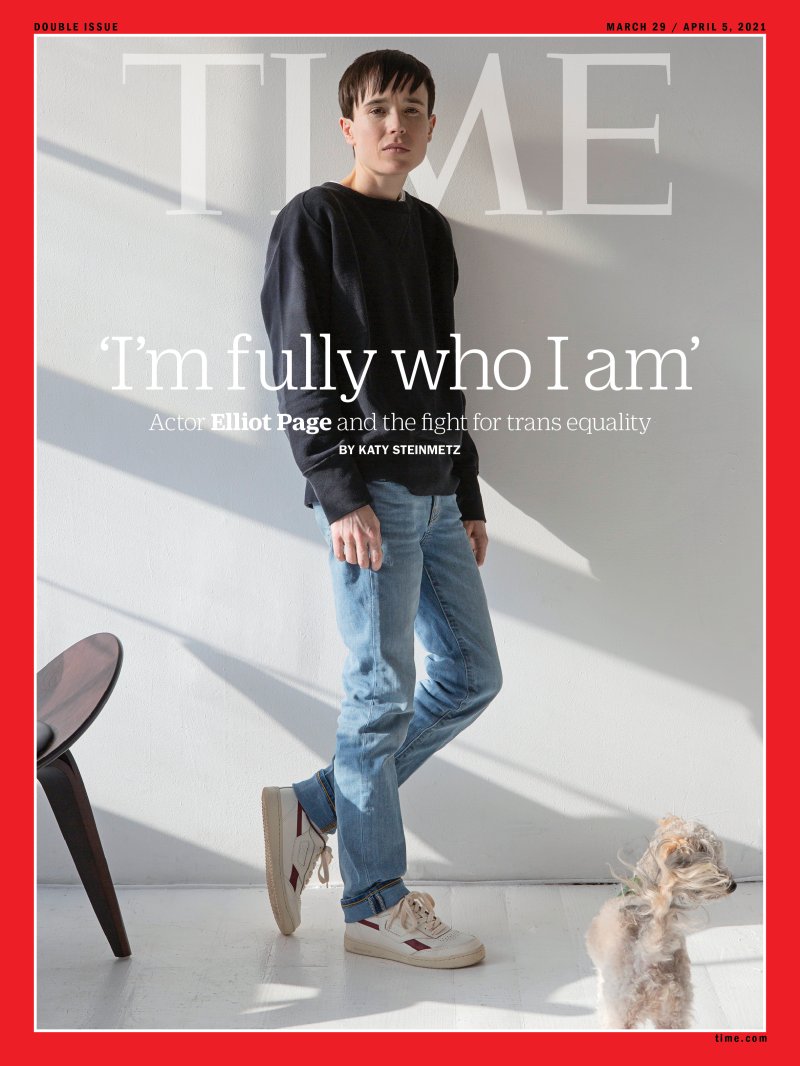 Photograph by Wynne Neilly for TIME
Photograph by Wynne Neilly for TIME
And so Page—who charmed America as a precocious pregnant teenager in Juno, constructed dreamscapes in Inception and now stars in Netflix’s hit superhero show The Umbrella Academy, the third season of which he’s filming in Toronto—expected that his news would be met with both applause and vitriol. “What I was anticipating was a lot of support and love and a massive amount of hatred and transphobia,” says Page. “That’s essentially what happened.” What he did not anticipate was just how big this story would be. Page’s announcement, which made him one of the most famous out trans people in the world, started trending on Twitter in more than 20 countries. He gained more than 400,000 new followers on Instagram on that day alone. Thousands of articles were published. Likes and shares reached the millions. Right-wing podcasters readied their rhetoric about “women in men’s locker rooms.” Casting directors reached out to Page’s manager saying it would be an honor to cast Page in their next big movie.
So, it was a lot. Over the course of two conversations, Page will say that understanding himself in all the specifics remains a work in progress. Fathoming one’s gender, an identity innate and performed, personal and social, fixed and evolving, is complicated enough without being under a spotlight that never seems to turn off. But having arrived at a critical juncture, Page feels a deep sense of responsibility to share his truth. “Extremely influential people are spreading these myths and damaging rhetoric—every day you’re seeing our existence debated,” Page says. “Transgender people are so very real.”
***
That role in Pit Pony led to other productions and eventually, when Page was 16, to a film called Mouth to Mouth. Playing a young anarchist, Page had a chance to cut his hair again. This time, he shaved it off completely. The kids at his high school teased him, but in photos he has posted from that time on social media he looks at ease. Page’s head was still shaved when he mailed in an audition tape for the 2005 thriller Hard Candy. The people in charge of casting asked him to audition again in a wig. Soon, the hair was back.
Page’s tour de force performance in Hard Candy led, two years later, to Juno, a low-budget indie film that brought Page Oscar, BAFTA and Golden Globe nominations and sudden megafame. The actor, then 21, struggled with the stresses of that ascension. The endless primping, red carpets and magazine spreads were all agonizing reminders of the disconnect between how the world saw Page and who he knew himself to be. “I just never recognized myself,” Page says. “For a long time I could not even look at a photo of myself.” It was difficult to watch the movies too, especially ones in which he played more feminine roles.
Page loved making movies, but he also felt alienated by Hollywood and its standards. Alia Shawkat, a close friend and co-star in 2009’s Whip It, describes all the attention from Juno as scarring. “He had a really hard time with the press and expectations,” Shawkat says. “‘Put this on! And look this way! And this is sexy!’”
By the time he appeared in blockbusters like X-Men: The Last Stand and Inception, Page was suffering from depression, anxiety and panic attacks. He didn’t know, he says, “how to explain to people that even though [I was] an actor, just putting on a T-shirt cut for a woman would make me so unwell.” Shawkat recalls Page’s struggles with clothes. “I’d be like, ‘Hey, look at all these nice outfits you’re getting,’ and he would say, ‘It’s not me. It feels like a costume,’” she says. Page tried to convince himself that he was fine, that someone who was fortunate enough to have made it shouldn’t have complaints. But he felt exhausted by the work required to “just exist,” and thought more than once about quitting acting.
In 2014, Page came out as gay, despite feeling for years that “being out was impossible” given his career. (Gender identity and sexual orientation are, of course, distinct, but one queer identity can coexist with another.) In an emotional speech at a Human Rights Campaign conference, Page talked about being part of an industry “that places crushing standards” on actors and viewers alike. “There are pervasive stereotypes about masculinity and femininity that define how we’re all supposed to act, dress and speak,” Page went on. “And they serve no one.”
The actor started wearing suits on the red carpet. He found love, marrying choreographer Emma Portner in 2018. He asserted more agency in his career, producing his own films with LGBTQ leads like Freeheld and My Days of Mercy. And he made a masculine wardrobe a condition of taking roles. Yet the daily discord was becoming unbearable. “The difference in how I felt before coming out as gay to after was massive,” says Page. “But did the discomfort in my body ever go away? No, no, no, no.”
***
In part, it was the isolation forced by the pandemic that brought to a head Page’s wrestling with gender. (Page and Portner separated last summer, and the two divorced in early 2021. “We’ve remained close friends,” Page says.) “I had a lot of time on my own to really focus on things that I think, in so many ways, unconsciously, I was avoiding,” he says. He was inspired by trailblazing trans icons like Janet Mock and Laverne Cox, who found success in Hollywood while living authentically. Trans writers helped him understand his feelings; Page saw himself reflected in P. Carl’s memoir Becoming a Man. Eventually “shame and discomfort” gave way to revelation. “I was finally able to embrace being transgender,” Page says, “and letting myself fully become who I am.”
This led to a series of decisions. One was asking the world to call him by a different name, Elliot, which he says he’s always liked. Page has a tattoo that says E.P. PHONE HOME, a reference to a movie about a young boy with that name. “I loved E.T. when I was a kid and always wanted to look like the boys in the movies, right?” he says. The other decision was to use different pronouns—for the record, both he/him and they/them are fine. (When I ask if he has a preference on pronouns for the purposes of this story, Page says, “He/him is great.”)
A day before we first speak, Page will talk to his mom about this interview and she will tell him, “I’m just so proud of my son.” He grows emotional relating this and tries to explain that his mom, the daughter of a minister, who was born in the 1950s, was always trying to do what she thought was best for her child, even if that meant encouraging young Page to act like a girl. “She wants me to be who I am and supports me fully,” Page says. “It is a testament to how people really change.”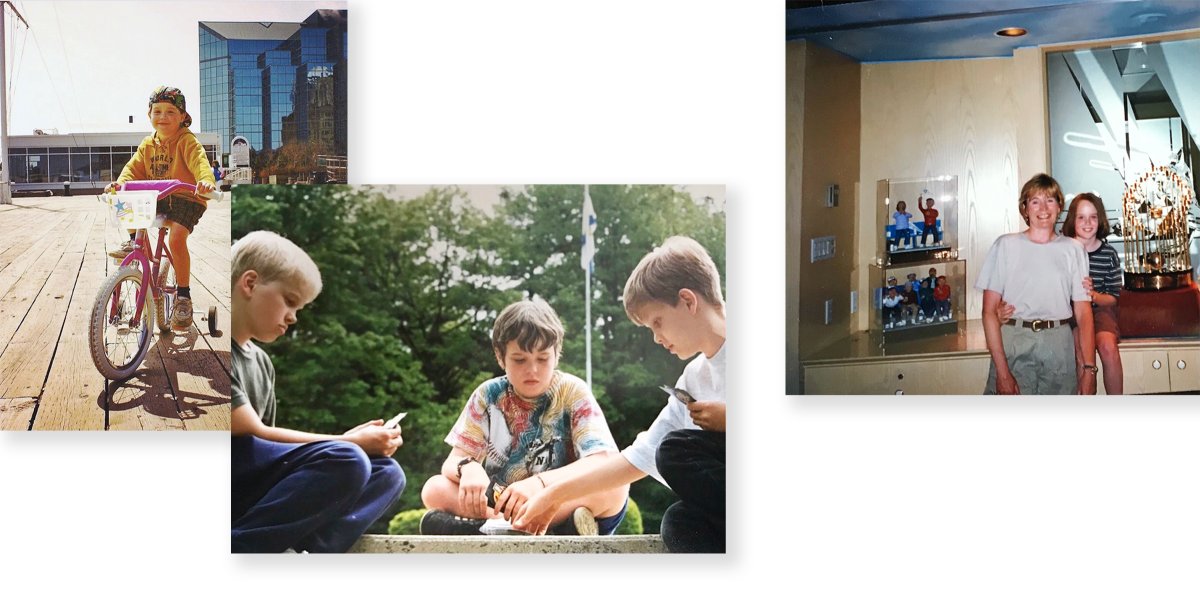 These photos, courtesy of Page—from left, at age 5, 10 and 7—show him as he wanted to be seen Courtesy Elliot Page
These photos, courtesy of Page—from left, at age 5, 10 and 7—show him as he wanted to be seen Courtesy Elliot Page
Another decision was to get top surgery. Page volunteers this information early in our conversation; at the time he posted his disclosure on Instagram, he was recovering in Toronto. Like many trans people, Page emphasizes being trans isn’t all about surgery. For some people, it’s unnecessary. For others, it’s unaffordable. For the wider world, the media’s focus on it has sensationalized transgender bodies, inviting invasive and inappropriate questions. But Page describes surgery as something that, for him, has made it possible to finally recognize himself when he looks in the mirror, providing catharsis he’s been waiting for since the “total hell” of puberty. “It has completely transformed my life,” he says. So much of his energy was spent on being uncomfortable in his body, he says. Now he has that energy back.
***
For the transgender community at large, visibility does not automatically lead to acceptance. Around the globe, transgender people deal disproportionately with violence and discrimination. Anti-trans hate crimes are on the rise in the U.K. along with increasingly transphobic rhetoric in newspapers and tabloids. In the U.S., in addition to the perennial challenges trans people face with issues like poverty and homelessness, a flurry of bills in state legislatures would make it a crime to provide transition-related medical care to trans youth. And crass old jokes are still in circulation. When Biden lifted the ban on open service for transgender troops, Saturday Night Live’s Michael Che did a bit on Weekend Update about the policy being called “don’t ask, don’t tuck.”
Page says coming out as trans was “selfish” on one level: “It’s for me. I want to live and be who I am.” But he also felt a moral imperative to do so, given the times. Human identity is complicated and mysterious, but politics insists on fitting everything into boxes. In today’s culture wars, simplistic beliefs about gender—e.g., chromosomes = destiny—are so widespread and so deep-seated that many people who hold those beliefs don’t feel compelled to consider whether they might be incomplete or prejudiced. On Feb. 24, after a passionate debate on legislation that would ban discrimination against LGBTQ people, Representative Marie Newman, an Illinois Democrat, proudly displayed the pride flag in support of her daughter, who is trans. Representative Marjorie Taylor Greene, a Georgia Republican, responded by hanging a poster outside her office that read: There are TWO genders: MALE & FEMALE.
The next day Dr. Rachel Levine, who stands to become the first openly transgender federal official confirmed by the Senate, endured a tirade from Senator Rand Paul about “genital mutilation” during her confirmation hearing. My second conversation with Page happens shortly after this. He brings it up almost immediately, and seems both heartbroken and determined. He wants to emphasize that top surgery, for him, was “not only life-changing but lifesaving.” He implores people to educate themselves about trans lives, to learn how crucial medical care can be, to understand that lack of access to it is one of the many reasons that an estimated 41% of transgender people have attempted suicide, according to one survey.
Page has been in the political trenches for a while, having leaned into progressive activism after coming out as queer in 2014. For two seasons, he and best friend Ian Daniel filmed Gaycation, a Viceland series that explored LGBTQ culture around the world and, at one point, showed Page grilling Senator Ted Cruz at the Iowa State Fair about discrimination against queer people. In 2019, Page made a documentary called There’s Something in the Water, which explores environmental hardships experienced by communities of color in Nova Scotia, with $350,000 of his own money. That activism extends to his own industry: in 2017, he published a Facebook post that, among other things, accused director Brett Ratner of forcibly outing him as gay on the set of an X-Men movie. (A representative for Ratner did not respond to a request for comment.)
As a trans person who is white, wealthy and famous, Page has a unique kind of privilege, and with it an opportunity to advocate for those with less. According to the U.S. Trans Survey, a large-scale report from 2015, transgender people of color are more likely to experience unemployment, harassment by police and refusals of medical care. Nearly half of all Black respondents reported being denied equal treatment, verbally harassed and/or physically attacked in the past year. Trans people as a group fare much worse on such stats than the general population. “My privilege has allowed me to have resources to get through and to be where I am today,” Page says, “and of course I want to use that privilege and platform to help in the ways I can.” Wynne Neilly for TIME
Wynne Neilly for TIME
Since his disclosure, Page has been mostly quiet on social media. One exception has been to tweet on behalf of the ACLU, which is in the midst of fighting anti-trans bills and laws around the country, including those that ban transgender girls and women from participating in sports. Mississippi Governor Tate Reeves says he will sign such a bill in the name of “protect[ing] young girls.” Page played competitive soccer and vividly recalls the agony of being told he would have to play on the girls’ team once he aged out of mixed-gender squads. After an appeal, Page was allowed to play with the boys for an additional year. Today, several bills list genitalia as a requirement for deciding who plays on which team. “I would have been in that position as a kid,” Page says. “It’s horrific.”
All this advocacy is unlikely to make life easier. “You can’t enter into certain spaces as a public trans person,” says Chase Strangio, deputy director for transgender justice at the ACLU, “without being prepared to spend some percentage of your life being threatened and harassed.” Yet, while he seems overwhelmed at times, Page is also eager. Many of the political attacks on trans people—whether it is a mandate that bathroom use be determined by birth sex, a blanket ban on medical interventions for trans kids or the suggestion that trans men are simply wayward women beguiled by male privilege—carry the same subtext: that trans people are mistaken about who they are. “We know who we are,” Page says. “People cling to these firm ideas [about gender] because it makes people feel safe. But if we could just celebrate all the wonderful complexities of people, the world would be such a better place.”
***
Even if Page weren’t vocal, his public presence would communicate something powerful. That is in part because of what Brooklyn College’s Currah calls “visibility gaps.” Historically, trans women have been more visible, in culture and in Hollywood, than trans men. There are many explanations: Our culture is obsessed with femininity. Men’s bodies are less policed and scrutinized. Patriarchal people tend to get more emotional about who is considered to be in the same category as their daughters. “And a lot of trans men don’t stand out as trans,” says Currah, who is a trans man himself. “I think we’ve taken up less of the public’s attention because masculinity is sort of the norm.”
During our interviews, Page will repeatedly refer to himself as a “transgender guy.” He also calls himself nonbinary and queer, but for him, transmasculinity is at the center of the conversation right now. “It’s a complicated journey,” he says, “and an ongoing process.”
While the visibility gap means that trans men have been spared some of the hate endured by trans women, it has also meant that people like Page have had fewer models. “There were no examples,” Page says of growing up in Halifax in the 1990s. There are many queer people who have felt “that how they feel deep inside isn’t a real thing because they never saw it reflected back to them,” says Tiq Milan, an activist, author and transgender man. Page offers a reflection: “They can see that and say, ‘You know what, that’s who I am too,’” Milan says. When there aren’t examples, he says, “people make monsters of us.”
For decades, that was something Hollywood did. As detailed in the 2020 Netflix documentary Disclosure, transgender people have been portrayed onscreen as villainous and deceitful, tragic subplots or the butt of jokes. In a sign of just how far the industry has come—spurred on by productions like Pose and trailblazers like Mock—Netflix offered to change the credits on The Umbrella Academy the same day that its star posted his statement on social media. Now when an episode ends, the first words viewers see are “Elliot Page.”
Today, there are many out trans and nonbinary actors, directors and producers. Storylines involving trans people are more common, more respectful. Sometimes that aspect of identity is even incidental, rather than the crux of a morality tale. And yet Hollywood can still seem a frightening place for LGBTQ people to come out. “It’s an industry that says, ‘Don’t do that,’” says director Silas Howard, who got his break on Amazon’s show Transparent, which made efforts to hire transgender crew members. “I wouldn’t have been hired if they didn’t have a trans initiative,” Howard says. “I’m always aware of that.”
So what will it mean for Page’s career? While Page has appeared in many projects, he also faced challenges landing female leads because he didn’t fit Hollywood’s narrow mold. Since Page’s Instagram post, his team is seeing more activity than they have in years. Many of the offers coming in—to direct, to produce, to act—are trans-related, but there are also some “dude roles.” Downtime in quarantine helped Page accept his gender identity. “I was finally able to embrace being transgender,” he says Wynne Neilly for TIME
Downtime in quarantine helped Page accept his gender identity. “I was finally able to embrace being transgender,” he says Wynne Neilly for TIME
Page was attracted to the role of Vanya in The Umbrella Academy because—in the first season, released in 2019—Vanya is crushed by self-loathing, believing herself to be the only ordinary sibling in an extraordinary family. The character can barely summon the courage to move through the world. “I related to how much Vanya was closed off,” Page says. Now on set filming the third season, co-workers have seen a change in the actor. “It seems like there’s a tremendous weight off his shoulders, a feeling of comfort,” says showrunner Steve Blackman. “There’s a lightness, a lot more smiling.” For Page, returning to set has been validating, if awkward at times. Yes, people accidentally use the wrong pronouns—“It’s going to be an adjustment,” Page says—but co-workers also see and acknowledge him.
The debate over whether cisgender people, who have repeatedly collected awards for playing trans characters, should continue to do so has largely been settled. However, trans actors have rarely been considered for cisgender parts. Whatever challenges might lie ahead, Page seems exuberant about playing a new spectrum of roles. “I’m really excited to act, now that I’m fully who I am, in this body,” Page says. “No matter the challenges and difficult moments of this, nothing amounts to getting to feel how I feel now.”
This includes having short hair again. During our interview, Page keeps rearranging strands on his forehead. It took a long time for him to return to the barber’s chair and ask to cut it short, but he got there. And how did that haircut feel?
Page tears up again, then smiles. “I just could not have enjoyed it more,” he says.
—With reporting by Leslie Dickstein and Simmone Shah
Grooming by Jodi Urichuk for L’Oréal Paris/Plutino Group and Joseph Santiago at Sassoon Academy Toronto
Correction, March 16
The original version of this story misstated Elliot Page’s age in a childhood photo. He was 10, not six. Additionally, the quote, “Sex has become a political football in the culture wars,” was misattributed to Chase Strangio. It was spoken by Paisley Currah.

Liberation at 30,000 Feet: On the Freedom of Early Airline Stewardesses
Sarah Menkedick Examines the False Choice Between Femininity and Power Posted March 22nd 2022

Part nurse, part waitress, part savior, part seductress, the airline stewardess was both a character conjured from male fantasy and an avatar of an era of unprecedented female freedom. As Julia Cooke describes in her recently released book Come Fly the World: The Jet-Age Story of the Women of Pan Am, most stewards in the early days of air travel were men, but as the jet age bloomed in the mid-20th century, airline executives grasped and advertised the appeal of a certain type of young woman who could emit an alchemical mix of glamour, cosmopolitanism, know-how, and adventure. Cooke quotes Pan Am’s chief executive, Najeeb Halaby, on the company’s efforts to outdazzle its rapidly multiplying competition: “We must add to [our excellence] ‘a new dimension’–that is, emphasis on what pleases people. And I know of nothing that pleases people more… than female people.”
These “female people” were designed, down to the length of their bobs, the arc of their eyebrows, and the very shade of their lipstick (“lavender, purple, orange, insipid pink, iridescent or flesh color” were not permitted, since, psychiatrists explained in a memo, outrageous makeup signaled emotional disturbance) to attract wealthy men. They were made into props and enticements—objects, to such an extent that National Airlines actually ran an ad campaign in the 1970s announcing “Fly Me” with a photo of a smiling stewardess, as if she herself were the plane.
But of course, as Cooke depicts with elegance and intricacy and nuance, these women were not objects; they were complicated individuals and ironic figureheads of a new era of women’s liberation. Yes, some starved themselves for weeks with canned tuna and boiled eggs to make “weight checks”; yes, they dealt with harassment and couldn’t choose their own color of nail polish. But during an era when single women were refused service at mainstream establishments in major US cities, when two-thirds of women were married by age 24, when many girls grew up forbidden from wearing pants, stewardesses were roaming the world, traveling together to Himalayan glaciers; dancing all night at bars in Nairobi; exploring Mexican markets and Parisian arrondissements, living by themselves or with other single women, and by golly, wearing jeans. Cooke profiles one stewardess who, wretched with heartbreak, agrees at the spur of the moment to crew a ragged boat across the Pacific.
Another, one of a small number of Black stewardesses—who had to fight for equal treatment from the airlines, and who were the targets of frequent acts of racism from both their colleagues and their institutions—develops an unlikely love for Moscow, going to the Bolshoi Ballet, accompanying scouts to circuses, wandering the city in cowboy boots. One stewardess named Lynne, a biology major deeply skeptical of what she perceives as the superficiality and frivolity of stewardess work, ends up getting hired and discovers she loves it; in a scene Cooke details in the latter half of the book, Lynne finds herself defending the profession to a male passenger. He sees her reading Scientific American and remarks, “Wouldn’t Vogue be a better magazine for you to read?” to which she replies that she studied biology in college and speaks multiple languages. Cooke points out that in the 1960s, only six to eight percent of American women graduated from college, but ten percent of Pan Am stewardesses had attended graduate school.
These statistics clearly startled the male passenger in the 1960s, but they also startled me today. What does that say about the way I think about what we now call “flight attendants”? Now, they are a much more diverse group, in race and gender, but they are arguably still strongly associated with their stereotype: a particular female representation of servitude and (tame, quasi-maternal) sexiness. I could see reading the book that I’d had this default notion in mind, even though the first person to inspire me to travel was in fact a female flight attendant. We’d worked together at a coffee shop in Madison, Wisconsin, where she told me about hitchhiking all over Indonesia and meeting her husband, who was selling friendship bracelets on the beach. She lived in his beachside house for nine months before they moved back to the US together, where they’d eventually start a highly successful Indonesian food cart. When I traveled to South America and later South Africa, our paths coincided: we smoked cigarettes on a park bench in Lima at midnight and hiked along a rugged stretch of coastline near the Cape of Good Hope. She was the wildest woman I knew; she took that South Africa trip with advanced breast cancer, knowing she would die, choosing to travel rather than spend her last days in a hospital. I never thought of her as a flight attendant. But she loved that work. It had made her who she was. What does it mean to be both female and empowered in a society that sees femininity as opposed to power?
Cooke’s book interweaves narrative, history, and commentary on changing gender norms and politics, and it comes at a moment when we seem to be reckoning, once again, with female representation. How should a woman be? More importantly, how should a free woman be?
The answers to these questions aren’t merely individual choices: the way a woman chooses to represent herself in relationship to her femininity and potential freedom (two categories very much at odds) ultimately implicates, validates, or threatens the choices of all other women. There are many ways to show up as a man, and it often seems all of them—even the most hideous pussy-grabbing iterations—are equally valid. Yet more than a half-century after Cooke’s stewardesses were weighed and outfitted and manicured for male desire, a woman is offered a stark choice between femininity and freedom—that choice is often false, for the freedom is never truly such and the femininity can in fact be freeing, but it will almost always be damning. Despite the ways in which her “female” roles may overlap with ones that we might consider more “liberated,” despite the complications of liberation being defined almost exclusively in male terms and the female being perpetually marginalized as trivial, she will still be forced to side more with one than the other, and to accept the subsequent judgment.
In April of 2017, I wrote an op-ed in which I argued that birth should be a subject of major literary significance; that is, instead of dismissing women who write about motherhood as insignificant or precious or fringe, and shelving their books in the children’s section, we should approach birth with the fascination and complexity and reverence with which we study, say, war.
I received many emails from women who said they’d long felt too afraid to create work about motherhood and appreciated the encouragement to push back against the double standard in which men writing about family life can be celebrated as artistic lions while women are promptly ushered into the literary dead zone of the feminine and marginal.
Yet I also received one email that stood out. It was written by a woman—from her husband’s email account. This woman ranted at me for taking women “back to the stone age,” and harangued me for assuming all women wanted to give birth. In my advocacy for motherhood as a vital subject she saw a single mandate for being a woman, and she fought back against that mandate. It did not occur to her that we can acknowledge birth as relevant to everyone in our society, as deeply transformational and powerful and important, without having to see all women as mothers, or without having to think of all mothers as having given birth. In her purview, you chose birth, or you chose liberated womanhood. And what you did implicated all the women watching you.
I forgot about this for a long time, until my husband and I sat down the other night to watch Hillary. By the time we were halfway in, I realized it wasn’t so much about Hillary Clinton as it was about female identity: and particularly, how female identity can never not be female. Men are the universal standard, the given. One man’s life, work, behavior doesn’t establish what all men can or can’t do. A man may be aggressive, gentle, domestic, soldierly, warm, stern, fatherly, aloof—he may have many moods, faces, iterations, but he is not assumed to represent all of manhood. He is not an emblem of his gender as he chooses a tie or shakes a hand.
But a woman is always deciding what kind of woman she is going to be. This is not a choice without context: there exist, and always have existed, types, and women can only choose among them. Cooke writes about how, until several stewardesses filed discrimination lawsuits, all stewardesses were required to quit immediately upon getting married. This was meant to ensure the women were the right age—early twenties—and to avoid, as the executives justified it, the problem of angry husbands calling the airline to check up on their wives. Cooke quotes one personnel manager saying that if a stewardess ever worked more than 35 months, “we’re getting the wrong kind of girl. She’s not getting married.” There was the girl who believed in marriage and set her sights on it as a goal, and then there was the other: the wrong kind.
Of course, many stewardesses both wanted to marry and wanted to keep working. In framing their campaign for this right, however, they had to appeal to the types: they had to make the case that they could still be sexy at 30, that they were still playing by the rules. They had to paint themselves as the right kind of girls. The stewardesses were judged for this framing by some feminists, who dismissed them as mere sex objects. No matter what position they took, they couldn’t win. The game was rigged.
The more power a woman has, the more intensely she will be seen to validate or oppress the choices of other women. The story of Hillary Clinton is the story of a woman trying to live her life and do the work she wants to do while constantly having to position and reposition herself, before ultimately learning the lesson that there is no correct position: that as a woman, she is always misrepresenting her gender by being a complete and complex human being. When Hillary erred on the side of rejecting womanhood—“I could’ve stayed home and baked cookies”—the response from women was so negative that she was forced to do penance decorating the White House Christmas tree and serving, yes, cookies, to the White House press corps. But when she erred on the side of embracing it, of refusing to appear angry and reprimand Donald Trump for leering behind her or threatening her, of proudly touting “the woman card,” she fared no better.
To watch Hillary is to finally grasp the illusion that any woman can ever get it right: smile just enough, dress just right, possess just the right amount of verve and power combined with care and compassion, set her ambition to just the right degree, remain unthreatening and yet inspiring, embody a perfect motherhood and relationship that doesn’t make any mother or wife feel bad about her own motherhood or relationship, and do it all at just the right historical moment. The fact that women are always other, always women first and people second, always representative of their gender, both generates and impedes a powerful solidarity.
Throughout the documentary, other women comment on Hillary’s decisions. One recurrent theme is that Hillary was always either one step ahead of or one step behind the current moment’s definition of an acceptable woman: too liberal, bold, aggressive during her husband’s time as governor and then President, but too tame in 2016, even though, as one commentator remarks with tragic irony, the anger that became widely acceptable and even encouraged among women after 2016 would not actually have been well-received during the election. The movie’s biggest takeaway might be that women who are trailblazers ultimately become martyrs to the cause of womanhood—only by criticizing them for what they should have done when they couldn’t have done it do we move forward to embrace a new female ideal.
A strategist for the Clinton campaign offers what for me was the film’s most devastating and revealing anecdote. She talks about a focus group in which women, mostly upper-middle-class suburban women from New York, unleashed their vitriol for Hillary Clinton. Why? Because she’d stayed with her husband. They loathed her for this. Eventually the strategist coaxes out of one of them that her husband, too, had cheated on her, and she’d stayed. This opens the floodgates of emotion and what ensues is a “consciousness-raising,” in which these women explore their own self-loathing reflected in Hillary’s womanhood.
The fact that women are always other, always women first and people second, always representative of their gender, both generates and impedes a powerful solidarity. We may identify with each other as women in ways that liberate us and unite us, but we may also tear each other down when our decisions don’t align, or align in ways that we don’t want to acknowledge, that position us not as the women of our ideals but as the women we’d rather not be. Our bodies, our lives, our choices, speak for each other, and this is both a gift and a terrible burden.
This dynamic is particularly fraught around the question of how a woman exploits, lacks, or denies conventional beauty. The stewardesses can weaponize their beauty; they discover the power in it. Cooke focuses a large portion of the book on the war in Vietnam, reframing this period of American history from a female, airborne perspective. The stewardesses escorted soldiers into the war, knowing many were being delivered to their deaths. They also flew the soldiers out for R&R to Hong Kong or Bangkok or Kuala Lumpur, occasionally turning right around from an R&R flight to deliver new draftees into the mess. They witnessed the wrenching horror of war, first from the soldiers—Cooke describes one stewardess tying a towel around a man’s belly to keep his intestines from spilling out—then from planeloads of orphaned Vietnamese children. The stewardesses often used their beauty as a balm, a distraction, and a form of hope in a place where their planes were shot at and where the fighting sometimes wound up inside the cabin. Tori, one of the book’s main characters, plays a joke on a plane full of soldiers, promising them if they behave, coffee will be served topless. When they obey, the flight engineer and second pilot—both men—rip off their shirts and fulfill the promise. One crew of stewardesses crafted a banner reading “Kisses $1,” which they hung in the rear galley.
Many stewardesses were sexually free at a time when single women still couldn’t obtain their own birth control. They wielded their beauty for power, for fun, for freedom—but of course, this wasn’t an option for women who weren’t, as Cooke points out, naturally endowed with Pan Am’s perfect faces and figures. Cooke does not explore this quandary in depth, focusing as she does on the stewardesses’ lives and their historical roles, but it remains central today: for women, beauty is always a quality to be navigated, always a defining feature or lack thereof. It is yet another crucial choice, and it implicates other women.
In imagining the stewardesses living in Hong Kong and swimming at midnight in Monrovia, I think of my years in Oaxaca, Mexico. I think of how, when I was twenty-three, twenty-four, twenty-five, I played into a culture of what I’ll call “the muses.” The muses are all women, of course, and they’re all traditionally attractive women, young and thin and wide-eyed and with an artistic bent. They’re romantic and they’re wispy and they gravitate toward men who want to photograph them looking romantic and wispy in fields of cempazuchitl. I cringe now thinking of how I posed for black-and-white film photos beside rocky creeks in the mountains, and simpered over mezcal, and smoked cigarettes on velvet couches. It wasn’t until I was 35 or 36, the mother of a small child with a career of my own, that I started noticing and then resenting the muses: not predominately for their beauty, or for their youth, but for the fact that they seemed to cede the realm of art and intellect to men.
I think of an experience from a few years ago, when my husband and daughter and I went back, as we do each year, to visit my husband’s family. We went out one evening with a group of friends, which included two young women—one a talented photographer, the other a talented curator—as well as an old, famous, grizzled male photographer who’d traveled the world and was somewhat of a legend in Oaxaca. We sat at a long table and drank and talked. The old photographer, a burly bear in demeanor and mannerisms, dominated from the center of the table. He leaned back in his chair, spread his arms, and held forth. The younger woman, long-haired and beautiful, in sandals and a traditional Oaxacan huipil, mostly giggled and dropped her chin. The other, in her early thirties, was quiet, serious, and occasionally bemused.
I got increasingly drunker and found myself watching them: the antics of the old bear were familiar at this point and nauseating—he referred to the women in his life as “las chicas”—but the silence of the women pulled me. Finally, I couldn’t stand it. I turned to the bear. I asked him if he could name any Mexican women photographers. He stumbled. He cited the two most famous Spanish women photographers every Mexican artist knows. “Really?” I asked. I could tell Jorge was starting to get irritated with me. But I couldn’t be a muse anymore. I was no longer young or beautiful enough, and I had my own career, my own interests and ambition. There is no role for me here, I kept thinking at that table. What is my role? I didn’t fit into the bear’s world, where women were either chicas or madres or utterly invisible. To try and muscle my way into that scene of artistic prestige and power I would have to shed my femininity entirely, or else embrace it full on, ethereal and wide-eyed. There was no room for me as an equal, and there was no room for me as an other. I felt an alienation I’d never before experienced.
Meanwhile, the muses prevail. Recently, in pandemic boredom, I have fixated on the Instagram account of a young woman married to a famous Mexican painter. The painter had been married for years to a gorgeous, arrogant French artist, with whom he had two daughters. The artist was the ultimate muse, and her daughters were her proteges. In photographs, both mother and girls are sultry, skinny, pouting; caressed by sun; unsmiling, their hair whirling in open-air transport; painfully, elegantly beautiful in stark Mexican landscapes. Once the girls were young adults, however, and the mother must have been entering her fifties, she and the painter separated. He married a woman nearly his daughters’ age, twenty or thirty years his junior: thin, doe-eyed, exquisite. They had another child. The Instagram of this painter’s young wife is the diary of a muse. In the market, she gazes solemnly into the middle distance, elbows on the table, long delicate fingers holding an empanada, bird-like bones made golden and sublime by the light. I hate-watch her like many women I know hate-watch influencers or mommy bloggers. But I can see that I have descended as unthinkingly into bitterness as I once descended into muse-hood. This woman’s positioning of her womanhood somehow invalidates mine. What in the hell am I doing in my sweatpants and Patagonia fleece, writing long windy essays about womanhood? Shouldn’t we be in some Oaxacan hacienda somewhere, where Elena and I could loll around atop a bed of dried hibiscus while Jorge photographs us?
On Twitter, I found the modern-day opposite of the muses. These American women, who had much in common with me—same age, same profession, similar background—intimidated me in a different way. They were relentlessly snarky, funny, meta. They were mothers but there was never a moment in their motherhood that was not ironically framed, wry, aware of all of its referents and their meaning. They may throw their children perfect birthday parties with adorable Instagrammable decorations and tea sandwiches but this self-aware snark made it all somehow okay, allowed them to both have their homemade confetti cake and their empowered feminist fuck-these-standards-of-motherhood stance too. They knew how to play their cards just right: by keeping any drop of earnestness or sincerity or—horror of horrors—sentimentality out of their posts, they could achieve a sort of 21st-century female authenticity. They could be mothers, they could even write about motherhood, they could be wives, they could even write about wifehood, but they could also be independent and empowered women hip to all the ways society was trying to undermine them.
Studying them, I learned that this was one way to exist in the world as both a Serious Intellectual Person and a Mother. In fact, it might be the only way. But I couldn’t do it. I grew up in the Midwest with a family who meditated before a two-foot-wide photograph of a guru and talked about “the mystery,” who went hiking and camping every weekend and made hemlock tea. I love Annie Dillard. I cry sometimes listening to On Being. I can do snark, but I can’t shed the part of myself that wants to find some ultimate human meaning in a toadstool. And I don’t want to shed this part of myself. But there seemed to be, once again, no space between the vapid drivel of sentimental motherhood and the snarky writer moms of Twitter—as in Oaxaca, drunk at three in the morning and afloat somewhere way out at sea while the muses and the bear flirted and parried, I was alienated from any available category.
When I was a teenager, a much younger cousin made a casual and brutal observation about me and my sister. “You’re the smart one,” she told me, “and Mary’s the pretty one.” I was in the full throes of early teenaged awkwardness, wearing tie-dyed overalls and sneakers, and my sister was a twenty-four-year-old aerobics instructor who rocked electric-purple leggings. I was also a proud uber-nerd, reading Lolita, while my sister had men leaving dozens of red roses on top of her old Buick. Never mind that I grew out of my overalls phase and got a decent haircut and took up marathon running and learned how to be conventionally pretty, or that my sister went to law school and took a prestigious position at a university: the categories stuck. My small cousin had grasped, well before puberty, that women existed in categories: you could be one, or the other, but not both. Angry, or gentle. Smart, or pretty. Rebellious, or conventional. Strong, or demure. Sometimes, often, the choice would be made for you. And then you might end up hating the other girls who got to be something else.
Come Fly the World illuminates a time just before the second wave of feminism—with its determination to fit women into a capitalist white man’s world, its rhetoric of home-as-prison-and-motherhood-as-drudgery—swept over American women. That wave remade a sense of the possible: Cooke’s stewardesses are exhilarating examples of a new generation of women getting the hell out of their podunk towns and building careers, identities, and lives for themselves around the world. But the wave stopped short of eradicating or remaking that old question of feminine otherness: what does it mean to be both female and empowered in a society that sees femininity as opposed to power?
When Hillary ended, we jumped into Mrs. America, the Hulu miniseries featuring Cate Blanchett as Phyllis Schlafly, the right-wing activist who led the fight against the Equal Rights Amendment (ERA). Blanchett’s Schlafly is a politician manqué: in one devastating scene, she tries to offer her hyper-informed opinion on Russia’s nuclear threat during a briefing with Barry Goldwater but is interrupted and asked if she can please just take notes. The series speculates that Schlafly’s embrace of traditional female roles was ironically motivated by her hunger for political protagonism, and in organizing housewives she found a power denied to her in male realms. In a scene in which Schlafly debates Betty Friedan, Friedan points out that Schlafly is traveling around the country giving speeches while simultaneously advocating for a “traditional” femininity that would have most women cooped up in the home. Schlafly demurs and deflects but comes back later to skewer Friedan as “the unhappiest woman I’ve ever met.” It works, sending Friedan into a spiral of fury—for Friedan, as the show depicts her, is deeply unhappy, bitter, unable to find a partner, the quintessential feminist old maid whose anger at men has made her unpalatable.
Gloria Steinem, meanwhile, makes a comment to the effect of: “There will always be people left behind in a revolution.” Those people are Schlafly’s housewives and eventually, Schlafly herself. The “libbers,” as the movie labels them, largely painted traditional female roles as a trap, a powerless void for those too weak or dull to liberate themselves. There was no room for the mother who enjoyed or found power in the domestic in this iteration of feminism. What makes the show interesting are the ways in which women in both camps—the libbers and Schlafly’s traditionalists—long for but repress parts of the other, or embrace them ironically without realizing it, as when Schlafly scrambles for male power by rallying around women’s roles as housewives, and Friedan reprimands her daughter for wearing a blouse that, Friedan implies, makes her look like a slut. Like Hillary, the show highlights the constraints of female identity, and the ways they contort women.
Come Fly The World fits right into this moment of reckoning with female identity, illuming the ways women are represented, then exploring how women betray or deny or elude these representations, from owning their sexuality to keeping pregnancies a secret to whispering forbidden counter-cultural messaging to soldiers. It shows how these women move toward what liberates them—for some women, it is connections to Africa or the Soviet Union; for some it is Hong Kong; for some it is the act of itinerance itself, inventing and reinventing their own lives. On the ground, at home in the US, many fight for pensions, for the ability to keep working when married and pregnant, for the right not to wear a “Fly Me” pin. But it’s in the air, Cooke suggests, in that rarefied sphere 30,000 feet above mountains and glaciers and deserts, where—even in uniform, even with a corporate smile—these women come into their own power: where they are in control, they are free, they can dream themselves into whomever they want to be.
Sarah Menkedick
Sarah Menkedick is the author of Ordinary Insanity: Fear and the Silent Crisis of Motherhood in America (Pantheon, 2020), and Homing Instincts: Early Motherhood on a Midwestern Farm.
Male domestic abuse victims ‘suffering in silence’ Posted March 21st 2021
By Jenny Rees
BBC Wales home affairs correspondentPublished1 March 2019
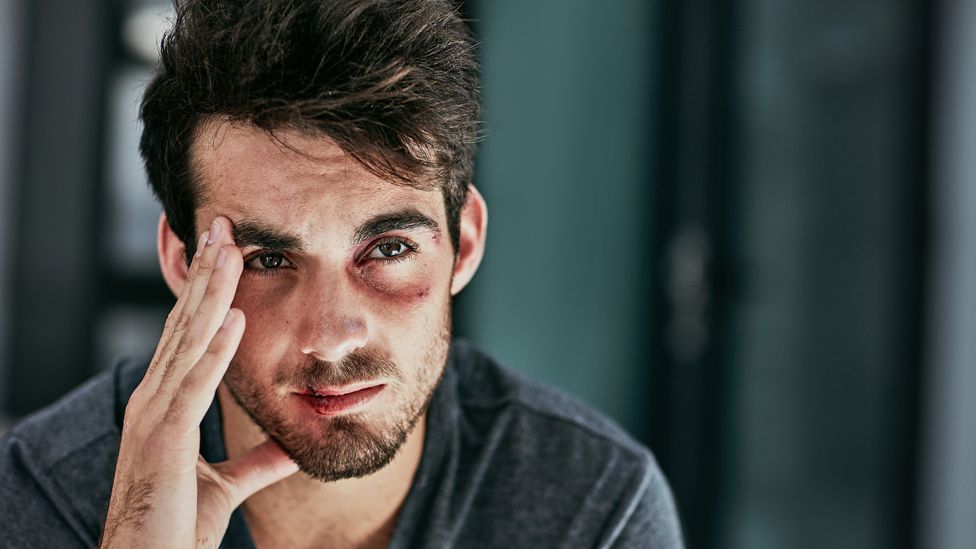
“She would attack me in the middle of the night when I was sleeping – punching me in the head, punching me in the face.”
John is one of a growing number of male victims of domestic abuse who have turned to a Welsh charity for help.
Calan said it had seen a significant increase in people coming forward.
It wants funding secured to continue what it believes is the first UK scheme of its type – to tailor support specifically to men.
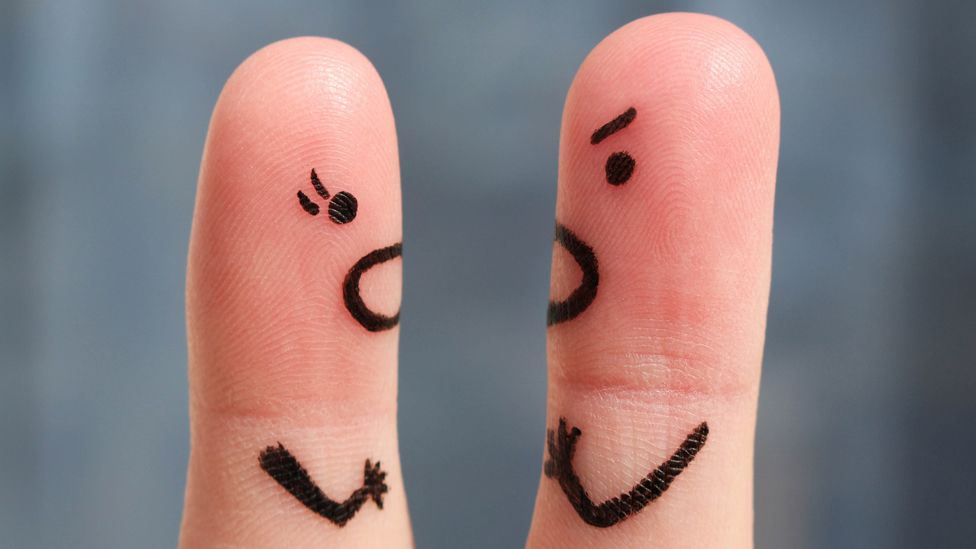

John’s story
John eventually turned to Calan when he felt he was “better off dead”. He broke down when he first explained his situation to a counsellor.
“She was always jealous of other women being attracted to me,” he said of his partner.
“She would be nasty to me for days. Then it went to the stage where she was nasty to me all the time, there was no let up at all.
“I couldn’t do anything other than try and hold her off. It was very difficult, you are judged by people like the police as if you were the one who was causing everything.
“They don’t understand men are getting abused, though I think they’re starting to.
“I said ‘I feel terrible talking about my partner, I feel like I’m betraying her’. She’s left me broke and she’s broken me as well.
“All I had at Christmas was £10 to live on, but I’ve been learning to live on soup and bread.”

Calan, based in Llandarcy, has worked with academics at the University of South Wales (USW) to develop the Compass programme, which supports men to see themselves as victims, challenging gender stereotypes.
Michael Dix-Williams, project manager, said: “There’s very much a belief that domestic abuse only happens to women, and that prevents men coming forward.
“It feeds into this fear they’re not going to be believed.”
The most recent Crime Survey for England and Wales estimated that 1.3 million women and 695,000 men experienced domestic abuse in the last year.
Calan deals with a caseload of more than 20 male victims at any one time, from south and west Wales.
Another victim, Dave, said he was made to feel “useless” because he was unemployed and his children were used as a “tool” with threats to leave.
“One time she punched me – and I pushed her off me, she ran to the telephone and called the police.
“Apparently her friend had told her ‘if you want to get rid of your husband start a fight, call the police and they’ll throw him out of the house’. So that’s what she did.”
‘Appearing unmanly’
Compass is currently being piloted with the aim of a wider roll-out later this year.
Dr Sarah Wallace, from USW, said there were numerous reasons why domestic violence and abuse (DVA) was not reported, by both men and women, including a fear of retaliation or a lack of trust or confidence in the police.
“However, the issue of under-reporting is even more pronounced amongst men,” she said. “They fear appearing unmanly, shame, embarrassment, and a failure to live up to masculine ideals.
“This was the experience of the men we interviewed, who felt that they needed help to get to the root of these feelings.”
Sessions for men are shorter, but also include a focus on the role of masculinity and gender stereotypes, and help validate their experience, recognising that they too can be victims of abuse.
Mr Dix-Williams said the funding runs out soon, and financial security was essential if this were to continue.
“We know that DVA against men is a seriously underreported crime, and we know that 713,000 men were reported to have been a victim of one or more types of DVA.
“It begs the question how many more men are actually out there that are suffering in silence.”
- Victims of domestic abuse can contact Calan or the Live Fear Free helpline 0808 801 0800
Berlinah Wallace: Woman who threw sulphuric acid at boyfriend is cleared of murder
Scorned lover found guilty of throwing corrosive substance in attack that left ex-partner with injuries so severe he chose to end his life Posted March 19th 2021
Tom Barnes@thomas_barnesThursday 17 May 2018 14:02 comments
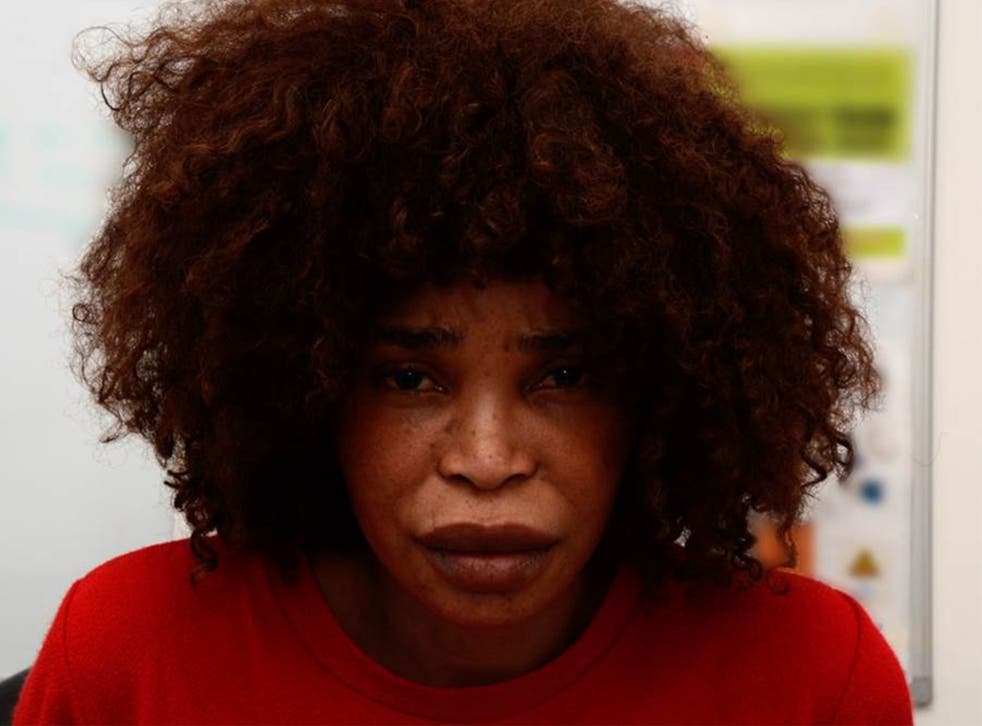
An acid attacker whose ex-boyfriend ended his life with euthanasia because of the debilitating injuries he suffered after she threw the toxic substance at him, has been acquitted of murder.
Berlinah Wallace meticulously researched the effects of sulphuric acid before purchasing a bottle and throwing it over former lover Mark van Dongen as he slept in September 2015, Bristol Crown Court heard.
The 48-year-old, described as controlling, jealous and vindictive, attacked the engineer at her flat in Bristol after he left her for another woman, the jury was told.
Mr van Dongen lost the sight in his left eye, had his lower left leg amputated and was paralysed from the neck down.
The 29-year-old spent more than a year in hospital receiving treatment for his injuries before he was discharged to a residential care home.
He later contacted his father, Cornelius, begging to travel to Belgium, where he ended his life through euthanasia in January 2017.
Following more than 15 hours of deliberations, a jury of 10 men and two women unanimously acquitted Wallace of Mr van Dongen’s murder or manslaughter.
However, they did find her guilty of throwing a corrosive substance with intent.
Jurors were told the attack had been the culmination of a campaign of domestic abuse Dutch-born Mr van Dongen had suffered at the hands of his ex, which included silent phone calls and threats of blackmail.
Wallace poured the sulphuric acid into a glass and then threw it over her sleeping victim, causing her him to scream in agony and run out into the street.✕
Witnesses to the immediate aftermath of the attack described Mr van Dongen’s cries of anguish to the court.
“His face was grey. One of the legs of his boxer shorts seemed to be ripped. He had what looked like black paint on him,” Dominic Wooding said. “He was screaming and pacing and being incoherent.”
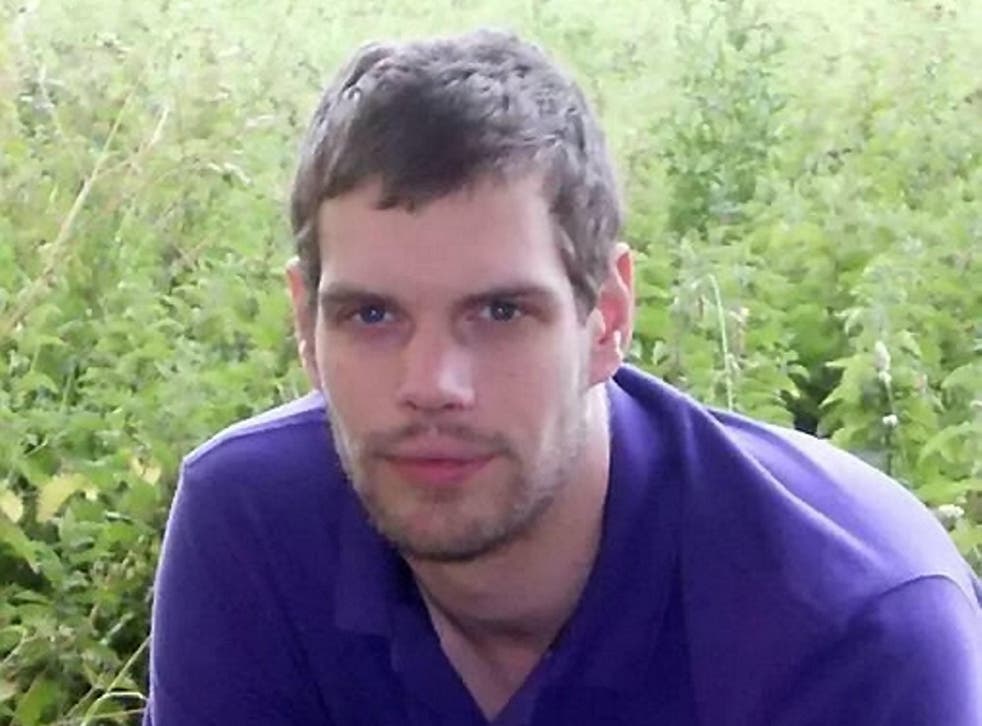
Paramedic Dean Carter said he arrived at the scene to find Mr van Dongen with “significant chemical burns and his face, abdomen, chest and thighs”.
He said he was “frothing at the mouth” and kept saying he could not see, asking at one point if he still had eyelids.
The injuries Mr van Dongen suffered meant he was not fit to be interviewed by detectives for eight months after the attack.
When he was finally well enough to speak to officers, he told them how South African national Wallace had laughed as she threw the acid over him.
During interviews with police, Wallace claimed it was her boyfriend who had poured the liquid into the glass, stating it was water before urging her to drink it.
However, investigations of her computer found the sulphuric acid has been purchased online for £17.07 using her Amazon account.
Investigators also found dozens of web searches Wallace had cleared from her browsing history, in which she had carried out research into victims of acid attacks.
“Mark van Dongen suffered the most inconceivable pain imaginable following what was a cowardly attack borne out of jealousy,” said DI Paul Catton of Avon and Somerset Constabulary following the verdict. “He went from being a healthy young man with his whole life ahead of him to having extensive and repeated surgery on the most hideous injuries just to keep him alive.
“In the end, his pain was so devastating, so catastrophic, he sought the assistance of doctors to help him die. While the jury has concluded Wallace’s actions did not amount to murder, we felt it was the right thing to do to ask them to consider the charge based on the evidence. Wallace is undoubtedly a manipulative individual who abused Mark throughout their relationship.”
She will be sentenced at a later date.
Comment Research shows that men are as likely to be physically and verbally attacked by partners or ex partners. My ex wife used to say :’ Sarcasm is the lowest form of wit and a lady’s privilege.’ The feminist dominated media and polity do not want to know, arguing that men ask for it even though research suggests that women provoke the majority of domestic arguments – women are the dominant and often only parent.
An average of 17 men are killed by women every year. Men are five times more likely to be attacked on the street. Historically BAME are predominant in muggings and in killing fellow BAME. The above appalling case was not used to condemn all women as abusers or all men as victims because there is a hidden agenda. The woman in this case prefaced her vicious life destroying attack with the words ‘If I can’t have you no one will.’
On the subject of Sarah Everard , there is a myth going around from feminists which says ‘She was doing what she was supposed to do , taking the shortest route home. ‘ This is feminist nonsense. She was visiting another non family household way beyond the permitted exercise time , and distance, not on an essential journey and travelling late at night. Women are always claiming special privileges and excuses whilst pretending their aims are simple equality. Very soon it will be a hate crime to criticise feminism. R.J Cook
The future of feminism is in good hands Laura Bates Guardian Women’s Blog – Extract Posted March 19th 2021
Reactions from teenage girls have been overwhelming. They’ve set up feminist societies, written articles in school newspapers, and started campaigns on everything from Everyday Sexism to FGM. After I speak at schools they email me with lists of the harassment and assault they’ve experienced. Sometimes only one or two girls will admit to being feminists. Often they face sexist jibes and taunts about “feminazis”. But they still speak up. Their courage is inspiring.
These are not women’s issues, they’re human rights issues
One of the nicest surprises has been the compassionate responses from men. Many described their own experiences (like being ridiculed in the office for asking for parental leave). Others said their eyes had been opened, and shared their strategies for challenging sexism (from protesting about sexist chants at their local football club to lifting their own T-shirts when a woman in the street was told to “get your tits out”). It’s not about men against women, but people against prejudice.
Men need to stop trying to be our allies and just listen this time Posted March 19th 2021
Finn McRedmond: Fear of male violence did not begin with tragedy of Sarah Everard’s murder
Thu, Mar 18, 2021, 01:00 Updated: Thu, Mar 18, 2021, 09:08 Finn McRedmond 206 
We know that what happened to Sarah Everard is profoundly rare. But of course that is not the point. Photograph: Tolga Akmen/AFP
I live in London, in fact I used to live just around the corner from Poynders Road, where Sarah Everard was last seen alive. And as you might expect of a 25-year-old woman who lives in London, many of my friends are also young women, some of whom still live just around the corner from Poynders Road.
© 2021 THE IRISH TIMES
If the news refuses to call it what it is, then I will. I will fight back against stereotypes that Asians — and Asian women in particular — are subservient and quiet. I will fight back and call it by its name: The shootings were racist and demonstrated, in horrifying reality, what misogyny and the fetishization of East Asian women can become.
By Rachel Priest
March 19, 2021
I cannot even begin to express my deep sorrow at the shooting that left Delaina Ashley Yaun, Paul Andre Michels, Xiaojie Tan, and Daoyou Feng, along with four other women whose names have yet to be officially released, dead in Atlanta this past Tuesday. Six of them were Asian women like myself. I am horrified, I am hurting, I am grieving.
When the first New York Times notification about the shooting came across my screen, I was just sitting down for dinner. It was one of the rare evenings that my busy work schedule and my roommate’s busy grad school schedule let us meet in the kitchen.
“8 people dead in Atlanta shootings,” I read out loud. Both of us — weary and worn from the rise in anti-Asian violence against people who look like us — spent a moment reading it before moving on to other more mundane topics.
It wasn’t that we didn’t care. We were exhausted, disheartened, so tired of more than a year’s worth of racist rhetoric surrounding the coronavirus pandemic that we just couldn’t bear to delve into the story and our complicated feelings after a long day.
My roommate – who is Vietnamese – and I, a Chinese woman, have had a lot of conversations regarding race in the seven months we’ve been roommates in Atlanta. Sometimes, we try to make light of the racist incidents we’ve faced. Other times, we let grief, hurt, and anger into our conversations about how the Vietnam War impacted her family and about the identity reckoning I’ve had as a transracial adoptee.
Later that night, as I was scrolling through Twitter, reading and watching as the reports shifted, the wall of grief I’d been holding back hit me and tears sprung to my eyes. A year’s worth of reporting and crying and seeing my community abused, assaulted, and killed came to the surface. I texted two of my closest friends about the news, and then I called my parents close to midnight.
“Are you scared?” my mom asked.
I was silent for a second, trying to gather all of my tumbling emotions into a coherent sentence.
“No … not in the same way as other Asian Americans have been. But this shooting is a lot closer to home,” I said.
In some ways, I’ve been able to distance myself a little bit from the violence happening to elderly Asian people because, unlike many of my Asian peers, my parents are white. I was adopted from China when I was a year old, and so I haven’t had to worry in the same ways other Asian Americans have had to about the safety of my parents and grandparents.
I took a few more breaths and continued, pushing words past lips trembling with frustration and despair. “It made me realize that I could be walking around my city and any 21-year-old white man with a gun could shoot me because of what I look like.”
Only hours before the shootings, Stop AAPI Hate released a report detailing 3,800 reported incidents of anti-Asian violence, with a disproportionate number of those being directed at Asian women.
The next morning, I woke up exhausted after a short night of dreaming about our nightmarish reality. I braced myself as I reached over to turn off my alarm, knowing that once I turned on my phone, I would be inundated with more news of the shooting.
The Atlanta Journal-Constitution’s front page declared that eight people were shot dead at three massage parlors. Underneath, in smaller but still large text, the paper declared: “Investigators working to determine why victims were targeted.” Later that day, the Cherokee County police department said the shooter confessed to the murders and said he had a sexual addiction. The spas and massage parlors he targeted represented the “temptation he wanted to eliminate.”
My blood hit a boiling point when I read that law enforcement placed the shooter, not the people whose lives he stole, at the center of the narrative. “He was fed up, at the end of his rope … yesterday was a really bad day for him and this is what he did,” said Capt. Jay Baker, a spokesperson for the Cherokee County Sheriff’s Office.
If the news (and the AJC isn’t alone) refuses to call it what it is, then I will. I will fight back against my journalism training that tells me to remain unbiased and stick to the facts, reminding myself I’m an Asian woman before I’m anything else. I will fight back against years of colorblind conditioning that told me bringing race into every conversation is racist. I will fight back against the continuously perpetuated stereotypes that Asians — and Asian women in particular — are subservient and quiet. I will fight back and call it by its name: The shootings were racist and demonstrated, in horrifying reality, what misogyny and the fetishization of East Asian women can become.
Last year, right before the pandemic shut down the country, my best friend and I took a trip to Nashville, Tennessee, for our senior year spring break trip, and I got the tiniest glimpse of what it’s like to be sought out because of my ethnicity.
On the last night we were there, we went to a bar on Music Row. About an hour after we arrived, an older white man came up to me and asked where I was from. After hearing me say, five times,“I’m from Georgia,” he thought for a second and switched tactics. “What’s your nationality?”
“I’m American,” I said again and again and again.
Exasperated, he leaned in too close and shouted: “No, no, I mean I’m English, I’m Irish, I’m white. What are you?”
I’d like to say that I walked away, that I told him to leave me alone — in possibly stronger language — but I didn’t. I stood there in utter embarrassment, disgust, and fear as he offered to buy me a drink and told me about his role as a “cool dad” who often talked to his two school-aged children about drugs and alcohol. This was a white man who was much bigger than I was. He also came to the bar with two other huge men who I had seen cornering others, even remarking to my friend that they were hunting for women. Sensing we might be in over our heads, my friend texted my mom who, on vacation with my brothers and dad, FaceTimed me.
“I’ve got to go, my mom is calling me,” I said and turned away before he could respond. I hid in the bathroom while my friend paid our tab and we sprinted for the exit.
The fetishization of Asian women cannot be ignored when we talk about this shooting, and we need to hold people, news organizations, and Hollywood accountable for the ways in which they talk to and about Asian women.
While it’d be easy to point fingers and say the blame for the rise in anti-Asian hate crimes lay entirely at the feet of those who insist — including former President Donald Trump — on calling the coronavirus names like “China virus” and “Kung flu,” this country has always treated people of Asian descent, regardless of their ethnicity, with contempt.
One of the few things I learned about Asian people in any history class (a problem in itself) was that Chinese immigrants were lured to California by gold and later a promise of freedom for their labor in building the Transcontinental Railroad in the 1860s. In a move rooted in scapegoating and racism, the United States banned Chinese immigration with the Chinese Exclusion Act in 1882. What I didn’t learn, however, was that American-born descendants of the Chinese immigrants already living in the U.S. weren’t allowed to become citizens until 1943 with the passage of the Magnuson Act (which also lifted the ban on Chinese immigration after 65 years.) I also was never taught about the Page Act of 1875, which banned “any subject of China, Japan, or any Oriental country” from immigrating to the U.S on the belief they were here for “lewd and immoral purposes.”
We can’t forget the thousands of Japanese Americans and others of Japanese descent who were placed in concentration camps during World War II. Nor can we ignore the destruction and death this country brought upon millions of Vietnamese people who would later flee to America for a chance at freedom — like my roommate and her family — only to be met with prejudice and racism. Nor can we ignore the other Asian communities in the country who have been harmed by xenophobia.
My good friend and fellow journalist Katie Kim, who is Korean, spoke to our collective trauma and deep hurt when she wrote on Twitter:
“On Feb. 14, 2020, I became a U.S. citizen. I did it because my parents brought me here to achieve the ‘American Dream.’ I did it because they wanted to see me succeed. I did it because I wanted to make them proud. And when I got my certificate, I *was proud. For a moment. But I am anything but proud today. What is the point of the ‘American Dream’ when America is shooting down people who look like my mom, my dad, my aunts, and my uncles? What did my parents bring me here for? What were all those 12-hour minimum-wage shifts for? What were all those days they had to stick me in daycare so I could pretend like I was any other white kid while their hands grew calluses and their hair turned gray for? I am tired. I am terrified. I feel invisible, yet I am hurting.”
While this has been the worst anti-Asian crime in recent history in terms of body count, other incidents are no less egregious and terrifying for the AAPI (Asian American and Pacific Islander) community. In Houston, Texas, Mike Nguyen’s ramen shop was graffitied with the words “hope u dies” and “Go Back 2 China” and “Kung Flu.” In Oakland, California, Pak Ho, a 75-year-old Asian man, recently died from injuries he sustained from hitting his head on the ground after being punched. In the neighborhood of Queens in New York City, a woman was spit on three times while holding her baby, as the words “Chinese virus!” were hurled at her. And now Atlanta — the place I am proud to call home — joins the list.
What happens when your home no longer feels safe? When questions about where you’re from are not just casually racist, microaggressions rooted in ignorance, but carry suspicion and danger? When every glance your way makes you feel studied, evaluated, sized up, hated?
Another friend from college, who is also Chinese, invited me to her socially-distanced picnic birthday party this weekend. Not only did it feel like the safest way to gather but the nicest — soaking up the predicted sunny rays of the weekend forecast. But at 1:30 a.m on Wednesday, when I should’ve been getting caught up on sleep after a hectic work week, I lay there wondering if it would be smart for us to even go. I wondered if sitting out in public would put a target on our backs.
But then I gently reminded myself to reject the fear, to not let one man’s actions be the reason I don’t get to celebrate my friend and enjoy the weather.
There’s a popular media trope of “giving voice to the voiceless.” But it’s important to remember we are not voiceless, we are not invisible. In fact, we’ve been speaking up, rallying, reporting hate crimes, and advocating for ourselves for the past year and beyond, but only recently has the national – media shifted to cover the issue of anti-Asian racism..
So what can non-Asian people do now and in the future?
It starts at the most basic level: treating others with empathy and love and calling out racism when you see it. Check in with your Asian friends, family members, co-workers, and neighbors to let them know you care. (And by check in, I don’t mean reach out to that one Asian person you knew a while ago but haven’t spoken to in years.) And then, it’s time to roll up your sleeves and lean in and learn.
And finally, to my fellow Asian American brothers and sisters, I see you; I support you; I stand with you. We will get through this and, together, we will be a part of a better South and a better nation.
This list is filled with educational resources, organizations to donate to, and places to safely volunteer. The Bitter Southerner has also decided to partner with Asian Americans Advancing Justice. Every time you buy an Abide No Hatred T-shirt, $10 will go toward our Better South Initiative, a fund that puts money into the pockets of organizations, including AAAJ, that work on the front lines of issues facing the South.
We will update the story with the names of the other four women once they are officially released.
Rachel Priest is the content editor at The Bitter Southerner. She grew up in Minnesota but moved to Georgia in high school, where she continued her education at the University of Georgia. She is passionate about amplifying adoptee and Asian voices, traveling, and a good cup of coffee. You can find her work published on Rewire and at rzpriest.com. Follow her on Twitter @rz_priest.
Melissa Gira Grant/March 15, 2021
Sarah Everard and the Useless Generality of “Male Violence” Posted March 19th 2021
What is lost when we fail to name Everard’s alleged killer as a cop?
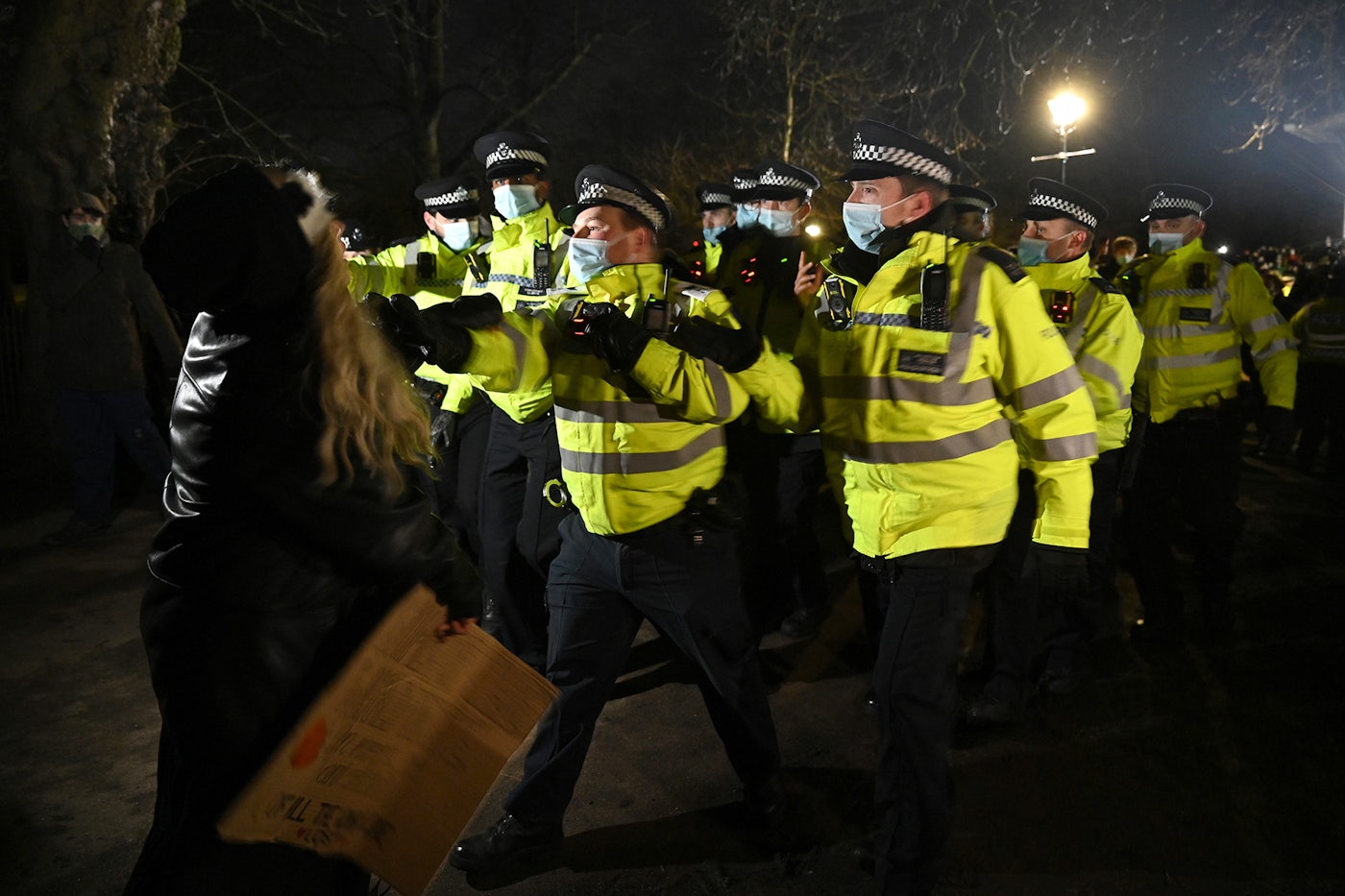 Leon Neal/Getty ImagesPolice officers arrest a woman during a vigil on London’s Clapham Common, where floral tributes have been placed for Sarah Everard, on March 13. Metropolitan Police Officer Wayne Couzens has been charged with her kidnap and murder.
Leon Neal/Getty ImagesPolice officers arrest a woman during a vigil on London’s Clapham Common, where floral tributes have been placed for Sarah Everard, on March 13. Metropolitan Police Officer Wayne Couzens has been charged with her kidnap and murder.
Sarah Everard, to hear her story told for her now, was killed “after doing everything she was supposed to do. She took a longer route that was well-lit and populated. She wore bright clothes and shoes she could run in. She checked in with her boyfriend to let him know when she was leaving. But that was not enough to save her life.” Something sinister, yet only gestured at, is responsible, “an epidemic of male violence against us, most of which takes place behind closed doors, often by men already known to the police.” In the case of Everard, the man was known to police because he was the police. How is the name “Wayne Couzens” not in the opening lines of every story about the killing of Sarah Everard and the movement against gender-based violence now gathering in her name?
Couzens is the man charged with kidnapping and murdering Everard in March. He is a London police officer. To not name him and the systems of violence that enable men like Couzens is to do their work for them. It’s as if it was almost acceptable for women to rise up against men who kill women, so long as we didn’t say it was allegedly a cop who did the killing. So when the same police force that employed the accused murderer shut down a vigil and protest for Sarah Everard over the weekend, its abuse of power should have come as no great shock.
What women are protesting is not only male violence—it is police violence. “We gathered at Clapham Common,” reads a statement by the group Sisters Uncut, “because of our grief and anger at the senseless murder of Sarah Everard. We gathered because after Sarah’s disappearance, the police told women that they should stay at home after dark to avoid being attacked.” Police reportedly went door to door after Everard’s disappearance, offering protection in the form of a curfew, which is another way to make women disappear. If that’s the best the law can do, then the law cannot be relied upon to keep women safe. To be safe may also require going outside the law. “[W]e demand the right not only to survive but to thrive. And that means going where we want, when we want,” the Sisters Uncut statement continues. “Many of us know that surviving and thriving means disobeying orders, and that’s why so many of us are here tonight.”Get independent, fact-based journalism:
3 months for $5Subscribe
Groups like Sisters Uncut see the links between gender-based violence and police violence; their protest connected the killing of Sarah Everard with a proposed bill expanding police powers, including the power to crack down on protests, currently under consideration in Parliament. A mourning chant at a protest on Sunday, which had kicked off at Scotland Yard, named women killed by police: “Rest in peace to Sarah Everard, to Breonna Taylor, to Shukri Abdi, to Black trans women who have been murdered, to all women, trans people, gender-nonconforming people, and all those killed by police violence.”
This was after police had aggressively arrested women protesting the day before, after police had obstructed gatherings planned in multiple cities. Police claimed it was for women’s own safety during a pandemic. The group that organized those gatherings, Reclaim These Streets, tried to challenge them in court. “We’re protesting against violence against women, and we’re being shut down by the police,” a Reclaim These Streets organizer told The New York Times. “I’m baffled.” Ultimately they, too, asked women to stay at home. Of course, many hundreds did not. One whose arrest photograph spread quickly over social media was quoted as saying she “accidentally went viral,” that she’s “been thrown into the public eye and the only way that I can make this not in vain is to not make it political, not make it against the police or against anyone. It literally is just about the safety of women.” Despite all this, including that photo of the flame-red-haired woman pressed to the ground by Met officers, some are calling for tougher laws against gender-based violence in response to the murder of Sarah Everard. Those who oppose enhanced state power on the grounds that such laws do not protect women are being told they are not doing enough to protect women themselves.
Let’s be very clear about these events: Sarah Everard is found dead. A police officer is charged with murdering her. Women organize to get out in the streets in Everard’s name. Police try to shut the women down. Women turn out anyway. Officers brutalize some of the women. But what we’re supposed to believe the alleged murder of Sarah Everard is about is women at risk and “male violence,” reduced to something almost essential, devoid of specificity or context or politics. We’re supposed to accept that the solution is that police need more power in order to protect women from this “male violence.”
To try to look at these as distinct problems—male violence and police violence—lets police evade culpability, even as they meet women protesting violence with violence. It assists members of law enforcement in perpetuating this evasion, as former detective superintendent of Scotland Yard Shabnam Chaudhri attempted, when she said, “This wasn’t Black Lives Matter, this is a sensitive issue, where a woman has been murdered, tragically, and it’s raised the alarm and it’s ignited a movement from thousands and thousands of women across the globe.” (A clip of this was circulated and criticized on Twitter, after which Chaudhri responded, “I am sorry, the point I was trying to make was not articulated well, on reflection I shouldn’t have made the comparison I am well aware of the importance of the BLM, for that I apologise.”)
She could have been describing the movement that grew after the death of Breonna Taylor, who police killed in a raid on her home in Louisville, Kentucky, exactly one year before the protests for Sarah Everard. While lawmakers in London consider a bill expanding police powers to shut down protests, Kentucky legislators are advancing a bill that would criminalize protests by enhancing penalties, and which would also make it a misdemeanor if someone “accosts, insults, taunts, or challenges a law enforcement officer with offensive or derisive words, or by gestures or other physical contact, that would have a direct tendency to provoke a violent response from the perspective of a reasonable and prudent person.” After a year of protests and demands for police killings to end, it is a retaliatory move, as was the crackdown in London last weekend. Get independent, fact-based journalism:
3 months for $5Subscribe
By splitting “police violence” off from “male violence,” you will get claims like the one made by the former Scotland Yard detective that Black Lives Matter, a movement against police violence and in defense of Black lives, is not also a movement against violence against women. This frame acts as if police committing this violence are not also often “men” and as if the “women” in “violence against women” cannot be Black. Such misogynistic, racist excuse-making in reaction to police violence against women protesters is also a threat: If women protest “male violence,” maybe we’ll protect you; if you protest police violence, we will not only withhold that protection, but if we are violent toward you, we will tell the public you had it coming. It’s a threat that, in this case, was also made by a woman, while a woman is currently the commissioner of the Metropolitan Police, and now is facing pressure to resign.
Consider the outpouring of stories about street harassment—and all the semi-useless things women are expected to do when out walking alone at night; the ensuing appeals to place the burden for keeping women safe on men. “To those who insist on seeing Everard’s death exclusively through the lens of a gender war, I want to say: fear and rage can be an entry point into the rejection of violence against women but not the termination or sum of our collaborations,” wrote Charlotte Shane. “We’ll find no empowerment in petitioning for the protection or mercy of men, neither of which we have a good track record of procuring anyway, and it’s frankly embarrassing that these conversations so assiduously avoid the possibility of defending ourselves.” To refuse to separate police violence from male violence is only a partial corrective when gender alone can only explain so much about Sarah Everard’s murder, when it may even limit what forms resistance might take.
Male violence as a descriptor perhaps obscures more than it can expose. Call it patriarchal violence, or the violence of white supremacy—police violence is both. But is a protest against “male violence” already a protest against police violence? It could be. So long as police are still delegated the power to “protect” women, even when they abuse that power, it must be.Melissa Gira Grant @melissagira
Melissa Gira Grant is a staff writer at The New Republic and the author of Playing the Whore: The Work of Sex Work.
U.K Femicide Census Posted March 18th 2021
The Femicide Census report published today (20.02.20) on UK femicides in 2018 finds men who have already killed women are killing again – three men had already killed women before – and over half of perpetrators (52%) had a history of violence to women. The report, published by Women’s Aid and Co-Founded by Karen Ingala-Smith also shows:
- 149 women killed by 147 men in the UK in 2018
- 91 women (61%) were killed by their current or former partner
- 58 women (39%) were killed by men who were not or had never been intimate partners, including:
- 12 women (8%) were killed by sons or step-sons; a further 5 women (3%) were killed by a son-in-law or ex son-in-law
- 6 women (4%) were killed by a social acquaintance
- 6 women (4%) were killed by other acquaintances
- 6 women (4%) were killed by a neighbour or housemate
- 2 women were killed on their first contact with a sexually motivated killer
- 2 women were killed in the context of prostitution
- Only 6% of femicides (9 victims) were committed by a stranger or where there was no known relationship between the victim and the perpetrator, 3 women were killed in the context of robberies/burglaries
- 41% (37 of 91) of women killed by a partner/former partner had separated or taken steps to separate from him with 30% of them (11/37) killed within the first month and 70% (24/37) killed within the first year post separation
- 102 femicides (68%) took place in the woman’s house – which may (35%) or may not (33%) have been shared with the perpetrator
- 23 women (15%) were over 66-years-old when they were killed
- 16 men (11%) who killed women were known to use prostitution and pornography, including one man who accessed images of child sexual abuse
- Overkilling was evident in 56% of cases
- 52% of perpetrators had previous histories of violence against the victim or other women
- 3 men had previously killed a woman.
The report highlights that in over half the cases (52%) the perpetrator had previously been violent to women and that as many as 61% of the killings were committed by a current or former partner.
As in previous years most women were killed by men using a sharp instrument, followed by strangulation or asphyxiation and then by the use of a blunt instrument. In 68% of cases the killings took place in or immediately around (garage/garden) the woman’s home. This may be her own home or a home shared with the perpetrator and includes not only private houses but sheltered housing, mixed hostels or care facilities.
Overkilling was again prevalent this year in as many as 56% of cases. Overkilling is defined as the use of excessive, gratuitous violence beyond that necessary to cause the victim’s death. It may involve using more than one method of killing or it may involve one method but multiply repeated.
The report highlights that media coverage of such cases often describes them as “frenzied” and as the result of “a loss of control”. However, killing women is the act of ultimate control rather than a loss of control. In one femicide the post mortem carried out on the victim established that most of the 70+ stab sounds inflicted were very shallow and in fact indicated a remarkably high degree of control. Similarly, some cases are described as suicide pacts/murder suicides and some cases involving older couples or a son killing an elderly mother are sometimes portrayed as mercy killings or being unable to cope with caring responsibilities or witnessing suffering. Yet this picture is undermined given that overkilling is often still present with, for instance, the victim dying of multiple injuries from a blunt instrument, or a knife, or in one case, the victim being thrown off a balcony to her death.
Karen Ingala Smith, Co-founder of The Femicide Census, said “There is a high degree of normalisation of men’s violence against women and no end of excuses or rationales assumed and extended to perpetrators often without foundation. We urge media to be more professionally curious and to situate such killings in current research and in the context of what we know about the history of the relationship. For instance, robustly challenging the narratives that killers lay out in court, asking whether, in a so-called mercy killing or suicide pact, there has been a history of controlling behaviour or violence towards her.”
“In 52% of femicides in 2018, there was evidence of some sort, often from things victims had said to friends or families even if not actually in reports to police, to suggest a previous history of his violence and controlling behaviour towards her. In too many cases there was also evidence of his having a history of violence towards other women with 3 perpetrators having even previously killed another woman. Women are reaching out for help and many men are known to be dangerous to women but we don’t seem to be turning this knowledge into ways to save women’s lives”
“It is important to honour the names and lives of the women killed but it is galling to have to report such a catalogue of violence and abuse year after year. Every year we make recommendations and every Domestic Homicide Review points out lessons to be learned – yet they seem to go unheeded.”
“It’s also important that we challenge received wisdom about seeing leaving a violent relationship being a straightforward way that women can remove themselves from the danger of a violent partner. 41% of women killed by someone who was, or had been, an intimate partner had left him already or were taking steps to separate from him, with 30% of these women killed within the first month and 70% killed within the first year post separation.”
“For every woman killed there are thousands of women living in violent, controlling and abusive relationships. The closure and under-resourcing of specialist women-only services and refuges and of public services means that even where women may want to leave, they may struggle to find the help, support and safety they need and to which they are entitled. We know how violence against women works, we know what sorts of interventions and support women need, we know the critical role played by sex-inequalities, we have drawn all the lessons and made all the recommendations. We need implementation and the resources that go with that, we need to be making ambitious changes to women’s status in society and men’s entitlement, we need to robustly challenge sex role stereotypes – and we need women to be believed, respected and valued and perpetrators to be held to account.”
The Femicide Census comes a week after the Home Office published statistics on Crime Statistics 2019 which revealed the number of women and girls killed in England and Wales has risen 10% on last year to the highest level since 2006. Our Director wrote a piece in the New Statesman highlighting the need to redesign our response to domestic abuse with women at the centre and accountability rather than invisibility of perpetrators. And that for all of this, we need leaders and champions across every part of public life.
British teenager found guilty of lying about ‘gang rape’ in Cyprus holiday resort Posted March 18th 2021

A British teenager has been found guilty of lying about being gang-raped while on holiday in the Cypriot resort of Ayia Napa, in a case that has raised questions about the island’s treatment of victims of sexual assault.
The 19-year-old Derbyshire woman, whom The Telegraph has chosen not to identify, says she was raped by up to 12 Israeli men in her hotel room in July.
She later retracted the accusation after hours of questioning by police.
The teenager was convicted on Monday of the charge of “public mischief” by Famagusta district court in the nearby town of Paralimni.
In his ruling, Judge Michalis Papathanasiou said the defendant did not tell the truth and tried to deceive the court with “convenient” and “evasive” statements.
“She did not make a good impression on the court,” he said. “She was never clear on what happened. She was not stating the truth and I reject the version she gave.”
He delayed sentencing until January 7, when the woman could be ordered to pay a €1,700 (£1,500) fine and serve up to a year in prison.
The teenager, dressed in black with her blonde hair tied up, sighed in disbelief as the court’s translator relayed Judge Papathanasiou’s decision.
Around 25 protesters from the Network Against Violence Against Women sat in court with gags over their mouths showing an image of stitched-up lips.
As the defendant walked out of court in a blindfold to hide her identity, they shouted: “We are with you. We know. We believe you.”
Comment Women now have a very powerful weapon against men. The myth is that they never lie. That is their biggest lie. They have a lot of political weight behind them and will keep rising until they have total control of society’s interface with the massively wealthy elite who are pushing all the buttons and setting the agenda. Women do not need evidence.
My decision to identify as male to female transsexual after malicious false allegations which police lied about invesitigating – lies that have continued for the last 13 plus years – has everything to do with this. Ultimately it is no solution because I cannot forget my male experience and would not want to be identified with the increaingly large body of women who want to castrate and crucify men.
I will write more of my thoughts on transgender in due course on a a new page called , About Roberta Jane Cook. To do so is a dangerous decision because I do not like the feminist herd or the box called LGBTQI. There are serious questions to be asked about transgender but the only one concerning feminists seems to be about stopping transsexuals getting into women’s toilets and other safe spaces because of an an assertion that all they want to do is rape and beat them up. R.J Cook

Mike Hill: Hartlepool MP quits ‘with immediate effect’ March 16th 2021
Published18 minutes ago
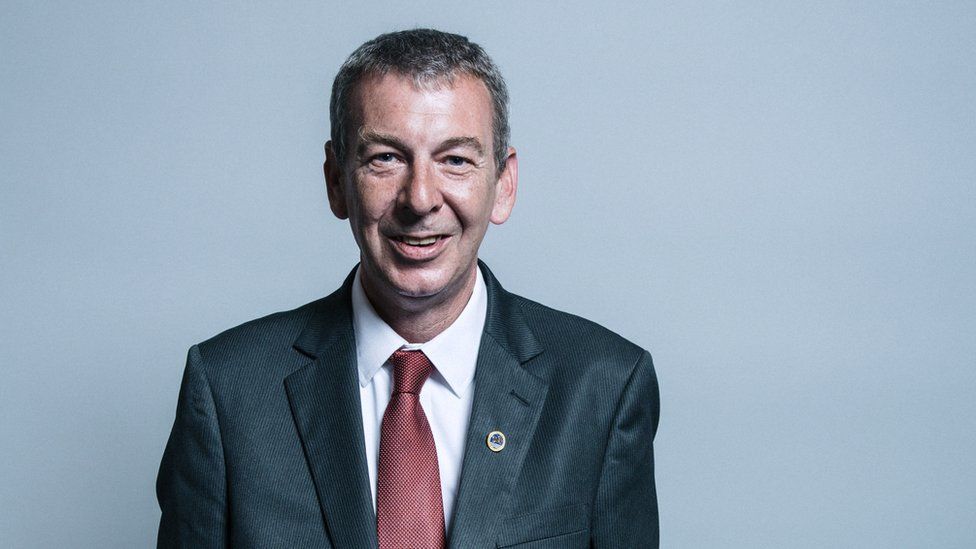
Hartlepool Labour MP Mike Hill has resigned “with immediate effect”, prompting a by-election.
Mr Hill was due to face an employment tribunal later this year into claims of “sexual harassment and victimisation”. He has denied the allegations.
It is understood an investigation into the 57-year-old’s conduct is ongoing.
A spokesperson for the constituency Labour Party said it wanted a candidate in place quickly to “start work on sharing Labour’s positive vision”.
‘Proud of the town’
They added: “Over the past 10 years Hartlepool has been battered by the Tories down in Westminster.
“The local Tories focus on Middlesbrough and Stockton and Hartlepool is left out.
“We want to see new good jobs, the services people need right here, and a thriving town centre when people get back to the shops again.
“We need a Labour MP who will stand up to the Tories after a decade of neglect.”
Mr Hill’s resignation will trigger a by-election in a key former so-called “red wall” constituency, which could be held on 6 May to coincide with local and mayoral elections in England.
Men Beware Strict New Rules For Sexual Relationships March 15th 2021
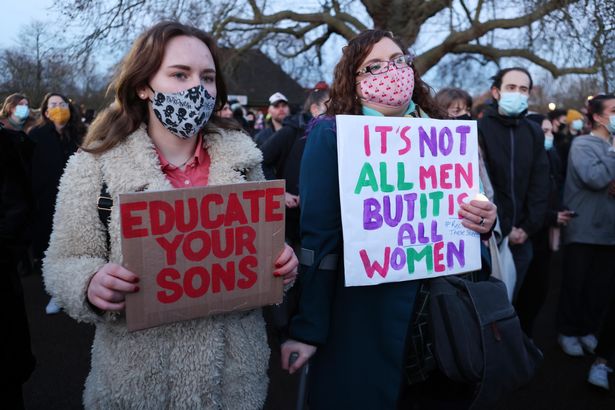
The emphasis is on blaming all men for the wrong attitudes, not psycho specially selected and trained thugs, unaccounatble lying cops. One woman’s poster carried in large letters : ‘Cressida, you are a woman too.’ That says it all about feminists. Women in power are there to look after ‘women’s interests’ and the fight for more power. They want all their mistakes blamed on others. They have the legal right to demand men stop during sex once it has started. They do not have to provide any evidence and there is no statute of limitations on bringing charges.
The premise and mantra is that women never lie. The assumption and mantra is, when a man is found not guilty of sex and violence charges that the female has suffered severe injustice.
Already we have daily adverts for men to take viagra, record numbers of young males from single paren t homes choosing sex change and others choosing to be gay. Nothing is ever a woman’s fault – not even when they have brought up the offending boys after the man has been kicked out and the boyfriend runs away.
They are demanding every aspect of life be made ‘safer ‘ for them. Sex is a matter of balance in the simplest monoculture. In a multi culture, that is impossible to achieve, There is a lot of conflict and trouble ahead. Men need to realise that sexual elationships are very dangerous. Logically there is need for chaperones and life long observers. it isn’t worth a jail sentence when women’s allegations are never questioned. R.J Cook
What is rape and sexual assault?
Rape or sexual assault is a serious crime. Find out more below about rape and sexual assault, what constitutes consent, and some of the common myths around rape, sexual assault and reporting these offences.
Rape and sexual assault
All rape and sexual assault is serious. The terms rape and ‘sexual assault’ are used simply to differentiate between two types of offence. So what’s the difference?
Rape is when a person intentionally penetrates another’s vagina, anus or mouth with a penis, without the other person’s consent. Assault by penetration is when a person penetrates another person’s vagina or anus with any part of the body other than a penis, or by using an object, without the person’s consent.
The overall definition of sexual or indecent assault is an act of physical, psychological and emotional violation in the form of a sexual act, inflicted on someone without their consent. It can involve forcing or manipulating someone to witness or participate in any sexual acts.
Not all cases of sexual assault involve violence, cause physical injury or leave visible marks. Sexual assault can cause severe distress, emotional harm and injuries which can’t be seen – all of which can take a long time to recover from. This is why we use the term ‘assault’, and treat reports just as seriously as those of violent, physical attacks.
Consent
What separates sex, or a gesture of affection, from sexual assault? It’s a matter of consent. That is, both people agreeing to what’s happening by choice, and having the freedom and ability to make that choice. See Consent is Everything and Support for victims of rape and sexual assault for more advice and information.
Common myths about rape
It’s widely thought that in most cases of rape, the offender is a stranger. The truth is the majority of people who commit rape know their victims and, in some cases, are relatives, friends or work colleagues.
Rape within marriage and relationships can also occur. Remember, sex is about consent. If your partner or husband has forced you into having sex with them, this is rape. We treat this as seriously as any other rape or sexual assault.
Find out more about the myths around rape at Rape Crisis.
You are not to blame
Sometimes people are afraid to speak to the police because they were voluntarily taking drugs or drinking alcohol before the offence happened. Sometimes they have little or no recollection of what has happened. They may have a criminal record, and worry that the authorities won’t treat them fairly. They might be worried that no one will believe them.
Remember, no matter who you are, how long ago the assault happened or what took place, our prime concern is to give you the support you need. We’ll listen, understand and guide you through the investigation process at a pace you’re comfortable with, whilst respecting your wishes.
Rape prosecutions: Court of Appeal says change to CPS guidance was not unlawful Posted March 15th 2021
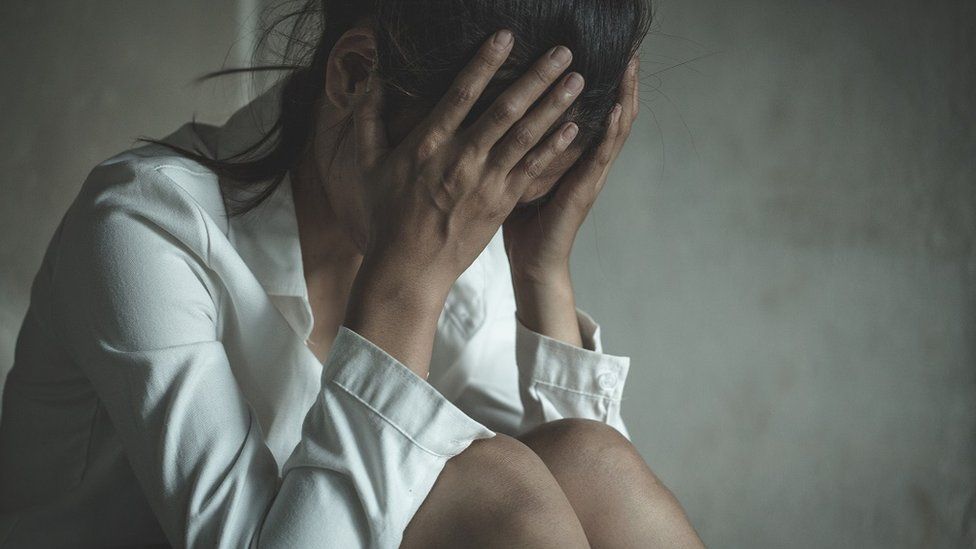
The Court of Appeal has dismissed a legal challenge against the Crown Prosecution Service over its policy on prosecuting serious sexual offences.
End Violence Against Women had said the CPS’s move away from a “merits-based approach” in 2016-18 was “unlawful”.
The group had claimed the change led to a “shocking and unprecedented” fall in rape cases leading to criminal charges.
But the court agreed with the CPS that the change in guidance “was not a change of legal substance”.
End Violence Against Women (EVAW) had been aiming to show there was a change in policy in the way the CPS handled rape cases, and that the way the prosecutors went about that change was unlawful.
During the hearing, the group had said the CPS adopted what is known as the “bookmaker’s approach” to cases, which saw prosecutors considering what may happen based on past experience of similar cases, rather than its earlier “merits-based approach” based on objective assessment of the evidence in that case alone.
Legally binding guidance on the old approach was removed in 2017, and the CPS introduced a 60% conviction rate target in relation to rape cases.
EVAW’s lawyers had argued both the volume of cases and the charging rate fell following this change in guidance.
In 2019/20 fewer than 2,000 rape cases were prosecuted – less than 3% of the more than 55,000 rapes reported to the police.

Bonny’s story: ‘Robbed of justice’
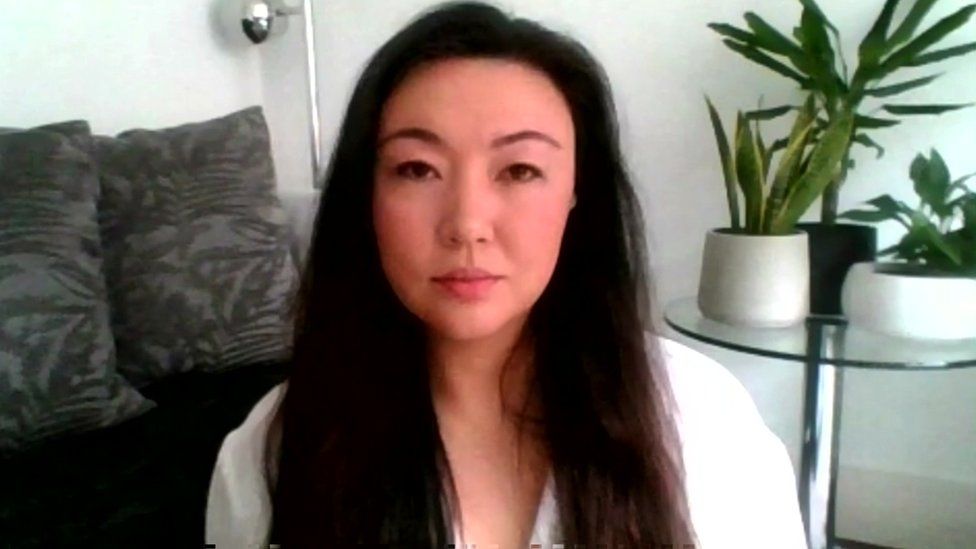
As part of their case against the CPS, End Violence against Women Coalition used Bonny Turner’s experience of reporting rape and prosecutors deciding not to charge the suspect.
Ms Turner, who has waived her right to anonymity, said a man who raped her in 2016 later apologised and voluntarily confessed – but the CPS still chose not to prosecute the suspect.
She believes her case did not get to court partly because the CPS changes in 2017 led to prosecutors dropping cases to “artificially inflate their conviction figures”.
Following the Court of Appeal’s dismissal, she told BBC News: “Right now I’m feeling deeply shocked, angry, devastated really. Today’s judgement, for me, really sends a clear signal to violent men and boys – that they can rape with impunity.”
“Effectively, rape has been decriminalised and the courts have missed this opportunity to put right or to acknowledge the fact that victims of rape like me have been robbed of justice for the last few years,” she said.
Ms Turner has previously spoken about how she was prevented from accessing therapy after being raped, because of restrictions from the judicial system.

The job of the CPS is to decide whether or not someone should be charged with an offence in England and Wales, based on various factors – such as whether there is enough evidence to provide a realistic prospect that the defendant could be convicted. The body is independent of police and the government.
CPS director of public prosecutions Max Hill said the court’s decision confirmed that the CPS “was neither irrational nor unlawful in its approach to updating guidance for prosecutors, and that there was no change of approach in the way the CPS prosecutes rape cases”.
“Today’s outcome means we can now give our full focus to the extensive programme of work under way to address the gap between reported rapes and cases going to court,” he added.
Andrea Simon, End Violence Against Women’s director, said the group was “deeply disappointed” by the dismissal.
She said the court had “given the CPS the benefit of the doubt” and “we still lack alternative answers” to why rape prosecutions have fallen.
“Thousands of rape victims continue to be let down by a broken criminal justice system,” Ms Simon added.
Court of Appeal judges Lord Chief Justice Lord Burnett, Lord Justice Holroyde and Lady Justice Elisabeth Laing found the EVAW’s case failed on every ground.
They said the evidence provided by Mr Hill “comprehensively undermines the grounds advanced by the claimant” and that senior CPS managers were perfectly entitled to apply a “nudge on the tiller” to address concerns about falling conviction rates for rape cases.
Lord Burnett said the judges also rejected a submission that the CPS’s decisions “created any risk of systemic illegality”.
EVAW said it would seek to appeal against the court’s decision.
The group added it would have to pay about £75,000 to cover the CPS’s legal fees, unless the costs were waived.



